
FINAL REPORT
WY-2202F
Wyoming Department of Transportation, State of Wyoming
ENHANCING CRASH DATA REPORTING TO
HIGHWAY SAFETY PARTNERS IN WYOMING BY
UTILIZING BIG DATA ANALYSIS AND SURVEY
TECHNIQUES
By:
Department of Civil & Architectural Engineering
Wyoming Technology Transfer Center
University of Wyoming
1000 E. University Avenue, Dept. 3295
Laramie, Wyoming 82071
March, 2022
i
DISCLAIMER
Notice
This document is disseminated under the sponsorship of the Wyoming Department of Transportation (WYDOT) in
the interest of information exchange. WYDOT assumes no liability for the use of the information contained in this
document.
WYDOT does not endorse products or manufacturers. Trademarks or manufacturers’ names appear in this report
only because they are considered essential to the objective of the document.
Quality Assurance Statement
The Wyoming Department of Transportation (WYDOT) provides high-quality information to serve Government,
industry and the public in a manner that promotes public understanding. Standards and policies are used to ensure
and maximize the quality, objectivity, utility and integrity of its information. WYDOT periodically reviews quality
issues and adjusts its programs and processes to ensure continuous quality improvement.
Copyright
No copyrighted material, except that which falls under the “fair use” clause, may be incorporated into a report
without permission from the copyright owner, if the copyright owner requires such. Prior use of the material in a
WYDOT or governmental publication does not necessarily constitute permission to use it in a later publication.
• Courtesy — Acknowledgment or credit will be given by footnote, bibliographic reference, or a statement
in the text for use of material contributed or assistance provided even when a copyright notice is not
applicable.
• Caveat for Unpublished Work —Some material may be protected under common law or equity even
though no copyright notice is displayed on the material. Credit will be given and permission will be
obtained as appropriate.
• Proprietary Information — To avoid restrictions on the availability of reports, proprietary information
will not be included in reports unless it is critical to the understanding of a report and prior approval is
received from WYDOT. Reports containing such proprietary information will contain a statement on the
Technical Report Documentation Page restricting availability of the report.
Creative Commons:
The report is covered under a Creative Commons, CC-BY-SA license. When drafting an adaptive report or when
using information from this report, ensure you adhere to the following:
• Attribution — You must give appropriate credit, provide a link to the license and indicate if changes were
made. You may do so in any reasonable manner but not in any way that suggests the licensor endorses you
or your use.
• ShareAlike — If you remix, transform or build upon the material, you must distribute your contributions
under the same license as the original.
• No additional restrictions — You may not apply legal terms or technological measures that legally restrict
others from doing anything the license permits.
You do not have to comply with the license for elements of the material in the public domain or where your use is
permitted by an applicable exception or limitation.
No warranties are given. The license may not give you all of the permissions necessary for your intended use. For
example, other rights such as publicity, privacy or moral rights may limit how you use the material.

ii
Technical Report Documentation Page
1. Report No. WY-2202F
2. Governmental Accession No.
3. Recipient’s Catalog No.
4. Title and Subtitle
Enhancing Crash Data Reporting to Highway Safety Partners in
Wyoming by Utilizing Big Data Analysis and Survey Techniques
5. Report Date
March 2022
6. Performing Organization Code
7. Author(s)
Ahmed Farid (0000-0002-5101-3237), Sahima Nazneen (0000-0001-
7424-3089), Khaled Ksaibati (0000-0002-9241-1792), Mohammad
Mahdi Rezapour (0000-0002-722X)
8. Performing Organization Report No.
9. Performing Organization Name and Address
Department of Civil & Architectural Engineering
Wyoming Technology Transfer Center
University of Wyoming
1000 E. University Avenue, Dept. 3295
Laramie, Wyoming 82071
10. Work Unit No. ( )
11. Contract or Grant No. RS02220
12. Sponsoring Agency Name and Address
Wyoming Department of Transportation
5300 Bishop Blvd.
Cheyenne, WY 82009-3340
WYDOT Research Center (307) 777-4182
13. Type of Report and Period Covered
Final Report
14. Sponsoring Agency Code
15. Supplementary Notes
Project Champion: Matt Carlson, P.E., State Highway Safety Engineer
16. Abstract:
Road safety is a crucial topic of transportation engineering. The Wyoming Department of Transportation
(WYDOT) collects such data from police crash reports and roadway inventories. WYDOT also provides those
data to its partner groups in the form of data records or summary statistics documented in periodical reports.
The groups include the Wyoming Seat Belt Coalition, the Wyoming Highway Patrol, the Wyoming Association of
Sheriffs and Chiefs of Police, the Wyoming Transportation Safety Coalition, the Governor’s Council on Impaired
Driving, Wyoming’s counties, the Wyoming Bicycle and Pedestrian System Task Force and motorcycle groups.
In this research, surveys were prepared, distributed to and collected from those groups asking about the quality
of the data they receive from WYDOT, particularly when it comes to data provision frequencies and unreported
data that would be beneficial to those groups. In addition, big data analyses were conducted to evaluate human
factors influencing crash occurrences and data provision frequencies. This research’s efforts culminated in lists
of recommendations to WYDOT regarding the provision of higher quality data at appropriate frequencies to its
partners.
17. Key Words
Crash Data, Road Safety Groups, Surveys, Big Data
Analytics
18. Distribution Statement
This document is available through the National
Transportation Library and the Wyoming State Library.
Copyright © 2020. All rights reserved State of
Wyoming, Wyoming Department of Transportation,
and the University of Wyoming.
19. Security Classif. (of this report)
Unclassified
20. Security Classif. (of this page)
Unclassified
21. No. of Pages
127
22. Price
Form DOT F 1700.7 (8-72) Reproduction of completed page authorized

iii
SI* (MODERN METRIC) CONVERSION FACTORS
APPROXIMATE CONVERSIONS TO SI UNITS
Symbol When You Know Multiply By To Find Symbol
LENGTH
in inches 25.4 millimeters mm
ft feet 0.305 meters m
yd yards 0.914 meters m
mi miles 1.61 kilometers km
AREA
in
2
square inches 645.2 square millimeters mm
2
ft
2
square feet 0.093 square meters m
2
yd
2
square yard 0.836 square meters m
2
ac acres 0.405 hectares ha
mi
2
square miles 2.59 square kilometers km
2
VOLUME
fl oz fluid ounces 29.57 milliliters mL
gal gallons 3.785 liters L
ft
3
cubic feet 0.028 cubic meters m
3
yd
3
cubic yards 0.765 cubic meters m
3
NOTE: volumes greater than 1000 L shall be shown in m
3
MASS
oz ounces 28.35 grams g
lb pounds 0.454 kilograms kg
T short tons (2000 lb) 0.907 megagrams (or "metric ton") Mg (or "t")
TEMPERATURE (exact degrees)
o
F Fahrenheit 5 (F-32)/9 Celsius
o
C
or (F-32)/1.8
ILLUMINATION
fc foot-candles 10.76 lux lx
fl foot-Lamberts 3.426 candela/m
2
cd/m
2
FORCE and PRESSURE or STRESS
lbf poundforce 4.45 newtons N
lbf/in
2
poundforce per square inch 6.89 kilopascals kPa
APPROXIMATE CONVERSIONS FROM SI UNITS
Symbol When You Know Multiply By To Find Symbol
LENGTH
mm millimeters 0.039 inches in
m meters 3.28 feet ft
m meters 1.09 yards yd
km kilometers 0.621 miles mi
AREA
mm
2
square millimeters 0.0016 square inches in
2
m
2
square meters 10.764 square feet ft
2
m
2
square meters 1.195 square yards yd
2
ha hectares 2.47 acres ac
km
2
square kilometers 0.386 square miles mi
2
VOLUME
mL milliliters 0.034 fluid ounces fl oz
L liters 0.264 gallons gal
m
3
cubic meters 35.314 cubic feet ft
3
m
3
cubic meters 1.307 cubic yards yd
3
MASS
g grams 0.035 ounces oz
kg kilograms 2.202 pounds lb
Mg (or "t") megagrams (or "metric ton") 1.103 short tons (2000 lb) T
TEMPERATURE (exact degrees)
o
C Celsius 1.8C+32 Fahrenheit
o
F
ILLUMINATION
lx lux 0.0929 foot-candles fc
cd/m
2
candela/m
2
0.2919 foot-Lamberts fl
FORCE and PRESSURE or STRESS
N newtons 0.225 poundforce lbf
kPa kilopascals 0.145 poundforce per square inch lbf/in
2
iv
TABLE OF CONTENTS
CHAPTER 1: INTRODUCTION ................................................................................................... 1
Objectives ................................................................................................................................... 2
Report Organization .................................................................................................................... 2
CHAPTER 2: BACKGROUND AND LITERATURE REVIEW ................................................. 3
Background ................................................................................................................................. 3
Overview of the Wyoming Department of Transportation’s Safety Partners ......................... 3
Literature Review........................................................................................................................ 5
Wyoming Electronic Crash Reporting System ....................................................................... 5
Human Factors ........................................................................................................................ 6
Assessment of Crash Reporting Systems ................................................................................ 7
CHAPTER 3: DISSEMINATING SURVEYS TO THE WYOMING DEPARTMENT OF
TRANSPORTATION’S SAFETY PARTNERS ............................................................................ 9
Summary of the Wyoming Seat Belt Coalition Survey Responses’ Results .............................. 9
Recommendations for the Wyoming Department of Transportation Regarding the Wyoming
Seat Belt Coalition .................................................................................................................... 13
Summary of the Wyoming Highway Patrol Survey Responses’ Results ................................. 29
Summary of the Wyoming Association of Sheriffs and Chiefs of Police Survey Responses’
Results ....................................................................................................................................... 34
Recommendations for the Wyoming Department of Transportation Regarding the Wyoming
Highway Patrol and the Wyoming Association of Sheriffs and Chiefs of Police .................... 37
Summary of the Wyoming Transportation Safety Coalition Survey Responses’ Results ........ 61
Recommendations for the Wyoming Department of Transportation Regarding the Wyoming
Transportation Safety Coalition ................................................................................................ 64
Summary of the Governor’s Council on Impaired Driving Survey Responses’ Results .......... 71
Recommendations for the Wyoming Department of Transportation Regarding the Governor’s
Council on Impaired Driving .................................................................................................... 75
Summary of Wyoming’s Counties Survey Responses’ Results ............................................... 88
Recommendations for the Wyoming Department of Transportation Regarding Wyoming’s
Counties .................................................................................................................................... 91
Summary of the Wyoming Bicycle and Pedestrian System Task Force Survey Responses’
Results ....................................................................................................................................... 92
Recommendations for the Wyoming Department of Transportation Regarding the Wyoming
Bicycle and Pedestrian System Task Force .............................................................................. 95
Summary of the Results of the Motorcycle Groups’ Survey .................................................. 100
v
Recommendations for the Wyoming Department of Transportation Regarding the Motorcycle
Groups ..................................................................................................................................... 101
CHAPTER 4: IDENTIFYING CRITICAL HUMAN FACTORS AND APPROPRIATE CRASH
DATA REPORTING TIME FRAMES ...................................................................................... 108
Identifying the Critical Human Factors .................................................................................. 108
Identifying Appropriate Crash Reporting Time Frames ......................................................... 114
CHAPTER 5: CONCLUSIONS AND RECOMMENDATIONS .............................................. 121
REFERENCES ........................................................................................................................... 123
vi
LIST OF FIGURES
Figure 1: 2019 fatality counts of improperly belted or unbelted occupants. ................................ 14
Figure 2: 2019 counts of killed and injured improperly belted or unbelted distracted drivers. .... 15
Figure 3: 2019 counts of killed and injured improperly belted or unbelted impaired drivers. ..... 15
Figure 4: 2019 counts of killed and injured improperly belted or unbelted drivers. .................... 15
Figure 5: 2019 counts of killed and injured improperly belted or unbelted front-seat passengers.
....................................................................................................................................................... 16
Figure 6: 2019 counts of killed and injured improperly belted or unbelted rear-seat passengers. 16
Figure 7: 2019 counts of killed and injured improperly restrained or unrestrained children 9 years
or younger. .................................................................................................................................... 17
Figure 8: 2019 counts of killed and injured improperly belted or unbelted unlicensed drivers. .. 17
Figure 9: 2019 counts of killed and injured improperly belted or unbelted drivers with restricted
licenses. ......................................................................................................................................... 17
Figure 10: 2019 counts of killed and injured improperly belted or unbelted drivers by age. ....... 18
Figure 11: 2019 counts of killed and injured improperly belted or unbelted drivers by gender. . 18
Figure 12: 2019 fatal counts of improperly belted or unbelted drivers for in/out of state. ........... 18
Figure 13: 2019 serious injury counts of improperly belted or unbelted drivers for in/out of state.
....................................................................................................................................................... 19
Figure 14: 2019 minor injury counts of improperly belted or unbelted drivers for in/out of state.
....................................................................................................................................................... 19
Figure 15: 2019 possible injury counts of improperly belted or unbelted drivers for in/out of
state. .............................................................................................................................................. 20
Figure 16: Crash Counts of improperly belted or unbelted drivers by year. ................................ 20
Figure 17: 2019 counts of speed related crashes involving improper use or non-use of restraints.
....................................................................................................................................................... 20
Figure 18: 2019 counts of killed and injured improperly belted or unbelted occupants in crashes
where air bags were not deployed. ................................................................................................ 26
Figure 19: 2019 counts of killed and injured improperly belted or unbelted ejected/partially
ejected occupants. ......................................................................................................................... 26
Figure 20: 2019 counts of killed and injured improperly belted or unbelted trapped occupants. 26
Figure 21: 2017 heat map of crashes involving improper use or non-use of restraints. ............... 27
Figure 22: 2017 heat map of fatal, suspected serious injury and suspected minor injury crashes
involving improper use or non-use of restraints. .......................................................................... 27
Figure 23: 2019 distribution of unbelted occupants to vehicles. .................................................. 28
Figure 24: 2019 restraint non-use proportions by day of the week. ............................................. 28
Figure 25: 2019 restraint non-use proportions by weather condition. .......................................... 29
Figure 26: 2019 counts of cited drivers at the crash scenes by age. ............................................. 39
Figure 27: 2019 counts of cited drivers at the crash scenes by gender. ........................................ 39
Figure 28: 2019 counts of hit-and-run crashes. ............................................................................ 39
Figure 29: 2019 counts of crashes by time of day. ....................................................................... 40
Figure 30: 2019 counts of crashes by number of vehicles involved. ............................................ 41
Figure 31: 2019 counts of bicycle crashes. ................................................................................... 42
Figure 32: 2019 counts of crashes resulting in fires. .................................................................... 43
Figure 33: 2019 counts of crashes involving mechanical failures. ............................................... 43
Figure 34: 2019 counts of weekend driving under the influence crashes. .................................... 44
Figure 35: 2019 counts of drivers by detestable condition. .......................................................... 45
vii
Figure 36: 2019 counts of ejected, partially ejected and trapped occupants. ............................... 45
Figure 37: 2019 special occasion crashes. .................................................................................... 45
Figure 38: 2019 counts of killed and injured male drivers. .......................................................... 46
Figure 39: 2019 counts of killed and injured female drivers. ....................................................... 46
Figure 40: 2019 counts of killed and injured male passengers. .................................................... 46
Figure 41: 2019 counts of killed and injured female passengers. ................................................. 47
Figure 42: 2019 counts of killed and injured drivers by age in the first quarter. .......................... 47
Figure 43: 2019 counts of killed and injured drivers by age in the second quarter. ..................... 47
Figure 44: 2019 counts of killed and injured drivers by age in the third quarter. ........................ 48
Figure 45: 2019 counts of killed and injured drivers by age in the fourth quarter. ...................... 48
Figure 46: 2019 counts of killed and injured passengers by age in the first quarter. ................... 48
Figure 47: 2019 counts of killed and injured passengers by age in the second quarter. ............... 49
Figure 48: 2019 counts of killed and injured passengers by age in the third quarter. .................. 49
Figure 49: 2019 counts of killed and injured passengers by age in the fourth quarter. ................ 49
Figure 50: 2019 counts of distracted drivers by means of distraction. ......................................... 50
Figure 51: 2019 fatality counts of improperly belted or unbelted occupants. .............................. 50
Figure 52: 2019 counts of killed and injured motorcycle operators. ............................................ 50
Figure 53: 2019 counts of killed and injured motorcycle operators wearing helmets. ................. 51
Figure 54: 2019 counts of killed and injured motorcycle operators not wearing helmets. ........... 51
Figure 55: 2019 counts of killed and injured motorcycle passengers. .......................................... 51
Figure 56: 2019 counts of killed and injured motorcycle passengers wearing helmets. .............. 52
Figure 57: 2019 counts of killed and injured motorcycle passengers not wearing helmets. ........ 52
Figure 58: 2019 counts of crashes by lighting condition in the first quarter. ............................... 53
Figure 59: 2019 counts of crashes by lighting condition in the second quarter. .......................... 53
Figure 60: 2019 counts of crashes by lighting condition in the third quarter. .............................. 54
Figure 61: 2019 counts of crashes by lighting condition in the fourth quarter. ............................ 54
Figure 62: 2019 counts of crashes by road surface condition in the first quarter. ........................ 55
Figure 63: 2019 counts of crashes by road surface condition in the second quarter. ................... 55
Figure 64: 2019 counts of crashes by road surface condition in the third quarter. ....................... 56
Figure 65: 2019 counts of crashes by road surface condition in the fourth quarter. ..................... 56
Figure 66: 2017 heat map of fatal, suspected serious injury and suspected minor injury crashes.
....................................................................................................................................................... 57
Figure 67: 2017 heat map of speed related crashes. ..................................................................... 57
Figure 68: 2017 heat map of speed related fatal, suspected serious injury and suspected minor
injury crashes. ............................................................................................................................... 58
Figure 69: 2017 heat map of wild animal crashes. ....................................................................... 58
Figure 70: 2017 heat map of adverse weather related crashes. ..................................................... 59
Figure 71: 2017 heat map of fatal, suspected serious injury and suspected minor injury adverse
weather related crashes. ................................................................................................................ 59
Figure 72: 2017 heat map of driving under the influence crashes. ............................................... 60
Figure 73: 2017 heat map of driving under the influence fatal, suspected serious injury and
suspected minor injury crashes. .................................................................................................... 60
Figure 74: 2019 counts of commercial vehicle drivers cited at the crash scenes. ........................ 65
Figure 75: 2019 counts of commercial vehicle drivers cited at the crash scenes by age. ............. 65
Figure 76: 2019 counts of commercial vehicle drivers cited at the crash scenes by gender. ....... 66
Figure 77: 2019 counts of distracted commercial vehicle drivers by means of distraction. ......... 66
viii
Figure 78: 2019 counts of commercial vehicle drivers driving under the influence. ................... 66
Figure 79: 2019 counts of improperly belted or unbelted commercial vehicle drivers. ............... 67
Figure 80: 2019 counts of cited commercial vehicle drivers at the crash scenes by state. ........... 67
Figure 81: 2019 counts of speeding commercial vehicle drivers. ................................................ 67
Figure 82: 2019 counts of commercial vehicle crashes by lighting condition. ............................ 68
Figure 83: 2019 counts of killed and injured commercial vehicle drivers. .................................. 68
Figure 84: 2019 counts of killed and injured commercial vehicle passengers. ............................ 68
Figure 85: 2019 counts of upgrade and downgrade conditions facing commercial vehicle drivers.
....................................................................................................................................................... 69
Figure 86: 2017 heat map of commercial vehicle crashes. ........................................................... 70
Figure 87: 2017 heat map of fatal, suspected serious injury and suspected minor injury
commercial vehicle crashes. ......................................................................................................... 70
Figure 88: 2019 counts of alcohol impaired drivers. .................................................................... 76
Figure 89: 2019 counts of drug impaired drivers.......................................................................... 76
Figure 90: 2019 counts of alcohol related fatalities and injuries. ................................................. 76
Figure 91: 2019 counts of drug related fatalities and injuries. ..................................................... 77
Figure 92: 2019 counts of alcohol related crashes. ....................................................................... 77
Figure 93: 2019 counts of drug related crashes. ........................................................................... 77
Figure 94: 2019 counts of male drivers driving under the influence of alcohol by age. .............. 78
Figure 95: 2019 counts of female drivers driving under the influence of alcohol by age. ........... 78
Figure 96: 2019 counts of male drivers driving under the influence of drugs by age. ................. 78
Figure 97: 2019 counts of female drivers driving under the influence of drugs by age. .............. 79
Figure 98: 2019 counts of driving under the influence crashes involving pedestrians and/or
bicyclists. ...................................................................................................................................... 79
Figure 99: 2019 counts of driving under the influence crashes involving speeding. ................... 79
Figure 100: 2019 counts of improperly belted or unbelted impaired drivers. .............................. 80
Figure 101: 2019 counts of driving under the influence related crashes during special occasions.
....................................................................................................................................................... 81
Figure 102: 2019 counts of driving under the influence related crashes by day of the week. ...... 81
Figure 103: 2017 heat map of driving under the influence crashes. ............................................. 87
Figure 104: 2017 heat map of driving under the influence fatal, suspected serious injury and
suspected minor injury crashes. .................................................................................................... 87
Figure 105: 2019 counts of killed and injured pedestrians. .......................................................... 92
Figure 106: 2019 counts of pedestrian and bicycle crashes. ......................................................... 96
Figure 107: 2019 counts of killed and injured pedestrians. .......................................................... 96
Figure 108: 2019 counts of killed and injured bicyclists. ............................................................. 96
Figure 109: 2019 counts of distracted drivers involved in pedestrian and/or bicycle crashes. .... 97
Figure 110: 2019 counts of impaired drivers involved in pedestrian and/or bicycle crashes. ...... 98
Figure 111: 2019 counts of pedestrian and bicycle crashes by first harmful event location. ....... 98
Figure 112: 2019 counts of pedestrian and bicycle crashes for segments and junctions. ............. 98
Figure 113: 2019 counts of pedestrian and bicycle crashes by weather condition. ...................... 99
Figure 114: 2019 counts of pedestrian and bicycle crashes by road surface condition. ............... 99
Figure 115: 2019 counts of pedestrian and bicycle crashes by lighting condition. ...................... 99
Figure 116: 2017 heat map of pedestrian and bicycle crashes. ................................................... 100
Figure 117: 2019 counts of killed and injured motorcycle operators. ........................................ 101
Figure 118: 2019 counts of killed and injured motorcycle operators wearing helmets. ............. 101
ix
Figure 119: 2019 counts of killed and injured motorcycle operators not wearing helmets. ....... 102
Figure 120: 2019 counts of killed and injured motorcycle passengers. ...................................... 102
Figure 121: 2019 counts of killed and injured motorcycle passengers wearing helmets. .......... 102
Figure 122: 2019 counts of killed and injured motorcycle passengers not wearing helmets. .... 103
Figure 123: 2019 counts of killed and injured motorcycle operators by age in the first quarter. 103
Figure 124: 2019 counts of killed and injured motorcycle operators by age in the second quarter.
..................................................................................................................................................... 103
Figure 125: 2019 counts of killed and injured motorcycle operators by age in the third quarter.
..................................................................................................................................................... 104
Figure 126: 2019 counts of killed and injured motorcycle operators by age in the fourth quarter.
..................................................................................................................................................... 104
Figure 127: 2019 counts of impaired motorcycle operators. ...................................................... 106
Figure 128: 2019 counts of motorcycle crashes by first harmful event location. ....................... 106
Figure 129: 2019 counts of motorcycles involved in horizontal curve related crashes. ............. 106
Figure 130: 2017 heat map of motorcycle crashes. .................................................................... 107
Figure 131: Random forest model’s variable importance chart.................................................. 112
Figure 132: Estimated probabilities of observing fluctuations in crash counts throughout 2019.
..................................................................................................................................................... 115
Figure 133: Estimated probabilities of observing fluctuations in counts of fatal, suspected serious
injury and suspected minor injury crashes throughout 2019. ..................................................... 115
Figure 134: Estimated probabilities of observing fluctuations in counts of crashes involving
improper or non-use of safety restraints throughout 2019. ......................................................... 116
Figure 135: Estimated probabilities of observing fluctuations in counts of speed related crashes
throughout 2019. ......................................................................................................................... 116
Figure 136: Estimated probabilities of observing fluctuations in counts of adverse weather
related crashes throughout 2019. ................................................................................................ 117
Figure 137: Estimated probabilities of observing fluctuations in counts of animal crashes
throughout 2019. ......................................................................................................................... 117
Figure 138: Estimated probabilities of observing fluctuations in counts of driving under the
influence crashes throughout 2019. ............................................................................................ 118
Figure 139: Estimated probabilities of observing fluctuations in counts of non-motorist crashes
throughout 2019. ......................................................................................................................... 118
Figure 140: Estimated probabilities of observing fluctuations in counts of motorcycle crashes
throughout 2019. ......................................................................................................................... 119
x
LIST OF TABLES
Table 1: 2019 Counts of Killed and Injured Improperly Restrained or Unrestrained Occupants by
Manner of Collision in the First Quarter....................................................................................... 21
Table 2: 2019 Counts of Killed and Injured Improperly Restrained or Unrestrained Occupants by
Manner of Collision in the Second Quarter .................................................................................. 22
Table 3: 2019 Counts of Killed and Injured Improperly Restrained or Unrestrained Occupants by
Manner of Collision in the Third Quarter ..................................................................................... 23
Table 4: 2019 Counts of Killed and Injured Improperly Restrained or Unrestrained Occupants by
Manner of Collision in the Fourth Quarter ................................................................................... 24
Table 5: 2019 Counts of Killed and Injured Improperly Belted or Unbelted Occupants by Manner
of Collision.................................................................................................................................... 25
Table 6: 2019 Counts of Drivers’ Actions Preceding the Crashes ............................................... 38
Table 7: 2019 Counts of Crashes by First Harmful Event Location............................................. 40
Table 8: 2019 Counts of Crashes by Weather Condition ............................................................. 41
Table 9: 2019 Animal Crashes by Type of Animal Struck ........................................................... 42
Table 10: 2019 Counts of Crashes by Manner of Collision.......................................................... 44
Table 11: 2019 Counts of Commercial Vehicle Crashes by Manner of Collision ....................... 69
Table 12: 2019 Counts of Impaired Drivers’ Citations Issued at the Crash Scenes ..................... 80
Table 13: 2019 Counts of Driving under the Influence Crashes by Manner of Collision in the
First Quarter .................................................................................................................................. 82
Table 14: 2019 Counts of Driving under the Influence Crashes by Manner of Collision in the
Second Quarter.............................................................................................................................. 83
Table 15: 2019 Counts of Driving under the Influence Crashes by Manner of Collision in the
Third Quarter ................................................................................................................................ 84
Table 16: 2019 Counts of Driving under the Influence Crashes by Manner of Collision in the
Fourth Quarter ............................................................................................................................... 85
Table 17: 2019 Counts of Driving under the Influence Crashes by Manner of Collision ............ 86
Table 18: 2019 Counts of Pedestrian and Bicycle Crashes by Manner of Collision .................... 97
Table 19: 2019 Counts of Motorcycle Crashes by Manner of Collision .................................... 105
Table 20: 2019 Counts of Citations Issued to Motorcycle Operators at the Crash Scenes ........ 105
Table 21: Descriptive Statistics of the 2018 and 2019 Crash Records’ Sample ......................... 108
Table 22: Results of the Driver’s Status-Injury Severity Contingency Table Test .................... 109
Table 23: Logistic Regression Model’s Results ......................................................................... 110
Table 24: Logistic Regression Model's Odds Ratios .................................................................. 111
xi
LIST OF ABBREVIATIONS
ABATE A Brotherhood against Totalitarian Enactments
ADAS Advanced Driver Assistance Systems
BAC Blood Alcohol Concentration
CMV Commercial Motor Vehicle
DUI Driving under the Influence
GCID Governor’s Council on Impaired Driving
GIS Geographic Information System
HSO Highway Safety Office
IIHS Insurance Institute for Highway Safety
PDO Property-Damage-Only
ROC Receiver Operating Characteristic
WASCOP Wyoming Association of Sheriffs and Chiefs of Police
WBPSTF Wyoming Bicycle and Pedestrian System Task Force
WECRS Wyoming Electronic Crash Reporting System
WHP Wyoming Highway Patrol
WSBC Wyoming Seat Belt Coalition
WTSC Wyoming Transportation Safety Coalition
WYDOT Wyoming Department of Transportation
1
CHAPTER 1: INTRODUCTION
Road safety is a crucial area that should to be addressed by transportation agencies. As per the
Insurance Institute for Highway Safety (IIHS), in 2019, Wyoming’s roadway death toll was
estimated as 1.44 fatalities per 100 million vehicle-miles traveled (Insurance Institute for
Highway Safety, 2021a). Evaluating road safety is essential to reduce crash counts, particularly
those of severe crashes, by recommending appropriate safety countermeasures. This may involve
redesigning roadway facilities, enhancing enforcement practices or promoting drivers’ education
campaigns. The fundamental component of road safety assessments is the data collection. The
data, which are primarily those of police crash reports, should be accurate and collected in a
timely fashion. The data are then processed to pinpoint the precursors that give rise to crashes,
identify crash trends, establish definitive objectives, such as reducing the number of road
fatalities per 100 million vehicle-miles traveled to 1, and reassess road safety conditions to
ascertain whether or not the objectives were achieved.
The Wyoming Department of Transportation (WYDOT) is the main agency that collects and
maintains Wyoming’s road safety data. WYDOT provides such data to its partner groups on a
regular basis such that they have a clear understanding of the safety of the state’s roads, can set
their objectives, and can implement road safety countermeasures to achieve those objectives. The
data are provided either as database files or in the form of summary statistics documented in
reports available in the WYDOT Highway Safety Office (HSO). The groups are the following:
• Wyoming Seat Belt Coalition (WSBC)
• Wyoming Highway Patrol (WHP)
• Wyoming Association of Sheriffs and Chiefs of Police (WASCOP)
• Wyoming Transportation Safety Coalition (WTSC)
• Governor’s Council on Impaired Driving (GCID)
• Wyoming’s counties
• Wyoming Bicycle and Pedestrian System Task Force (WBPSTF)
• Motorcycle groups
Providing the appropriate data to each group is an efficient means of addressing road safety. Yet,
it should be noted that gaps in road safety data reporting exist. The appropriateness of the
frequency at which road safety data are provided to the partner groups should to be evaluated as
well. For this project, evaluating the data needs of the partner groups and the appropriateness of
the data provision frequency was achieved by disseminating a tailored survey to each group. In
addition, more profound insights on the human factors that lead to crashes in the state were
obtained to better address road safety. This was achieved by using big data analytical techniques
conducted on WYDOT’s crash data. This project culminated in a series of recommendations for
WYDOT regarding specific road safety data reporting requirements to the partner groups.
2
Objectives
The main objective of this project was to investigate the data needs of WYDOT’s partner groups,
pinpoint the gaps in road safety data reporting, and suggest appropriate guidelines for WYDOT
on the reporting of the data to the groups. This was achieved via the circulation of questionnaires
to those groups. The second objective was to examine the human factors that contribute to
crashes in Wyoming via big data analyses.
WYDOT’s partner groups would then have access to enhanced data in the form of database files
or summary statistics in a timely fashion. Thus, they would have a more comprehensive
understanding of the road safety conditions, especially the human factors that contribute to
crashes. This would enable the groups to propose effective measures to address road safety.
Report Organization
Chapter 2 comprises background information and a review of previous studies related to this
project. The subsequent chapter, Chapter 3, entails the summarized results of the responses to the
surveys, which were distributed to WYDOT’s safety partners. Chapter 4 presents results of
discussions of big data analyses that were conducted to evaluate the human factors influencing
Wyoming’s crashes and ascertain appropriate periods for reporting crashes to WYDOT’s
partners. Finally, Chapter 5 is composed of the conclusions of this research and
recommendations for future work.
3
CHAPTER 2: BACKGROUND AND LITERATURE REVIEW
Background
WYDOT employs the Wyoming Electronic Crash Reporting System (WECRS), an online
system that is used to log crash reports. The data format and quality of the data from the system
has not been found to be completely satisfactory to WYDOT’s partner groups. This introduces
an issue in assessing and addressing road safety efficiently.
Another area of concern is human factors, which is one of the principal crash precursors. As per
Insurance Institute for Highway Safety (IIHS), the proportion of unbelted vehicle occupants in
Wyoming who died in traffic crashes was estimated at 45 percent, in 2019 (Insurance Institute
for Highway Safety, 2021b). Improper use or non-use of safety restraints is an issue that is
addressed by the WSBC. Other human factors include, but are not limited to, inexperienced
teenage drivers, who recently obtained their drivers’ licenses, reckless driving, distracted driving,
and driving under the influence (DUI) of drugs/alcohol. WHP and WASCOP both strive to
combat the aforementioned factors. This emphasizes the importance of the timely provision of
comprehensive high-quality data to WYDOT’s partner groups when it comes to the evaluation of
road safety and the implementation of safety improvement strategies.
Overview of the Wyoming Department of Transportation’s Safety Partners
This subsection comprises an introduction to WYDOT’s safety partner groups, which are:
WSBC, WHP, WASCOP, WTSC, GCID, WBPSTF, Wyoming Counties, and the motorcycle
groups.
The Wyoming Seat Belt Coalition endeavors to educate the public through the use of the media,
seminars, and other outreach programs about the importance of properly buckling up since the
seat belt use rate in the state is below that of the nation on average (Gordon et al., 2021). Also,
the group holds assemblies to discuss research and strategies regarding increasing the rate of
proper restraint use in order to reduce traffic injuries, including fatal injuries.
The WHP enforces traffic polices and other laws by patrolling the major highways in the state. It
also supports emergency services and engages in other activities. The WHP duties include
running dispatch stations, completing crash reports, conducting criminal procedures, conducting
vehicle inspections, managing road closures, controlling traffic in special situations, and other
activities. WHP officers also contribute to safety outreach programs across the state since one of
their motives is to improve road safety. WHP manages multiple road safety-oriented programs,
such as the Alive-at-25 and Report Every Drunk Driver Immediately (REDDI) programs, among
others (Wyoming Highway Patrol, 2019).
The Wyoming Association of Sheriffs and Chiefs of Police is a union of federal and state
officials (Wyoming Association of Sheriffs and Chiefs of Police, 2021a). On behalf of the
WASCOP’s members, several entities represent the association, including commissions/boards
4
of the Wyoming State Legislature and charity groups. The association promotes efficient law
enforcement practices within the policing community. Its goal is to address issues related to
Wyoming’s law enforcement agencies. It also provides advice to the legislative body regarding
law enforcement and public safety laws. The association is engaged in several road safety
projects, including targeting alcohol use and crime. This entails the sponsoring of data collection
efforts (Wyoming Association of Sheriffs and Chiefs of Police, 2021b).
The Wyoming Transportation Safety Coalition is supported by the Wyoming Trucking
Association. Members of the coalition are diverse and represent freight firms transporting
various types of merchandises (Wyoming Transportation Safety Coalition, 2021). Other
members include those of power generation firms, WYDOT, WHP, the Department of
Homeland Security (DHS), and other members. The coalition’s objective is to improve the safety
of truck drivers via educational campaigns.
The Governor’s Council on Impaired Driving (2019) is aimed at addressing DUI drivers. This is
performed by means of educational/outreach campaigns. The campaigns are run to educate the
public about the disastrous consequences of DUI. Programs include the chemical testing program
and the 24/7 sobriety program, to name a few. The council collects its DUI related data from
WYDOT and WASCOP.
Wyoming’s counties comprise multiple departments including the clerks of courts, local sheriffs’
offices, planning, public health, and emergency management, among other agencies (Albany
County Wyoming, 2021). In the context of this project, the local sheriffs’ offices enforce the
traffic laws while the health departments strive to upkeep the health and wellbeing of society,
especially when it comes to treating victims of traffic crashes. The clerk of courts prosecutes the
at-fault drivers involved in traffic crashes and those who received citations for committing traffic
violations. Wyoming’s counties collaborate with WYDOT and a proportion of its partners, as
well as contributing to coordinated efforts addressing road safety.
The Wyoming Bicycle and Pedestrian System Task Force is a coalition of members from
WYDOT, the City of Cheyenne, the Wyoming Office of Tourism, the Bicycle Station shop,
Wyoming Pathways, Platte River Trails, the Wyoming Business Council, the Wyoming
Department of Health, and Wyoming State Parks, among other critical entities. The task force
was established to provide advice to Wyoming’s legislature/local governments regarding insights
gained from assessing the state’s bicycle and pedestrian trails. The insights are those of financial
gains, feasibilities, safety concerns and the fostering of travelers’ health (Carlson et al., 2018).
Other than Wyoming’s counties, there are several motorcycle groups and clubs in Wyoming.
They include, but are not limited to, the Wyoming Central A Brotherhood against Totalitarian
Enactments (ABATE), and the Harley-Davidson motorcycle groups. The Wyoming Central
ABATE provides training for their neophyte motorcyclists, raises motorcycle safety awareness,
and fosters rider sobriety. The group also hosts fundraising events to uphold motorcycle riders’
5
legal rights. The Harley-Davidson groups are dealerships that sell and service Harley-Davidson
motorcycles. They are also involved in motorcycle events.
Literature Review
Road safety improvement is a result of a confluence of efforts from transportation agencies and
groups. Their ultimate objectives are to reduce the counts of crashes and their unfavorable
consequences, namely fatalities and severe injuries. They also aim to prevent specific behaviors,
such as seat belt non-use and/or DUI. Extensive high-quality data should be available and well
maintained in order to assess road safety. It is also essential that the data be processed to gain a
better understanding of the various crash contributing factors, including human factors, traffic
patterns, geometric conditions, and weather conditions. The influence of enforcement policies
and comprehensive crash costs should to be incorporated in the data analyses. Comprehensive
crash costs quantify the damages to property, medical expenses, coroner’s expenses, and any
costs to society incurred because of the crashes (American Association of State Highway and
Transportation Officials, 2010; Australian Transport Council, 2008).
Road safety management systems comprise the personnel, tasks, hardware and software needed
to perform multiple essential tasks. They include gathering, analyzing and maintaining roadway
crash data, as per the World Health Organization (WHO) (2010). An essential component of any
road safety management system is its stored crash records. Crash reporting is conducted by
police officers manually on hard copy forms, yet, reporting on digital forms and web-based
forms is gaining momentum among multiple jurisdictions. Reporting crashes on web-based
forms diminishes errors in data coding and transfer leading to the compilation of accurate data
(Khattak and Iranitalab, 2016). In addition, web-based crash reports are accessible instantly after
being uploaded online.
Wyoming Electronic Crash Reporting System
The WECRS implements the ReportBeam digital crash reporting tool. The ReportBeam is an
online system operable via Microsoft Windows platforms. It is interfaced with the Smart Roads
drawing software that enables quick and detailed sketching in the reports.
The ReportBeam entails two components, namely the client system and the server. In the client
system, the details are entered into the reports and stored in a manner similar to that of emails. A
report manager with an inbox folder, drafts folder, and a folder for new reports is consulted to
maintain the reports. The new folder contains the templates for the reports to be filled out. Any
reports with missing records are saved in the drafts folder and those that are completed,
submitted, yet rejected, are transferred to the inbox folder. The server is an online system that
grants access to database management professionals who approve or deny the reports. The server
also features tools that are utilized for the analysis of and circulation of the reports.
The ReportBeam performs four tasks that enter information into the reports, maintaining the
reports, evaluating the data, and disseminating the reports. Police officers complete crash reports
6
promptly and submit them. An advantage of the ReportBeam is that it may be used to complete
crash reporting forms offline. It also features a tool that records the driver’s license information
by scanning the license. Police officers may also create their profiles such that every time they
fill out a new report, they need not re-enter their personal information.
Uploaded crash reports that are approved by the database managers are transferred to another
database for inspection. Incomplete reports, or those that are judged to contain faulty
information, are returned to the officers who uploaded them with comments. Every activity or
person, including the officers who inputted the information in the reporting forms, the database
management professionals who inspected the reports, comments provided, and changes made to
the reports, are audited in a log. Once the reports are approved, they are assigned referencing
codes and their data are logged into a dataset.
The crash data are available once uploaded online. The database management professionals can
inspect the locations of the crashes, depicted summary statistics, and locations of police officers
via maps. The mapping tool has a special feature that allows the user to visualize all crashes, hot
spots, which are locations that are likely to experience an abnormally large number of crashes,
and other crash trends. The hot spots are identified by computations built in the system and
facilitate the prioritization of crash sites that are targeted for safety countermeasure
implementation. The system also includes a data analysis tool used for generating charts
describing specific crash summary statistics. Such statistics may be obtained for both roadway
segments and intersections.
Human Factors
The WECRS contains three classifications of road safety data, vehicle characteristics data,
environmental characteristics data, and drivers’ characteristics data, or simply human factors
data. Human factors constitute the main contributing factors that result in crashes. It is estimated
that 94 percent of crash precursors are attributed to the drivers (National Highway Traffic Safety
Administration, 2018). Dingus et al. (2016) examined multiple sub classifications of human
factors, which are DUI/tiredness, driving blunders (e.g. encroaching on an adjacent lane while
turning), judgement errors (e.g. tailgating) and identifiable distractions (e.g. use of electronic
device). DUI/tiredness was estimated to raise the odds of being involved in a crash by 5.2 times,
while driving blunders were estimated to raise such odds by 18.2 times assuming all else was
unchanged.
The preponderance of large amounts of data collected from not only crash reports but also the
social media, mobile phones, and hospital records, among others, has motivated the proposition
of employing big data analysis techniques. They are utilized for processing gigantic datasets that
otherwise cannot be processed using conventional data analysis methods to uncover data patterns
and relationships among variables. When it comes to road safety data analyses, big data methods,
which are data mining/machine learning algorithms, are widely implemented (Stylianou et al.,
2019).
7
Multiple big data methods categorize crash injury severity by detecting trends and implementing
models to organize crash data points into severity categories, such as property-damage-only
(PDO), injury, or fatality (Kashani and Mohaymany, 2011). This type of analysis reveals insights
regarding the conditions that lead to both severe and non-severe crashes. Typical crash injury
severity models employed include decision trees (Abellán et al., 2013; Chang and Chien 2013;
Kashani and Mohaymany, 2011), support vector machines (Chen et al., 2016; Li et al., 2008; Yu
and Abdel-Aty, 2014), and artificial neural networks (Delen et al., 2006; Zeng and Huang, 2014).
Decision tree methods and their variants (James et al., 2013b) are non-parametric methods that
do not specify any relationship between the outcome being modeled, whether it be the counts or
severities of the crashes, and the crash precursors, which are the human factors, roadway
geometric conditions, and environmental conditions, among others. Decision trees subset the
data to facilitate the interpretation of the crash precursors’ effects on the outcome and present the
results in the form of branches/leaves. For instance, a decision tree model’s output diagram may
illustrate two branches, one being roadway segments with shoulders that are wider than six feet
and the other representing those with shoulders that are six feet or narrower. By visually
inspecting the diagram, the user may simply infer that the segments with the wider shoulders are
likely to experience fewer lane departure crashes.
The support vector machine technique is another viable machine learning method that is mainly
used for modeling outcomes that are not continuous (e.g. crash severity). It has been shown to
perform well among the variety of machine learning methods (James et al., 2013a).
Artificial neural networks are methods that are used to estimate non-linear relationships between
the outcome modeled (e.g. crash count) and the variables influencing it (e.g. crash precursors),
unlike traditional statistical methods, as per Moghaddam et al. (2011). Artificial neural networks
function as a trend recognition tool similar to that of the human brain and are shown to exhibit
better predictive power than those of multiple statistical methods (Abdel-Aty and Abdelwahab,
2004).
Assessment of Crash Reporting Systems
As per the United States Government Accountability Office (2004), crash data quality are
evaluated based on six criteria, timeliness, consistency, completeness, accuracy, accessibility,
and data integration. Timeliness is the prompt provision of crash data for evaluation purposes,
preferably within ninety days of the crashes’ occurrences. Consistency refers to the concept that
crash data ought to be reported in a format that closely resembles those of the other jurisdictions
in the state and is satisfactory according to national standards. Completeness refers to the
premise that detailed data be collated for each reported crash and should not omit any critical
information. Accuracy is the absence of data errors. Accessibility is the ease of obtaining the
crash data by the primary analysts. Data integration refers to the ability to merge the crash
dataset with other relevant data (United States Government Accountability Office, 2004).
8
Timeliness is a fundamental criterion for transportation safety professionals since obtaining
outdated crash data may result in the misidentification of crash sites targeted as priorities for the
deployment of safety countermeasures (Scopatz et al., 2017). Logan and McShane (2006) noted
that using data of five crash years disguises the significances of traffic safety problems
motivating the prompt collection of crash data. Instead, the immediate diagnosis of hazardous
crash sites is desired. Mitchell et al. (2009) categorized the timeliness of collecting and storing
crash data by time frame. The authors ranked data made available within a month, those made
available between one and two years and those made available after two years as “very high,”
“high” and “low,” respectively.
The United States Government Accountability Office assessed data management programs in
nine states and, as per the results, crash data were not disseminated for a month to a year and a
half in the majority of the states. In addition, in a proportion of states, the data were circulated
after the suggested ninety-day period (United States Government Accountability Office, 2004).
Delucia and Scopatz (2005) evaluated the performances of twenty-six state roadway agencies.
The authors interpreted that twenty-two states reported all crashes that incurred damages
exceeding the reporting thresholds. The reporting threshold is the minimum quantified damage to
property sustained to warrant the reporting of a crash. It was also inferred that the minority of the
states (20 percent) inputted the crash data into their statewide database between 91 to 364 days
from the crashes’ occurrences. Furthermore, data quality should be assessed promptly so as not
to compromise the timeliness of submitting the crash reports to database managers who approve
them for entry into the statewide database after corresponding with the officers who completed
those reports (Scopatz et al., 2017).
9
CHAPTER 3: DISSEMINATING SURVEYS TO THE WYOMING DEPARTMENT OF
TRANSPORTATION’S SAFETY PARTNERS
The initial task of this research project involved evaluating the data needs of WYDOT’s partner
groups. This was conducted by drafting and disseminating a tailored survey questionnaire to each
group. The survey questions asked about data timeliness, metrics interpreted from analyses of
crash data (e.g. seat belt use statistics, DUI statistics, etc.), statistics describing crash
consequences (i.e. severities), reports documenting road safety statistics, citation statistics, and
relevant topics that might be of interest to those partner groups. Once the surveys were
distributed and responses were received back, the responses were evaluated in order to interpret
the groups’ data needs. From the survey, WYDOT received suggestions regarding not only the
data needs of its partners but also the data formats, crash reporting time periods, data quality, and
topics for future research. This might include upgrading WECRS.
Summary of the Wyoming Seat Belt Coalition Survey Responses’ Results
A survey was disseminated to members of the Wyoming Seat Belt Coalition and thirteen
responses were received. The common question asked in all surveys was how often did the
respondents receive/secure road safety data/reports from the WYDOT Highway Safety Office?
Less than half (40 percent) of the respondents claimed that they often obtained crash data from
WYDOT once a month, while a third checked the option, “other,” and specified the following:
• “Never.”
• “I do not receive any.”
• “Upon request.”
• “Sporadically.”
• “Have not received.”
When it comes to data transfer protocols, 80 percent stated that they received the data via email.
Also, the respondents were asked whether the current safety data provided to them from the
WYDOT HSO fulfilled their needs on a scale of one (not at all) to five (absolutely). Almost half
of the respondents declared that the current crash data being provided to them were either of no
benefit or were absolutely not beneficial (provided a rating of three), while over a quarter
claimed that the data were beneficial (provided ratings of four and five). More importantly, the
respondents were asked about the ideal period during which they preferred to receive the crash
data from the dates the crashes occurred. Roughly a third stated that they preferred that the crash
data be delivered to them within a week of the crashes occurrences, and another similar
proportion stated that the desired time frames was a week to two weeks from the dates the
crashes occurred.
Regarding the data format preferred, over 90 percent of the respondents favored summary
statistics tables, over 50 percent preferred figures, and about 20 percent preferred pie charts.
10
Note that each respondent was provided the option of specifying multiple data formats from a list
(i.e. checkboxes).
The respondents were further asked about the preferred method of portraying locations of
crashes involving improper use or non-use of safety restraints. They included the following:
• Narrative descriptions of the locations
• Photos
• Color-coded maps
• Road and milepost information
• Geographic information system (GIS) coordinates
• A combination of the above
• Other (please specify)
Remarkably, more than half of the respondents claimed that they were interested in a
combination of methods of depicting the crash locations. The answer choices were provided in
the form of checkboxes such that each respondent might have selected multiple options. The
respondents also selected the options, “narrative descriptions of the locations,” “color-coded
maps” and “road and milepost information.”
In the following section of the survey, respondents were asked about road safety reports
pertaining to the use of restraints. The reports, most of which are available in the WYDOT HSO
website, are the following:
• Wyoming Occupant Seat Belt Usage by Year
• Wyoming Drivers Survey, 2016
• 2019 Seat Belt Survey Analysis
• Wyoming Statewide Crashes by Year
• 2019 Highway Safety Crash Data Survey Final Report
• Wyoming Highway Safety Behavioral Program FY2020 Highway Safety Plan
• Wyoming Report on Traffic Crashes 2019
On a scale of one (not at all) to five (absolutely) describing whether the respondents were
familiar with these reports and whether they frequently utilized them, roughly 35 percent
provided a rating of three while another roughly 35 percent provided a rating of five. In the
following question, members of the Wyoming Seat Belt Coalition were asked about the
importance of the dissemination of road safety data, presented in those reports, in real-time.
More than half of the respondents stated that the prompt circulation of such data was critical.
Also, 80 percent of the coalition’s members maintained that they were satisfied with the
frequency at which the reports were released. Furthermore, more than half of the respondents
preferred addressing the issue of records showing seat belt use habits designated as “unknown”
and receiving reports describing the influence of seat belt use fine amounts on seat belt use
habits. In addition, almost half of the respondents favored receiving data on the socio-
11
demographics and aggression levels of drivers who fail to properly buckle up. A proportion of
the members of WSBC also stated that they were concerned about distracted improperly belted
or unbelted drivers. Such data might be collected from reports of crashes involving improper use
or non-use of restraints. Other respondents declared that they were interested in sharing the
aforementioned reports among policy makers, the media and other concerned parties. Such
reports are already available to the public via the WYDOT HSO website and may be
disseminated as needed.
In the subsequent section of the survey, members of the coalition were asked specific questions
about crash data. At least 50 percent of them indicated that they were interested in the following
data collected from crash records:
• Whether the driver was properly wearing the seat belt.
• Whether the passenger in the front seat was properly wearing the seat belt.
• Whether the passengers in the rear seats were properly secured.
• Whether children were properly secured in their appropriate car seats.
• Whether children with special needs were properly secured.
• Whether the pregnant women were properly wearing their seat belts.
• Whether persons with physical disabilities were properly secured.
• Whether the driver was injured and the injury severity level.
• Whether the passenger in the front seat was injured and the injury severity level.
• Whether the passengers in the rear seats were injured and the injury severity level of each
passenger.
• Whether children requiring car seats were injured and the injury severity level.
• Whether children with special needs were injured and the injury severity level.
• Whether persons with physical disabilities were injured and the injury severity level
• Whether the driver was licensed.
• Driver license level (restricted learner’s permit, regular learner’s permit, intermediate
permit or regular driving license).
• Whether the young driver was accompanied by a passenger eighteen years or older if the
license required.
• Driver’s age.
• Driver’s gender.
• Driver’s state.
• Driver’s race.
• Driver’s income category.
• Driver’s seat belt policy violations history.
• Driver’s other policy violations history.
• Makes, models and years of each vehicle involved in the crashes.
• Travel speeds of the vehicles involved in the crashes.
12
• Crash types (rear-end, sideswipe, etc.).
• Impact point information (struck from the side, struck from the front, etc.).
• Airbag deployment information at the times of the crashes.
• Seat belt condition (good, poor) at the times of the crashes.
• Whether any vehicle occupant was ejected from the vehicle.
• Whether any vehicle occupant was trapped in the vehicle.
• Length of the trip planned.
In addition, the coalition’s members were asked whether they were interested in summary
statistics, in the form of charts, tables, or color-coded maps depicting certain trends. At least half
of the respondents indicated that they were interested in summary statistics depicting the
following:
• The association between seat belt use policy violations and counts of injuries/fatalities
that were sustained due to crashes.
• The difference in fatality and injury counts of belted versus unbelted occupants.
• Locations characterized by risks of encountering high severity (fatal, suspected serious
injury and suspected minor injury) crashes involving improper use or non-use of safety
restraints.
• Locations characterized by risks of encountering high severity crashes involving proper
use of safety restraints.
• Locations characterized by risks of encountering PDO crashes involving improper use or
non-use of safety restraints.
• Locations characterized by risks of encountering PDO crashes involving proper use of
safety restraints.
The respondents were then directed to another section asking about whether they were interested
in specific data of restraint use habits and other related data. Note that, throughout the survey,
some questions were about citation statistics and that the WYDOT HSO does not maintain such
data. Instead, independent studies would have to be conducted to collect and evaluate citation
data. At least half of the respondents maintained that they preferred the following data:
• Whether the seat belt fitted appropriately.
• Whether occupants, cited for previous seat belt use violations, attended driver’s
education sessions.
• The influence of the driver’s seat belt use habits on the passengers.
• Seat belt use habits by day of week (weekday versus weekend).
• Counts of occupants (properly belted versus improperly belted or unbelted) by state.
(Wyoming residents versus out-of-state residents).
• The influence of weather conditions on seat belt use habits.
• Seat belt use habits by driver type. (passenger car driver, bus driver, or truck driver)
13
• Whether parents ensured that their children were properly secured.
• Whether drivers, previously cited for impaired driving, were likely or not to buckle up.
• Seat belt use citation statistics excluding those of which data were collected from crash
records.
• Whether occupants, previously cited for improper use or non-use of safety restraints
were likely to buckle up.
• How changes in seat belt use policies in other states influenced the number of injuries
and fatalities incurred as a result of crashes.
• Data collected from a survey disseminated to young drivers, who’ve recently obtained
their driver’s licenses, asking about their seat belt use habits.
• Statistics depicting the association between the number of outreach campaigns and seat
belt use habits by county or district.
• Seat belt use habits of occupants riding in vehicles with advanced driver assistance
systems (ADAS), such as forward collision warning systems.
• Seat belt use habits of occupants riding in vehicles with side airbags in addition to the
ones in the front.
Furthermore, the respondents were asked to provide any additional information of interest.
Following are notable responses:
• “If the finalized data can include roadway fatalities that include reservation areas, private
roads, etc. Possibly an annual report that includes information from the Wyoming
Coroners offices to be sure every fatality that is unbuckled, impaired, or distracted is
within the annual information.”
• “An interactive map would be a great idea.”
• “Separation of Wyoming resident behaviors and out-of-state is imperative.”
• “Much of the data in this section would help support or disprove many of the
assumptions used in outreach concerning occupant protection.”
The respondent who requested fatality count data by area type, and the one who suggested the
provision of an interactive map were not definitive. Hence, it was inferred that the former was
concerned about fatality statistics pertaining to crashes involving improper use or non-use of
safety restraints by area type while the latter was interested in an interactive map depicting the
locations that were characterized by risks of encountering such crashes by severity level (fatality,
suspected serious injury, suspected minor injury, possible injury and PDO).
Recommendations for the Wyoming Department of Transportation Regarding the
Wyoming Seat Belt Coalition
Based on the interpretations of the Wyoming Seat Belt Coalition’s survey results,
recommendations were made to WYDOT concerning the data that would be provided to WSBC.
First, it is suggested that the data belonging to crashes involving improper use or non-use of
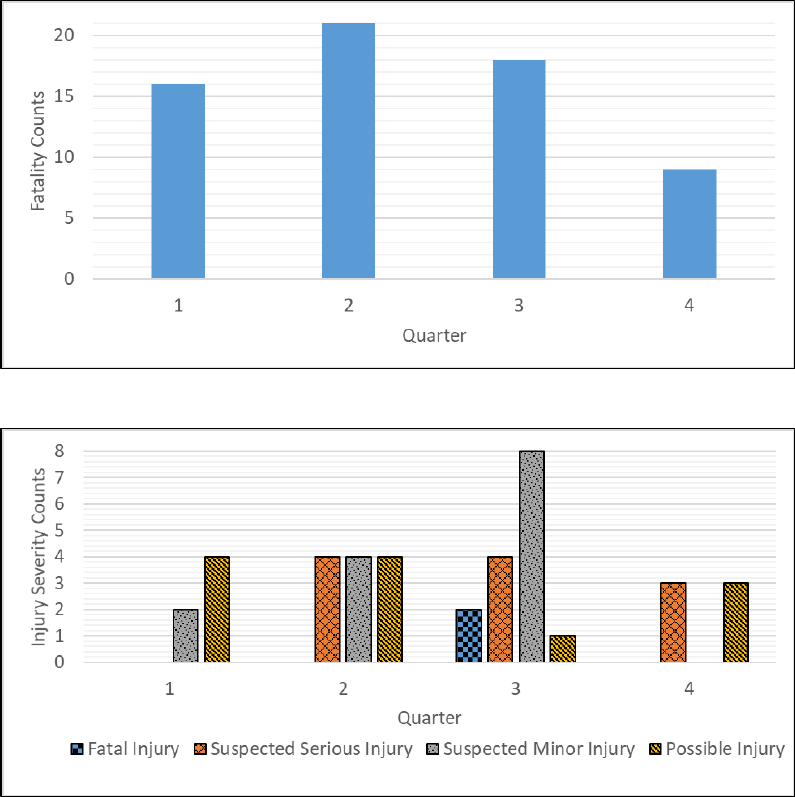
14
restraints be provided to WSBC at the earliest convenience. It is also recommended that
WYDOT provide quarterly summary statistics of restraint use habits, similar to the ones
illustrated in Figures 1 through 20, and Tables 1 through 5. Such statistics were extracted from
the WYDOT HSO 2019 crash data. In addition, heat maps, which are maps of high risk crash
locations or simply hot spots, are presented in Figures 21 and 22. They were developed using
2017 crash data since this was the latest year of which precise coordinates of the crash records
were provided by the WYDOT HSO. The maps were generated using the GIS software, ArcMap
10.4 (Environmental Systems Research Institute, 2016). In particular, the optimized hot spot and
inverse distance weighted (IDW) interpolation features of the software were implemented. Also,
the Z’s (the standard normal distribution values that correspond to the crash risks), presented in
the heat maps, are the standard normal distribution values that correspond to the crash risks. For
the other safety groups, WHP, WASCOP, GCID, WTSC, Wyoming’s counties, WBPST and
motorcycle groups, heat maps were generated via the same procedure as that implemented to
generate the maps for WSBC.
Figure 1: 2019 fatality counts of improperly belted or unbelted occupants.

15
Figure 2: 2019 counts of killed and injured improperly belted or unbelted distracted
drivers.
Figure 3: 2019 counts of killed and injured improperly belted or unbelted impaired drivers.
Figure 4: 2019 counts of killed and injured improperly belted or unbelted drivers.

16
Figure 5: 2019 counts of killed and injured improperly belted or unbelted front-seat
passengers.
Figure 6: 2019 counts of killed and injured improperly belted or unbelted rear-seat
passengers.
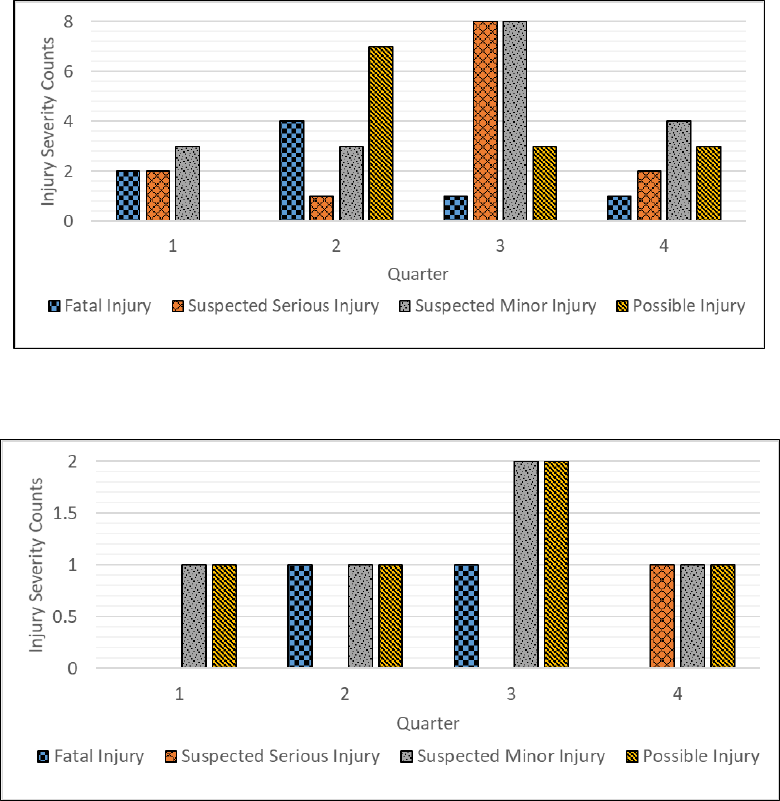
17
Figure 7: 2019 counts of killed and injured improperly restrained or unrestrained children
9 years or younger.
Figure 8: 2019 counts of killed and injured improperly belted or unbelted unlicensed
drivers.
Figure 9: 2019 counts of killed and injured improperly belted or unbelted drivers with
restricted licenses.

18
Figure 10: 2019 counts of killed and injured improperly belted or unbelted drivers by age.
Figure 11: 2019 counts of killed and injured improperly belted or unbelted drivers by
gender.
Figure 12: 2019 fatal counts of improperly belted or unbelted drivers for in/out of state.

19
Figure 13: 2019 serious injury counts of improperly belted or unbelted drivers for in/out of
state.
Figure 14: 2019 minor injury counts of improperly belted or unbelted drivers for in/out of
state.
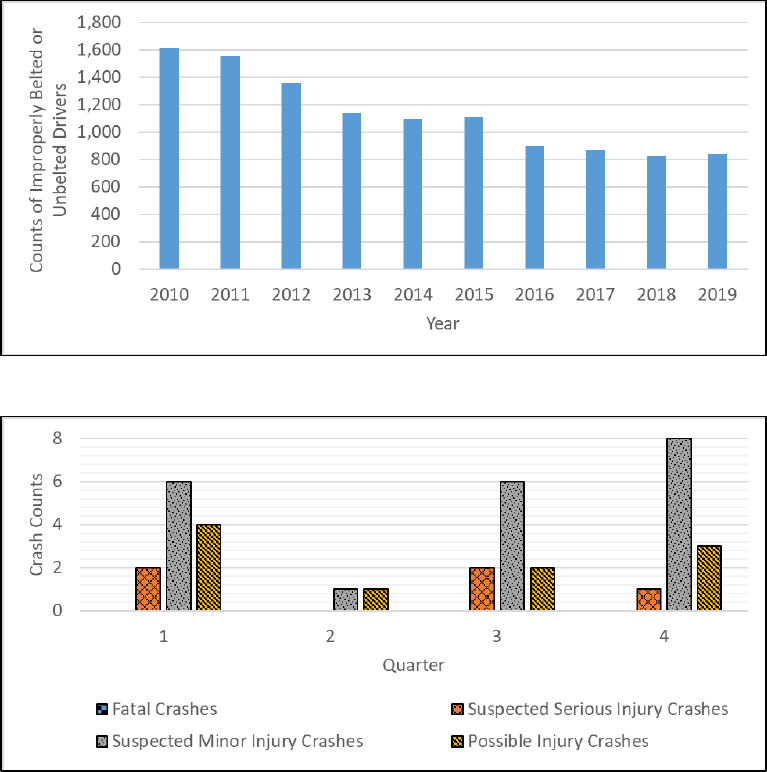
20
Figure 15: 2019 possible injury counts of improperly belted or unbelted drivers for in/out
of state.
Figure 16: Crash Counts of improperly belted or unbelted drivers by year.
Figure 17: 2019 counts of speed related crashes involving improper use or non-use of
restraints.

21
Table 1: 2019 Counts of Killed and Injured Improperly Restrained or Unrestrained
Occupants by Manner of Collision in the First Quarter
Manner of Collision
Fatal
Injury
Suspected
Serious Injury
Suspected
Minor Injury
Possible
Injury
Total
Angle (Front to Side),
Opposing Direction
7 0 55 49 111
Angle, Direction Not
Specified
0 0 0 0 0
Angle, Right (Front to
Side, Includes Broadside)
5 22 70 94 191
Angle, Same Direction
(Front to Side)
2 5 43 32 82
Head-On (Front to Front)
16
13
21
38
88
Not a Collision with Two
Vehicles in Transport
14 44 366 219 643
Other
0
0
3
0
3
Rear-End (Front to Rear)
2
19
92
136
249
Rear to Front (Normally
Backing)
0 0 0 5 5
Rear to Rear (Normally
Backing)
0 0 0 0 0
Rear to Side (Normally
Backing)
0 0 3 1 4
Sideswipe, Opposite-
Direction (Meeting)
1 2 8 9 20
Sideswipe, Same-Direction
(Passing)
0 1 11 13 25
Unknown
0
0
0
0
0
Total
47
106
672
596
1,421

22
Table 2: 2019 Counts of Killed and Injured Improperly Restrained or Unrestrained
Occupants by Manner of Collision in the Second Quarter
Manner of Collision
Fatal
Injury
Suspected
Serious Injury
Suspected
Minor Injury
Possible
Injury
Total
Angle (Front to Side),
Opposing Direction
3 20 34 47 104
Angle, Direction Not
Specified
0 0 0 0 0
Angle, Right (Front to
Side, Includes Broadside)
5 15 68 82 170
Angle, Same Direction
(Front to Side)
0 2 28 17 47
Head-On (Front to Front)
16
19
78
11
124
Not a Collision with Two
Vehicles in Transport
69 143 536 229 977
Other
4
1
4
2
11
Rear-End (Front to Rear)
1
23
77
112
213
Rear to Front (Normally
Backing)
0 0 0 0 0
Rear to Rear (Normally
Backing)
0 0 0 0 0
Rear to Side (Normally
Backing)
0 0 1 2 3
Sideswipe, Opposite-
Direction (Meeting)
0 0 54 7 61
Sideswipe, Same-
Direction (Passing)
1 3 13 5 22
Unknown
0
0
0
0
0
Total
99
226
893
514
1,732

23
Table 3: 2019 Counts of Killed and Injured Improperly Restrained or Unrestrained
Occupants by Manner of Collision in the Third Quarter
Manner of Collision
Fatal
Injury
Suspected
Serious Injury
Suspected
Minor Injury
Possible
Injury
Total
Angle (Front to Side),
Opposing Direction
0 13 56 38 107
Angle, Direction Not
Specified
0 2 0 0 2
Angle, Right (Front to
Side, Includes Broadside)
3 25 101 98 227
Angle, Same Direction
(Front to Side)
0 2 22 17 41
Head-On (Front to Front)
21
29
51
14
115
Not a Collision with Two
Vehicles in Transport
104 287 571 150 1,112
Other
0
1
7
2
10
Rear-End (Front to Rear)
8
14
99
135
256
Rear to Front (Normally
Backing)
0 0 1 2 3
Rear to Rear (Normally
Backing)
0 0 0 0 0
Rear to Side (Normally
Backing)
0 0 0 1 1
Sideswipe, Opposite-
Direction (Meeting)
1 1 1 2 5
Sideswipe, Same-Direction
(Passing)
1 2 13 5 21
Unknown
0
0
0
1
1
Total
138
376
922
465
1,901

24
Table 4: 2019 Counts of Killed and Injured Improperly Restrained or Unrestrained
Occupants by Manner of Collision in the Fourth Quarter
Manner of Collision
Fatal
Injury
Suspected
Serious Injury
Suspected
Minor Injury
Possible
Injury
Total
Angle (Front to Side),
Opposing Direction
5 28 30 52 115
Angle, Direction Not
Specified
0 0 0 0 0
Angle, Right (Front to
Side, Includes Broadside)
6 13 56 118 193
Angle, Same Direction
(Front to Side)
0 4 30 22 56
Head-On (Front to Front)
11
7
22
19
59
Not a Collision with Two
Vehicles in Transport
18 190 379 273 860
Other
0
0
1
3
4
Rear-End (Front to Rear)
2
13
108
154
277
Rear to Front (Normally
Backing)
0 0 0 2 2
Rear to Rear (Normally
Backing)
0 0 0 0 0
Rear to Side (Normally
Backing)
0 0 2 1 3
Sideswipe, Opposite-
Direction (Meeting)
0 0 3 5 8
Sideswipe, Same-
Direction (Passing)
4 0 9 11 24
Unknown
0
0
0
0
0
Total
46
255
640
660
1,601

25
Table 5: 2019 Counts of Killed and Injured Improperly Belted or Unbelted Occupants by
Manner of Collision
Manner of Collision
Fatal
Injury
Suspected
Serious Injury
Suspected
Minor Injury
Possible
Injury
Total
Angle (Front to Side),
Opposing Direction
15 61 175 186 437
Angle, Direction Not
Specified
0 2 0 0 2
Angle, Right (Front to
Side, Includes Broadside)
19 75 295 392 781
Angle, Same Direction
(Front to Side)
2 13 123 88 226
Head-On (Front to Front)
64
68
172
82
386
Not a Collision with Two
Vehicles in Transport
205 664 1852 871 3,592
Other
4
2
15
7
28
Rear-End (Front to Rear)
13
69
376
537
995
Rear to Front (Normally
Backing)
0 0 1 9 10
Rear to Rear (Normally
Backing)
0 0 0 0 0
Rear to Side (Normally
Backing)
0 0 6 5 11
Sideswipe, Opposite-
Direction (Meeting)
2 3 66 23 94
Sideswipe, Same-
Direction (Passing)
6 6 46 34 92
Unknown
0
0
0
1
1
Total
330
963
3,127
2,235
6,655

26
Figure 18: 2019 counts of killed and injured improperly belted or unbelted occupants in
crashes where air bags were not deployed.
Figure 19: 2019 counts of killed and injured improperly belted or unbelted ejected/partially
ejected occupants.
Figure 20: 2019 counts of killed and injured improperly belted or unbelted trapped
occupants.

27
Figure 21: 2017 heat map of crashes involving improper use or non-use of restraints.
Figure 22: 2017 heat map of fatal, suspected serious injury and suspected minor injury
crashes involving improper use or non-use of restraints.

28
In addition to statistics obtained from crash data, it is suggested to provide other summary
statistics data collected from periodical state seat belt surveys (Fernsler, 2019) similar to the ones
presented in Figures 23 through 25. They are descriptive of seat belt use habits by vehicle type,
day of week, and weather condition.
Figure 23: 2019 distribution of unbelted occupants to vehicles.
Figure 24: 2019 restraint non-use proportions by day of the week.

29
Figure 25: 2019 restraint non-use proportions by weather condition.
It is also recommended that future studies be conducted to assess the following:
• Effectiveness of traffic education sessions in promoting proper safety restraint use.
• The influence of drivers’ seat belt use habits on those of the passengers and vice versa.
• Seat belt use habits of occupants riding in vehicles with ADAS technologies.
Summary of the Wyoming Highway Patrol Survey Responses’ Results
A survey was disseminated to members of the Wyoming Highway Patrol and four responses
were received. The common question asked in all surveys was how often did the respondents
receive/secure road safety data/reports from the WYDOT HSO? It was found that 50 percent of
the respondents often obtained crash data from the office once a month while some checked the
option, “other,” and specified the following:
• “Unknown”
• “N/A”
When it comes to data transfer protocols, the respondents declared that they received the data
mostly via email and online databases. Also, the survey results indicated that this was their
preferred method of data acquisition. Other than that, the respondents were asked whether the

30
current safety data provided to them from the WYDOT HSO fulfilled their needs on a scale of
one (not at all) to five (absolutely). Twenty five percent of the respondents declared that the
current crash data being provided to them were neither of no benefit nor beneficial (selected
three) while 50 percent claimed that the data were indeed beneficial (selected four and five).
More importantly, the respondents were asked about the ideal period during which they preferred
to receive the crash data from the dates the crashes occurred. One respondent stated that he or
she preferred that the data be delivered within a month of the crash’s occurrences and that this
would be the desired period. Another declared that he or she secured the data within a day of the
crash occurrences and that this would be the preferred period.
Regarding the preferred data format, half of the respondents favored summary statistics tables, a
quarter preferred figures and half-preferred pie charts. One respondent checked the option,
“other,” and stated, “as simple as possible.” Note that each respondent was provided the option
of specifying multiple data formats from a list (i.e. checkboxes).
The respondents were further asked about the preferred method of portraying crash sites. They
included the following:
• Narrative descriptions of the locations
• Photos
• Color-coded maps
• Road and milepost information
• GIS coordinates
• A combination of the above
Remarkably, 75 percent of the respondents claimed that they were interested in a combination of
methods of depicting the crash locations. The answer choices were provided in the form of
checkboxes such that the respondents might have selected multiple options. The respondents also
selected the options, “narrative descriptions of the locations,” “color-coded maps” and “road and
milepost information.” One respondent selected the option, “other,” and stated, “pinpointed on a
digital map that you can zoom in and out on.”
In the following section of the survey, respondents were asked about road safety reports
pertaining to crash data. The reports, most of which are available in the WYDOT HSO website,
are the following:
• 2019 Highway Safety Crash Data Survey Final Report
• Wyoming Department of Transportation Highway Safety Behavioral Grants Office 2019
Annual Report
• Wyoming Highway Safety Behavioral Program FY2020 Highway Safety Plan
• Wyoming Report on Traffic Crashes 2019
• Wyoming Drivers Survey 2016
• 2019 Seat Belt Survey Analysis

31
• Wyoming Statewide Crashes by Year
• Wyoming Statewide Speed Related Crashes by Year
• Wyoming Statewide Crashes Involving a Wild Animal by Year
• Wyoming Statewide Occupant Seat Belt Usage by Year
• Wyoming Statewide Crashes Involving a Pedestrian by Year
• Wyoming Statewide Crashes Involving Alcohol or Drugs by Year
• Wyoming Statewide Crashes Involving Commercial Motor Vehicles by Year
• Wyoming Statewide Distracted Driving Crashes by Year
• Wyoming Strategic Highway Safety Plan 2017
On a scale of one (not at all) to five (absolutely) describing whether the respondents were
familiar with these reports and whether they frequently used them, roughly half provided a rating
of four while a quarter provided a rating of five. Also, all declared that they were satisfied with
the frequency at which the reports were released. Members of WHP were then asked about the
importance of incorporating specific summary statistics safety data in the listed reports. At least
half of them indicated that they were interested in the following:
• Drivers’ improper actions/error information preceding the crashes (e.g. driving too fast,
improper passing, following too closely, etc.)
• Aggressiveness of drivers who were at-fault in the crashes
• Whether the passengers in the rear seats were properly secured
• Socio-demographics of drivers who were at-fault in the crashes
• Truck safety and truck policy violations at the times of the crashes (exceeded weight
limit, improperly secured hazardous materials, etc.)
• Animal crash hot spots
• Hit-and-run crashes
• The effectiveness of media outreach campaigns in raising traffic safety awareness (traffic
safety slogans and/or relevant content disseminated via the social media, television, radio,
billboards)
In the subsequent section of the survey, WHP officers were asked specific questions about
processed crash data. At least half of them declared that they were interested in the following:
• Crash locations (on the road, on the shoulder, off the road, etc.)
• Crash times (morning, afternoon, etc.)
• Weather conditions at the times of the crashes
• Vehicle travel speeds preceding the crashes (i.e. too slow for the conditions, reasonable
or too fast for the conditions)
• Number of vehicles involved in the crashes
• Number of pedestrians and/or bicyclists involved in the crashes
• Types of animals involved in the crashes

32
• Whether the drivers were properly wearing their seat belts at the times of the crashes
• Whether the passengers were properly wearing their seat belts at the times of the crashes
• Whether children were properly secured in their appropriate car seats at the times of the
crashes
• Whether the drivers were driving under the influence of alcohol/drugs at the times of the
crashes
• Whether the drivers were tired at the times of the crashes
• Hit-and-run crashes
• Crashes resulting in fires
• Crashes resulting in jackknifed vehicles
• Crashes resulting in ejected occupants
• Crashes in which trucks were overturned by severe winds
• Motorcycle crashes
• Whether the motorcyclists were wearing helmets at the times of the crashes
• Whether the motorcyclists were wearing the appropriate gear (riders’ jackets, boots,
etc.) at the times of the crashes
• Whether the motorcycle passengers were wearing helmets at the times of the crashes
• Whether the motorcyclists were riding in motorcycle groups at the times of the crashes
• Whether work zone plans were implemented according to the standards when the crashes
occurred at or near the work zones
• Whether workers were present when the crashes occurred at or near the work zones
• Shoulder and lane closure information when the crashes occurred at or near the work
zones
• Whether drivers violated work zone regulations giving rise to the crashes (i.e. exceeded
the work zones’ speed limits, failed to obey the traffic guards’ signals, etc.)
• Vehicle parts’ conditions (tires, brakes, engine, etc.) at the times of the crashes
Furthermore, the officers stated that information regarding the number of injured drivers,
passengers, motorcyclists, pedestrians and their injury severity levels were important. The
officers were also asked whether they were interested in summary statistics, in the form of charts
and tables, depicting certain crash patterns. At least half of the respondents indicated that they
were interested in summary statistics depicting the following:
• Crash types (rear-end, sideswipe, etc.)
• Impact point information of vehicles involved in the crashes (struck from the side, struck
from the front, etc.)
• Crashes that occurred during special holidays/events (Fourth of July, Labor Day
weekend, Thanksgiving, Christmas, etc.)
• DUI related crashes by day of the week (i.e. weekdays versus weekends)
33
• Injury severity levels of DUI related crashes by blood alcohol concentration (BAC) of the
impaired drivers
• Comparison of the injury severity levels among properly buckled and improperly buckled
or unbuckled vehicle occupants
• Injury severity levels by drivers’ age group and gender
• Crashes on roads with challenging geometric conditions (steep upgrades, steep
downgrades, tight horizontal curves, etc.)
• Crashes involving distractions by distraction method (use of electronic device, picking up
an object from the vehicle’s floor, etc.)
• Crash locations by injury severity level and lighting conditions (daylight, dawn, dark with
street lighting, etc.) at the times of the crashes
• Crash locations by injury severity level and road surface conditions (dry, wet, icy, snowy,
etc.) at the times of the crashes
The respondents were also asked about the importance of color-coded maps presenting locations
characterized by risks of encountering the following types of crashes on a scale of one (not
important) to five (crucial). At least half declared scores of four or five for those crashes.
• High severity (fatal, suspected serious injury and suspected minor injury) crashes
• Possible injury and PDO crashes
• High severity crashes that occurred in the presence of adverse weather conditions (snow,
fog, rain, etc.)
• High severity crashes where visual obstructions (vegetation, hill crests, sun glare,
headlight glare, other vehicles, animals, fog, snow showers, etc.) posed hazards
• High severity crashes involving improperly buckled or unbuckled occupants
• High severity DUI related crashes
• High severity speed related crashes
The respondents were then directed to another section asking about whether they were interested
in specific citation information. As was the case of the WSBC survey, the WYDOT HSO would
not maintain such data. Hence, a disclaimer was provided stating this fact and that independent
studies would have to be conducted to process citation data. At least half of the respondents
declared that they preferred the following data:
• Citation counts of unlicensed drivers
• Citation counts of drivers not wearing their prescription glasses/contact lenses if their
licenses required so
• Citation counts of young drivers who were not accompanied by passengers eighteen years
or older if their licenses required so
• Citation counts by violation type and driver’s age
• Citation counts by violation type and driver’s gender
34
• Citation counts of seat belt use policy violations by county and year
• Whether vehicle occupants, cited for previous seat belt use violations, attended traffic
education sessions
• Citation counts of child restraint policy violations by county and year
• Citation counts of aggressive/reckless drivers by county and year
• Citation counts of tired drivers by county and year
• Speeding citation counts by county and year
• Locations characterized by a considerable number of citations issued
Finally, the officers were asked to select topics they might be interested in for further
investigation (i.e., data analyses, interpretation and documentation of results in reports). At least
three quarters of them declared that they were interested in the following topics:
• Effectiveness of DUI enforcement policies
• Effectiveness of speed enforcement policies
• Effectiveness of seat belt use policies
• Response times of emergency services, particularly for severe crashes
• Effectiveness of traffic safety educational campaigns
• Effectiveness of other traffic violation enforcement polices (i.e. improper lane change,
red light running, etc.)
• Effective methods of capturing motorcyclists committing traffic violations
• Safety benefits of vehicles equipped with ADAS
• Safety benefits of mandatory periodic vehicle inspections in other states
• Fluctuations in traffic fatality rates in Wyoming throughout the years
Summary of the Wyoming Association of Sheriffs and Chiefs of Police Survey Responses’
Results
A survey was prepared and distributed to members of the Wyoming Association of Sheriffs and
Chiefs of Police (WASCOP) asking about road safety data they needed in addition to those
already provided in statewide road safety reports and database files they would retrieve from the
WYDOT HSO. Three responses were obtained. In the first section of the survey, the respondents
indicated that they received road safety data and/or reports once a month via email, which was
the preferred means of data acquisition. Note that one of the officers stated that he or she did not
receive such data. The respondents also maintained that the data provided fulfilled their needs.
Furthermore, one respondent stated that they received crash data 12 to 15 days from the dates the
crashes occurred and that, ideally, this duration ought to be shortened to a week. The other
claimed that WASCOP received the crash data a day after the crashes occurred and that this was
the ideal time interval. Also, the respondents indicated that they preferred crash data be
summarized in the form of pie charts/bar charts, summary statistics tables and figures.
Furthermore, two of the three respondents concurred that color-coded maps would be considered
efficient means of illustrating crash locations.
35
In the second section of the survey, members of WASCOP were provided a list of reports
available in the WYDOT HSO website, which are the following:
• 2019 Highway Safety Crash Data Survey Final Report
• Wyoming Department of Transportation Highway Safety Behavioral Grants Office 2019
Annual Report
• Wyoming Highway Safety Behavioral Program FY2020 Highway Safety Plan
• Wyoming Report on Traffic Crashes 2019
• Wyoming Drivers Survey 2016
• 2019 Seat Belt Survey Analysis
• Impaired Driver-Involved Crash Statistics
• Wyoming Statewide Crashes by Year
• Wyoming Statewide Speed Related Crashes by Year
• Wyoming Statewide Occupant Seat Belt Usage by Year
• Wyoming Statewide Crashes Involving a Wild Animal by Year
• Wyoming Statewide Crashes Involving Alcohol or Drugs by Year
• Wyoming Statewide Crashes Involving Commercial Motor Vehicles by Year
• Wyoming Statewide Distracted Driving Crashes by Year
• Wyoming Strategic Highway Safety Plan 2017
When asked about how familiar the responds were with the reports listed, on a scale of one (not
at all) to five (absolutely), one provided a rating of one while another provided a rating of two,
and the third provided a rating of three. In particular, one respondent stated that he or she was
familiar with three of the aforementioned reports, which are:
• Wyoming Department of Transportation Highway Safety Behavioral Grants Office 2019
Annual Report
• Wyoming Report on Traffic Crashes 2019
• Wyoming Statewide Crashes by Year
Remarkably, one respondent declared that the reports listed in the survey would be considered
beneficial to WASCOP, and two respondents indicated that they were satisfied with the
frequency at which those reports were released. Also, none suggested any additional reports to
include in the list. Furthermore, two respondents claimed that they would like to be presented
summary statistics describing drivers’ improper actions/error information preceding the crashes
in those reports.
After answering questions about the road safety reports, the respondents were asked about
particular crash data that would be of interest to them. At least two indicated that they were
interested in the following crash data variables presented in the form of summary statistics:
• Crash locations (on the road, on the shoulder, off the road, etc.)
36
• Crash times (morning, afternoon, etc.)
• Weather conditions at the times of the crashes
• Number of vehicles involved in the crashes
• Vehicle travel speeds at the times of the crashes (too slow, reasonable or too fast for
the conditions)
• Whether the passengers were properly wearing their seat belts at the times of the
crashes
• Whether the drivers were driving under the influence of drugs or alcohol
• Motorcycle crashes
• Number of injured drivers/motorcyclists and their injury severity levels
• Crash types (rear-end, sideswipe, etc.)
• Impact point information (struck from the side, etc.)
• Crashes that occurred during special holidays/events (Fourth of July, Labor Day
weekend, Thanksgiving, Christmas, etc.)
• DUI related crashes by day of the week (weekdays versus weekends)
• Injury severity levels of DUI related crashes by blood alcohol concentration (BAC)
level of impaired drivers
• Comparison of the injury severity levels among properly buckled and improperly
buckled or unbuckled vehicle occupants
• Injury severity levels by drivers’ age group and gender
• Crashes on roads with challenging geometric conditions (steep upgrades, steep
downgrades, tight horizontal curves, etc.)
• Crashes involving distractions by distraction method (use of electronic device,
picking up an object from the vehicle’s floor, etc.)
• Crash locations by injury severity level and lighting conditions (daylight, dark with
street lighting, etc.)
• Crash locations by injury severity level and road surface conditions (dry, wet, icy,
snowy, etc.)
Furthermore, two of the three respondents indicated that they were interested in color-coded
maps describing specific crash categories, which are the following:
• High severity (fatal, suspected serious injury and suspected minor injury) crashes
• High severity crashes that occurred in the presence of adverse weather conditions (snow,
rain, etc.)
• High severity DUI related crashes
• High severity speed related crashes
Other than crash information related questions, members of WASCOP were also asked about
citation data. Similar to the WHP survey, a disclaimer was included to inform the respondents
that the WYDOT HSO would not maintain citation data and that independent studies would have
37
to be conducted on such data, if needed. From the survey results, only one respondent claimed
interest in data of citation counts of aggressive/reckless drivers by county and year. Similarly,
one respondent stated that he or she was willing to receive data on citation counts of tired drivers
by county and year. Finally, a question was asked about specific research topics that would be of
interest to WASCOP. Two respondents suggested that studies be conducted on the following
topics:
• Effectiveness of DUI enforcement policies
• Effectiveness of speed enforcement policies
Recommendations for the Wyoming Department of Transportation Regarding the
Wyoming Highway Patrol and the Wyoming Association of Sheriffs and Chiefs of Police
The results of the WHP and WASCOP surveys were similar and, hence, recommendations made
regarding the data WYDOT should provide to those groups were combined in one section. The
first recommendation was to provide crash records to WHP and WASCOP at the shortest
possible time. It is also suggested WYDOT should provide quarterly summary statistics similar
to the ones illustrated in Figures 26 through 65, and Tables 6 through 10. Similar to the
recommendations regarding heat maps to be provided to WSBC, other heat maps are suggested
for both WHP and WASCOP. The suggested heat maps would be comparable to the ones
presented in Figures 66 through 73.

38
Table 6: 2019 Counts of Drivers’ Actions Preceding the Crashes
Drivers’ Actions Prior to the Crashes
Quarter
Total
1
2
3
4
Avoiding Animal
22
30
49
33
134
Avoiding Motor Vehicle
85
53
70
83
291
Avoiding Non-Motorist
2
0
11
4
17
Avoiding an Object on Road
4
9
14
14
41
Disregarded Other Road Marking
11
33
21
68
133
Disregarded Traffic Signs
135
123
152
170
580
Drove too Fast for Conditions
1,216
322
160
1,401
3,099
Erratic/Reckless/Careless/Aggressive
229
366
363
350
1,308
Evading Law Enforcement
15
35
18
17
85
Failed to Keep Proper Lane
848
657
691
963
3,159
Failed to Yield Right-of-Way
477
444
512
477
1,910
Following Too Closely
378
371
455
424
1,628
Improper Backing
167
189
180
184
720
Improper Parking
16
9
23
10
58
Improper Passing
57
65
75
53
250
Improper Turn or No Signal
136
146
183
153
618
Over Corrected/Over Steered
160
163
195
189
707
Ran Off the Road
950
749
732
1,074
3,505
Ran Red Light
120
91
110
121
442
Speeding
91
162
214
133
600
Swerve Due to Wind/Slippery Surface
246
65
8
205
524
Wrong Side/Wrong Way
49
59
43
33
184
Other Improper Action
230
253
327
329
1,139
No Improper Driving
2,557
2,299
2,663
3,232
10,751
Unknown
253
196
290
286
1,025
Total
8,454
6,889
7,559
10,006
32,908

39
Figure 26: 2019 counts of cited drivers at the crash scenes by age.
Figure 27: 2019 counts of cited drivers at the crash scenes by gender.
Figure 28: 2019 counts of hit-and-run crashes.
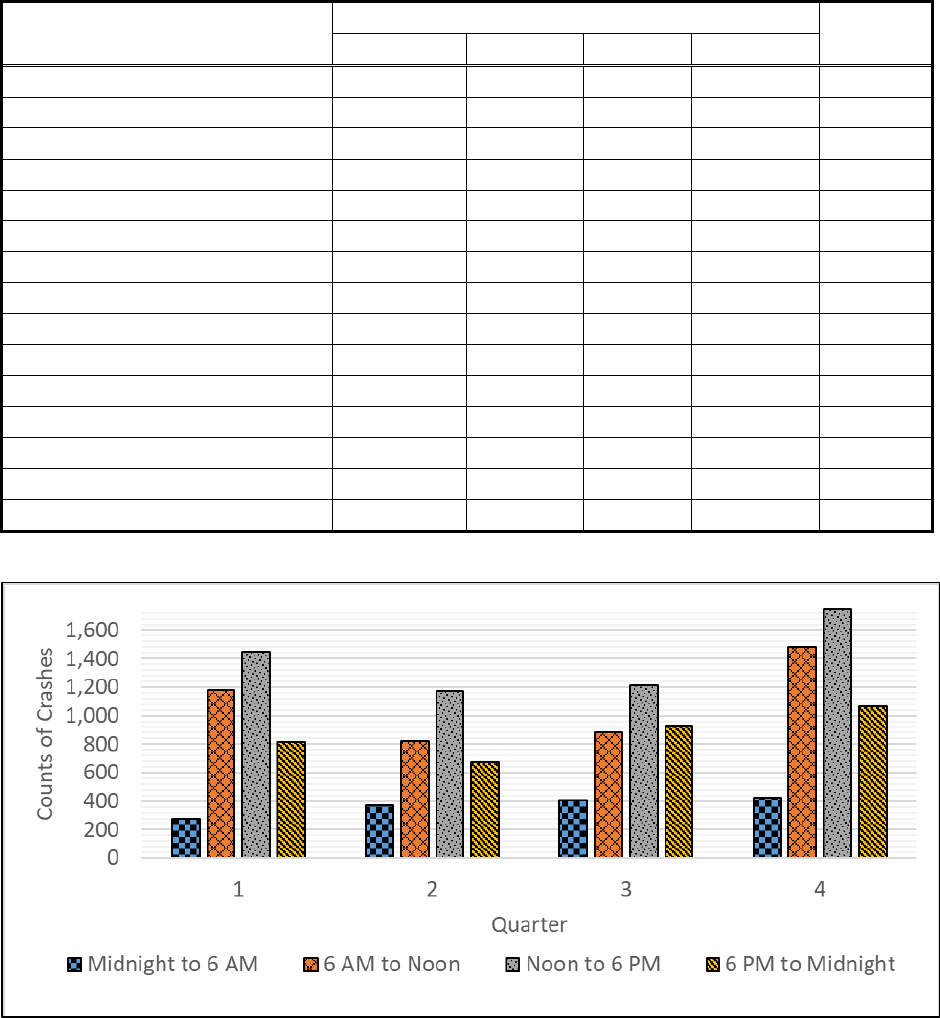
40
Table 7: 2019 Counts of Crashes by First Harmful Event Location
Figure 29: 2019 counts of crashes by time of day.
First Harmful Event Location
Quarter
Total
1
2
3
4
Bridge
2
0
1
1
4
Gore
5
4
5
8
22
In Parking Lane/Zone
223
179
204
269
875
Median
198
131
70
240
639
Off Roadway
858
599
525
1,063
3,045
On Other Roadway
3
0
3
1
7
On Roadway
2,254
2,007
2,475
2,914
9,650
Outside of Right-of
-
Way
7
5
7
9
28
Port of Entry
1
3
0
0
4
Rest Area
0
0
1
1
2
Separator
3
4
1
3
11
Shoulder
154
107
137
193
591
Tunnel
9
3
0
6
18
Unknown
0
1
2
1
4
Total
3,717
3,043
3,431
4,709
14,900
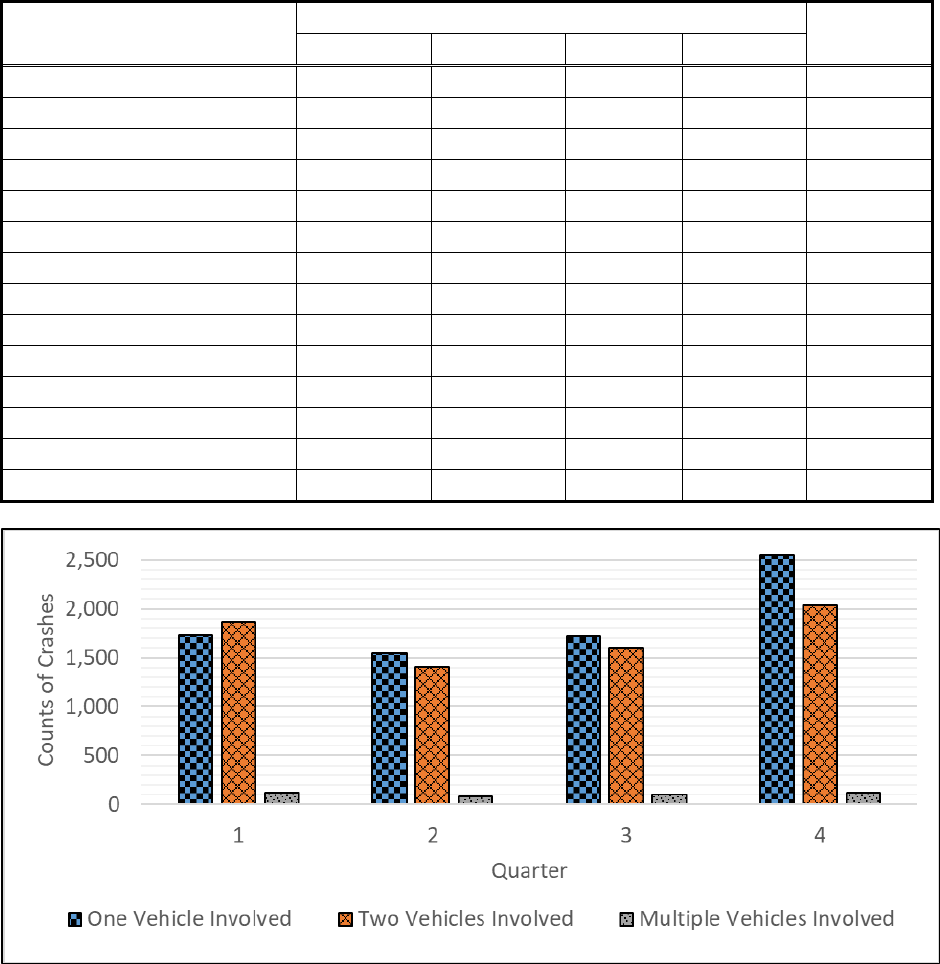
41
Table 8: 2019 Counts of Crashes by Weather Condition
Figure 30: 2019 counts of crashes by number of vehicles involved.
Weather Condition
Quarter
Total
1
2
3
4
Blizzard
34
7
0
39
80
Blowing Dust/Sand/Dirt
7
0
0
4
11
Blowing Snow
285
24
0
244
553
Clear
2,394
2,312
3,187
3,168
11,061
Cloudy, Overcast
138
171
61
183
553
Fog
41
26
15
40
122
Raining
18
217
121
42
398
Severe Wind Only
107
9
5
65
186
Sleet/Hail/Freezing Rain
12
28
3
53
96
Sm
oke
0
2
0
0
2
Snowing
623
199
1
794
1,617
Other
3
0
0
7
10
Unknown
55
48
38
70
211
Total
3,717
3,043
3,431
4,709
14,900

42
Figure 31: 2019 counts of bicycle crashes.
Table 9: 2019 Animal Crashes by Type of Animal Struck
Animal
Quarter
Total
1
2
3
4
Deer
336
457
613
795
2,201
Antelope
31
65
84
62
242
Elk
17
27
62
36
142
Buffalo
1
1
0
0
2
Moose
7
9
16
9
41
Other Wild
4
8
12
11
35
Cow
13
26
56
46
141
Horse
4
6
4
7
21
Sheep
4
1
3
4
12
Pig
0
1
0
0
1
Other Domestic (Dog, Lama, etc.
)
6
7
9
13
35
Total
423
608
859
983
2,873
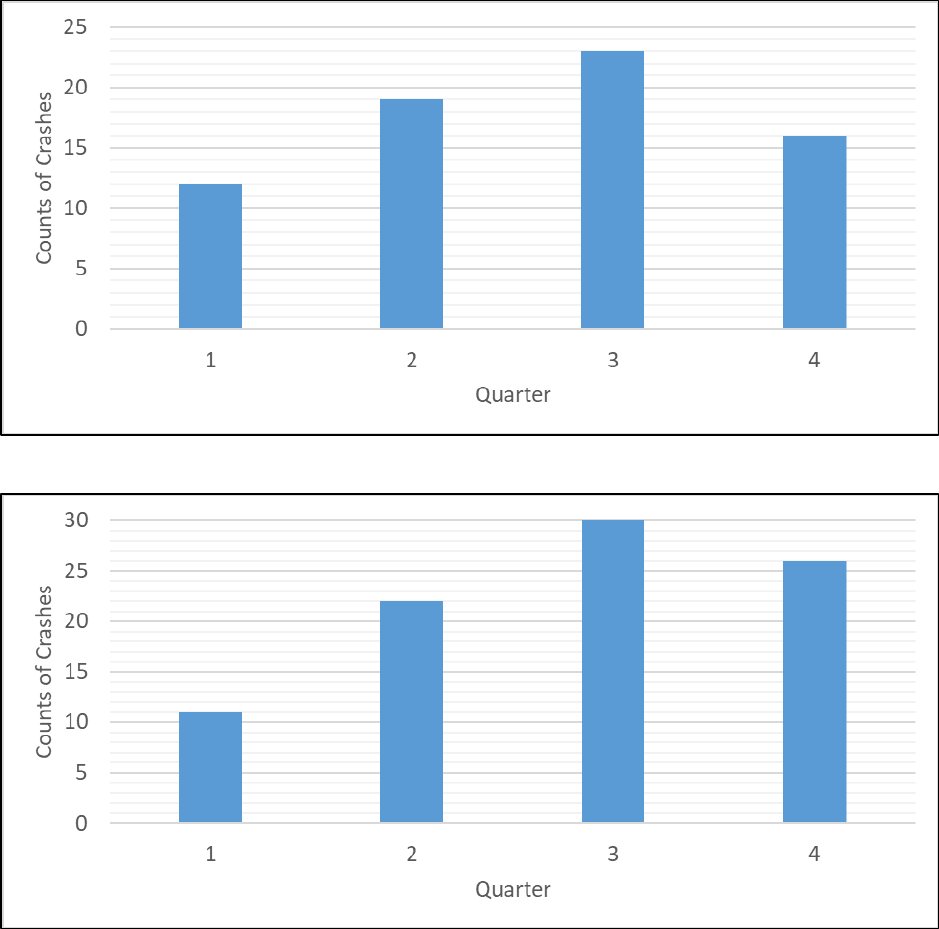
43
Figure 32: 2019 counts of crashes resulting in fires.
Figure 33: 2019 counts of crashes involving mechanical failures.
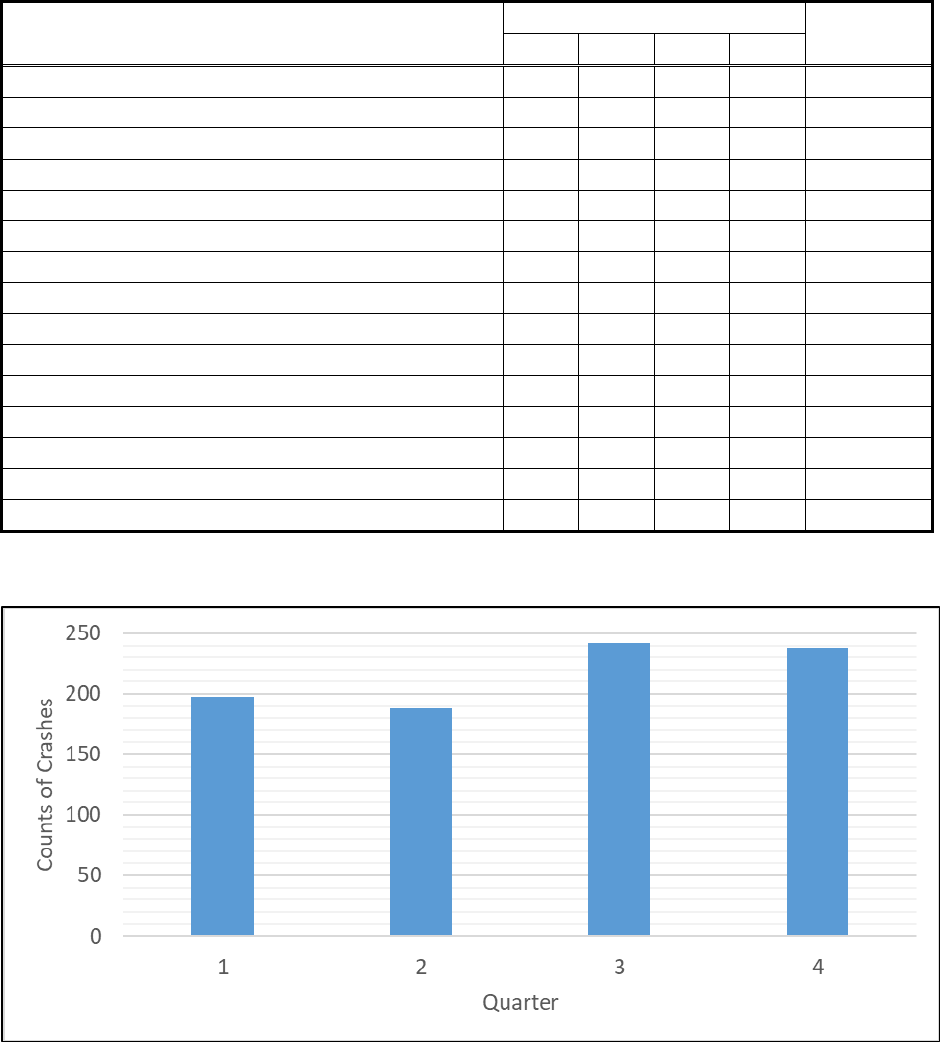
44
Table 10: 2019 Counts of Crashes by Manner of Collision
Figure 34: 2019 counts of weekend driving under the influence crashes.
Manner of Collision
Quarter
Total
1
2
3
4
Head On (Front to Front)
82
52
70
94
298
Angle (Front to Side), Opposing Direction
248
165
176
294
883
Angle Right (Front to Side, Includes Broadside)
424
268
334
405
1,431
Angle Same Direction (Front to Side)
196
138
162
198
694
Angle Direction Not Specified
7
1
3
3
14
Rear End (Front to Rear)
567
450
496
652
2,165
Rear to Front (Normally Backing)
59
50
55
63
227
Rear to Rear (Normally Backing)
12
16
12
20
60
Rear to Side (Normally Backing)
73
79
83
80
315
Sideswipe Opposite Direction (Meeting)
51
32
31
56
170
Sideswipe Same Direc
tion (Passing)
216
184
219
237
856
Other
17
35
30
31
113
Not a Collision with Two Vehicles in Transport
1,321
962
909
1,607
4,799
Unknown or Not Stated
444
611
851
969
2,875
Total
3,717
3,043
3,431
4,709
14,900

45
Figure 35: 2019 counts of drivers by detestable condition.
Figure 36: 2019 counts of ejected, partially ejected and trapped occupants.
Figure 37: 2019 special occasion crashes.

46
Figure 38: 2019 counts of killed and injured male drivers.
Figure 39: 2019 counts of killed and injured female drivers.
Figure 40: 2019 counts of killed and injured male passengers.
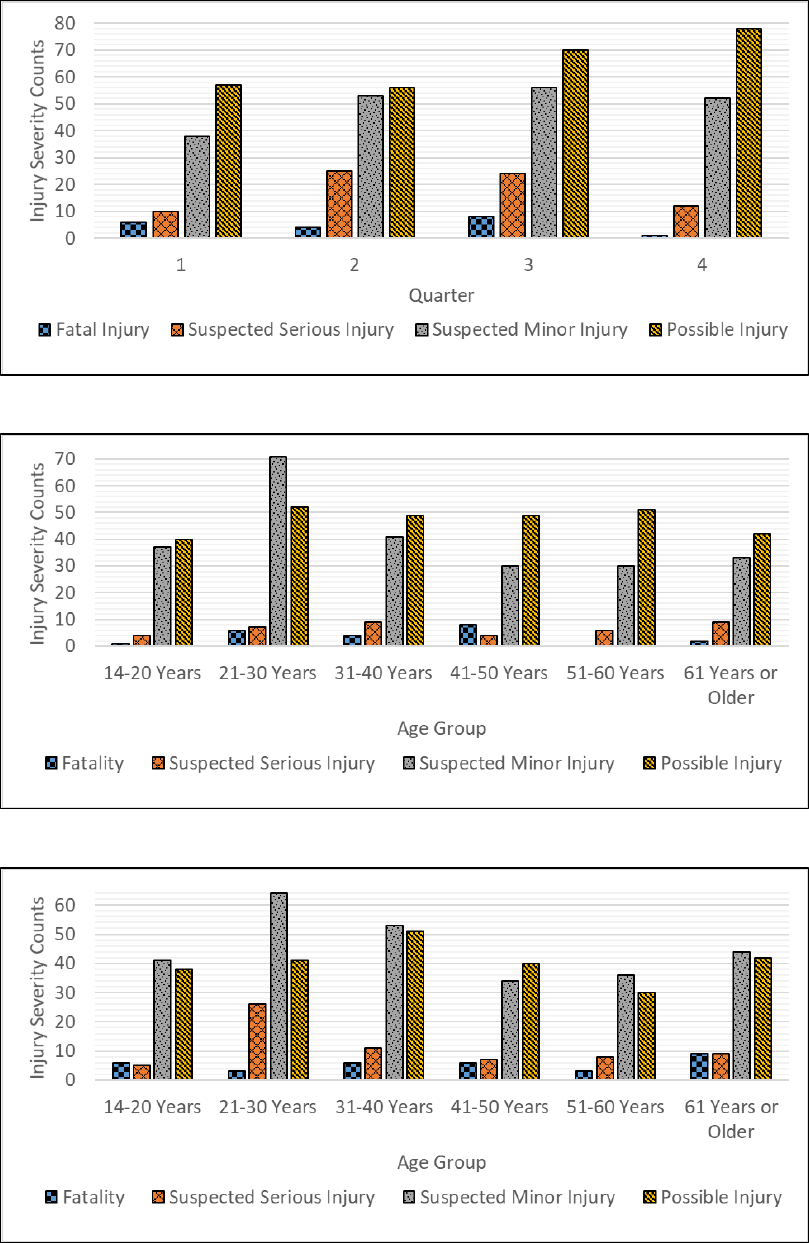
47
Figure 41: 2019 counts of killed and injured female passengers.
Figure 42: 2019 counts of killed and injured drivers by age in the first quarter.
Figure 43: 2019 counts of killed and injured drivers by age in the second quarter.

48
Figure 44: 2019 counts of killed and injured drivers by age in the third quarter.
Figure 45: 2019 counts of killed and injured drivers by age in the fourth quarter.
Figure 46: 2019 counts of killed and injured passengers by age in the first quarter.

49
Figure 47: 2019 counts of killed and injured passengers by age in the second quarter.
Figure 48: 2019 counts of killed and injured passengers by age in the third quarter.
Figure 49: 2019 counts of killed and injured passengers by age in the fourth quarter.
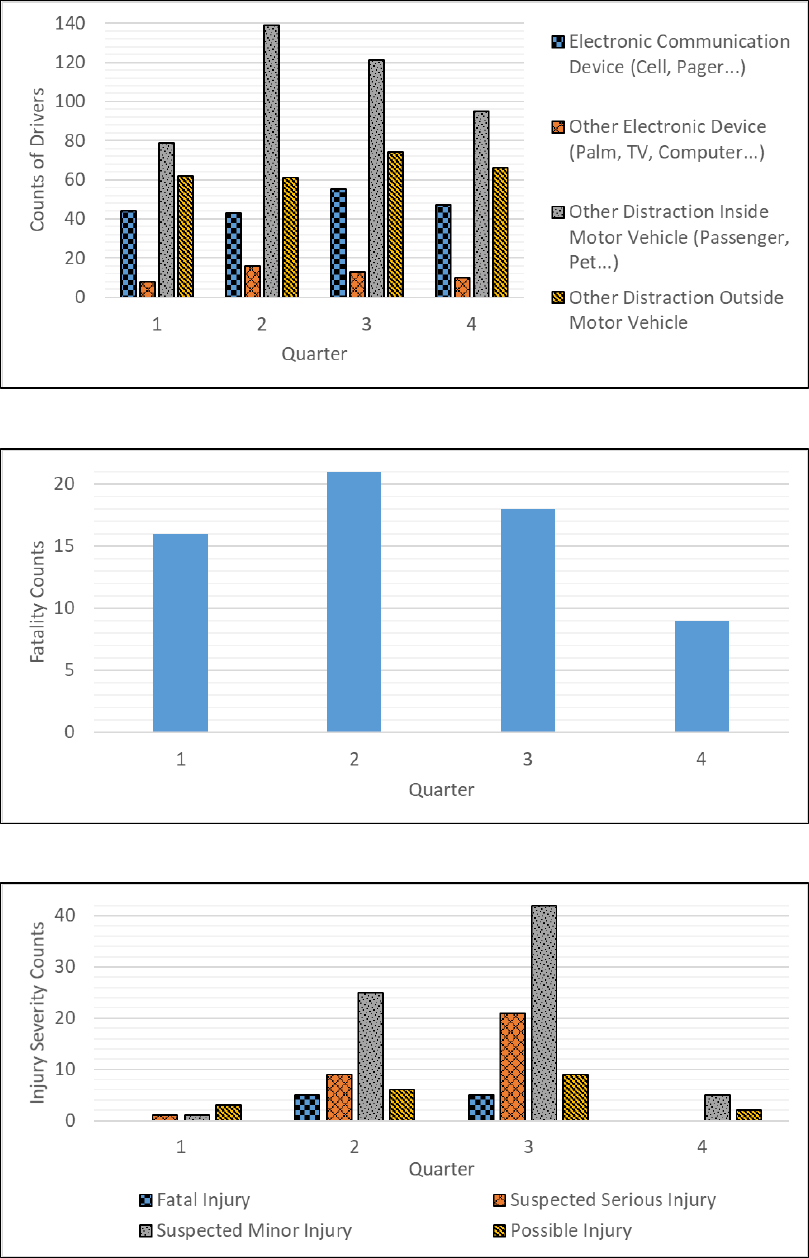
50
Figure 50: 2019 counts of distracted drivers by means of distraction.
Figure 51: 2019 fatality counts of improperly belted or unbelted occupants.
Figure 52: 2019 counts of killed and injured motorcycle operators.

51
Figure 53: 2019 counts of killed and injured motorcycle operators wearing helmets.
Figure 54: 2019 counts of killed and injured motorcycle operators not wearing helmets.
Figure 55: 2019 counts of killed and injured motorcycle passengers.

52
Figure 56: 2019 counts of killed and injured motorcycle passengers wearing helmets.
Figure 57: 2019 counts of killed and injured motorcycle passengers not wearing helmets.
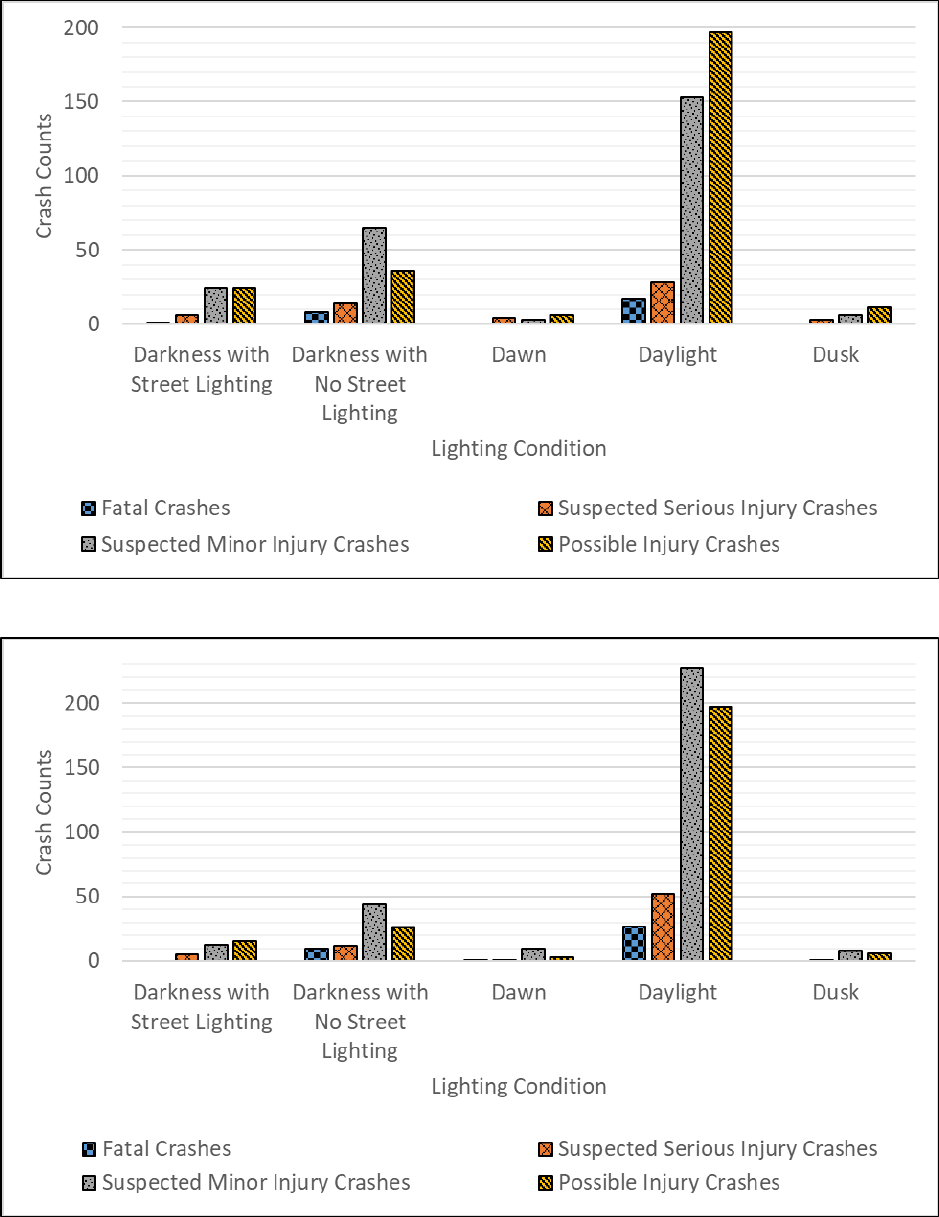
53
Figure 58: 2019 counts of crashes by lighting condition in the first quarter.
Figure 59: 2019 counts of crashes by lighting condition in the second quarter.

54
Figure 60: 2019 counts of crashes by lighting condition in the third quarter.
Figure 61: 2019 counts of crashes by lighting condition in the fourth quarter.

55
Figure 62: 2019 counts of crashes by road surface condition in the first quarter.
Figure 63: 2019 counts of crashes by road surface condition in the second quarter.

56
Figure 64: 2019 counts of crashes by road surface condition in the third quarter.
Figure 65: 2019 counts of crashes by road surface condition in the fourth quarter.

57
Figure 66: 2017 heat map of fatal, suspected serious injury and suspected minor injury
crashes.
Figure 67: 2017 heat map of speed related crashes.
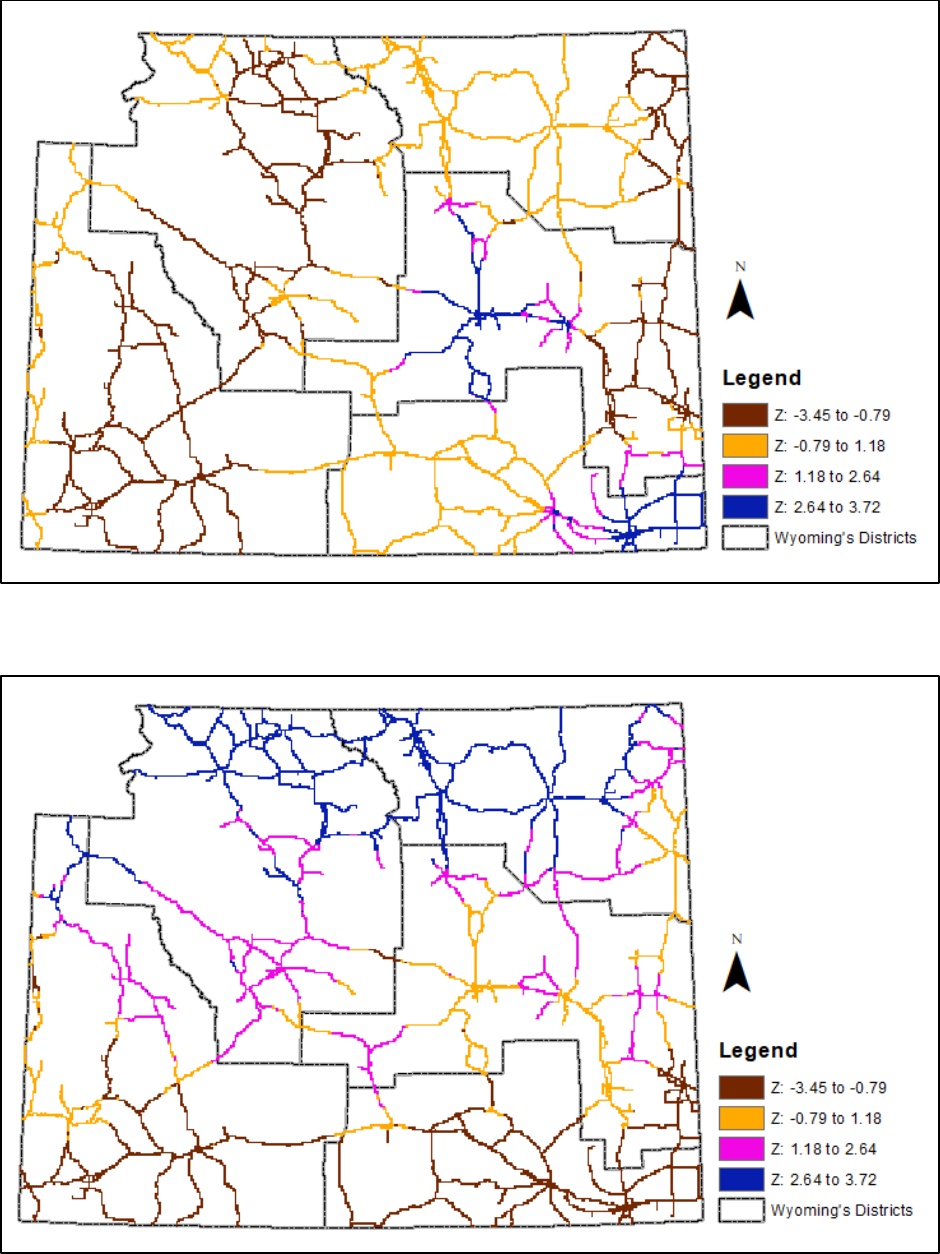
58
Figure 68: 2017 heat map of speed related fatal, suspected serious injury and suspected
minor injury crashes.
Figure 69: 2017 heat map of wild animal crashes.
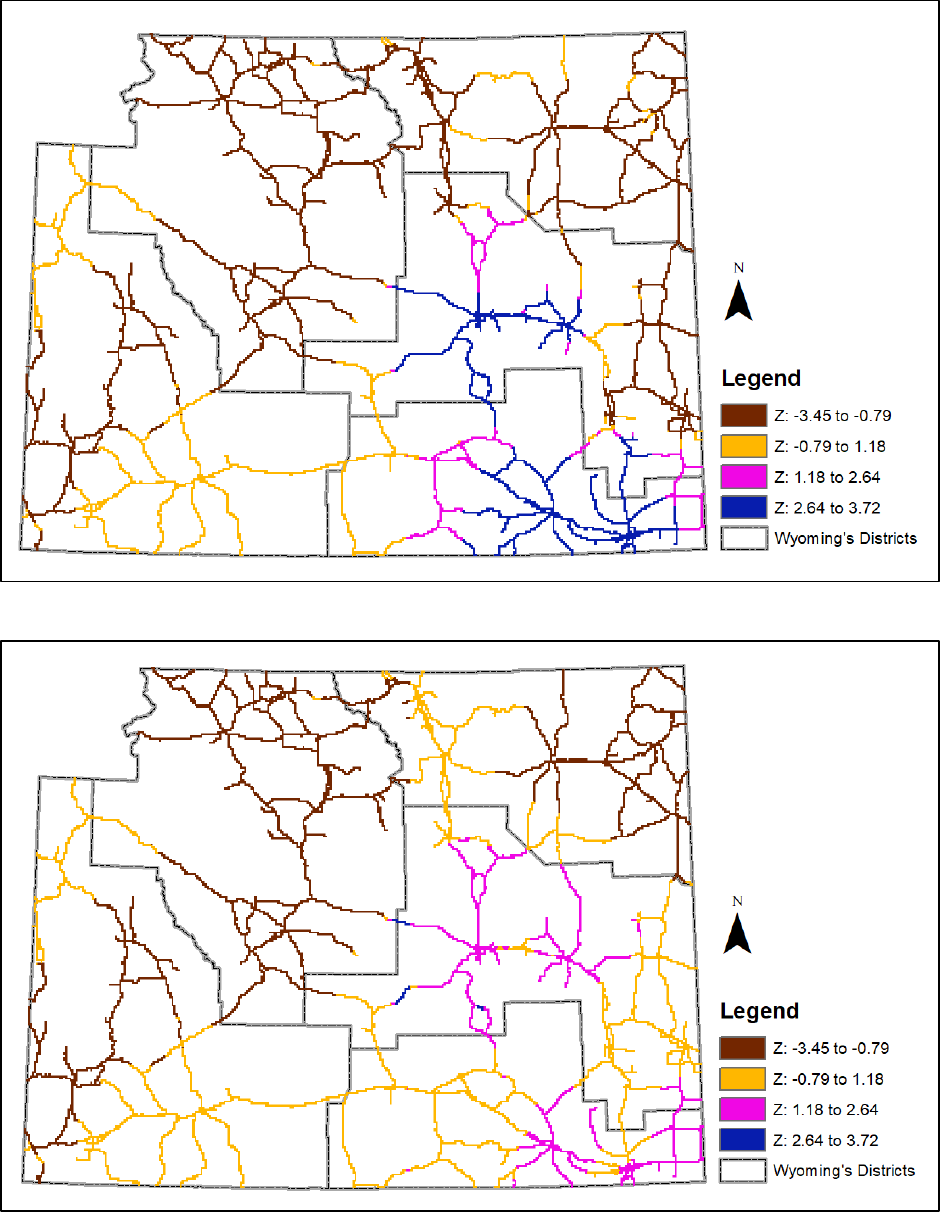
59
Figure 70: 2017 heat map of adverse weather related crashes.
Figure 71: 2017 heat map of fatal, suspected serious injury and suspected minor injury
adverse weather related crashes.

60
Figure 72: 2017 heat map of driving under the influence crashes.
Figure 73: 2017 heat map of driving under the influence fatal, suspected serious injury and
suspected minor injury crashes.
61
Other than disseminated the crash summary statistics, it is recommended that WYDOT plan for
future independent studies on citation records, particularly to obtain the following:
• Citation counts of unlicensed drivers
• Citation counts of drivers not wearing their prescription lenses if their licenses require so
• Citation counts of young drivers with licenses that are of lower rank than regular licenses
(e.g. learner’s permits, etc.)
• Citation counts by drivers’ age groups
• Citation counts by gender
• Citation counts of seat belt use policy violations by county and year
• Citation counts of child restraint policy violations by county and year
• Citation counts of reckless drivers by county and year
• Citation counts of impaired drivers by county and year
• Speeding citation counts by county and year
• Information on locations that are characterized by considerable citation counts
It is also suggested that WYDOT plan for research activities on the following list of topics and
document the results in reports.
• Effectiveness of DUI enforcement policies
• Effectiveness of speed enforcement policies
• Effectiveness of seat belt use enforcement policies
• Response times of emergency services, especially for fatal, suspected serious injury and
suspected minor injury crashes
• Effectiveness of traffic safety educational campaigns
• Effectiveness of other traffic violation enforcement polices (i.e. improper lane change,
red light running, etc.)
• Effective methods of capturing motorcyclists committing traffic violations
Summary of the Wyoming Transportation Safety Coalition Survey Responses’ Results
Similar to the cases of the previously discussed groups, a survey was drafted and disseminated to
members of the Wyoming Transportation Safety Coalition. The survey targeted topics related to
large commercial motor vehicles (CMVs). In the first section of the survey, the participants were
asked generic questions related to the road safety data they received. When asked how often
members of WTSC obtained crash summary reports/data from the WYDOT HSO, 40 percent
claimed that they obtained them once a month while another 40 percent indicated that they did
not obtain them in any respect. In addition, 60 percent stated that they received the reports/data
via email and 20 percent stated that they received them via online databases. With that, 80
percent of the respondents indicated that they preferred receiving the reports/data by means of
email in the future. The majority of the respondents indicated that the information received
fulfilled their needs. The respondents were also asked about the number of days it would take to
62
receive relevant crash data of interest from the dates the crashes occurred and the ideal number
of days preferred. One respondent claimed that he or she had not received reports previously and
preferred that crash data be provided five days after the occurrences of the crashes. Another
indicated that he or she received the data two days after the occurrences of the crashes and that
this would be the ideal number of days preferred. The third claimed that the crash reporting
period was not applicable. The fourth respondent indicated that it would take ten days to obtain
such data and that this would be the ideal number of days. The fifth respondent skipped this
question. Furthermore, the majority of the respondents declared that they were interested in road
safety data in the form of pie charts/bar charts and summary statistics tables. In the following
question, the participants were asked about the preferred method of portraying locations of
commercial motor vehicle (CMV) crashes. The answer choices were provided in the form of
checkboxes to allow each participant to select multiple choices. From the survey results, 80
percent of the respondents favored narrative descriptions of the locations while 60 percent
favored road and milepost information.
In the subsequent section of the survey, the participants were provided a list of road safety
reports, most of which are available in the WYDOT HSO website. They are the following:
• Wyoming Statewide Crashes by Year
• Wyoming Statewide Crashes Involving Commercial Motor Vehicles by Year
• 2019 Highway Safety Crash Data Survey Final Report
• Wyoming Highway Safety Behavioral Program FY2020 Highway Safety Plan
• Wyoming Report on Traffic Crashes 2019
• Wyoming Occupant Seat Belt Usage by Year
• Wyoming Governor’s Council on Impaired Driving – Strategic Plan to Reduce
Impaired Driving in Wyoming
• Wyoming Drivers Survey, 2016
• Truck Driver Safety Investigation – A Survey of Truck Drivers: Cheyenne, Wyoming
• 2019 Pocket Guide to Large Truck and Bus Statistics
• Fatality Facts 2018 – Large Trucks
When asked about the familiarity of those reports and how often members of WTSC utilized
them, only two respondents claimed that they frequently did so. In the following question, the
respondents were specifically asked which of the listed reports they regularly used. The
responses were as follows:
• “Wyoming Report on Traffic Crashes 2019”
• “We use custom reports and track fatalities yearly.”
• “Highway Safety Plan and crash reports”
• “I would use all reports [listed].”
63
Also, three respondents indicated that the reports listed were useful to WTSC. With that, the
majority of the respondents maintained that they were satisfied with the frequency at which those
reports were released. None of the respondents suggested any additional reports to include in the
list. A question was asked regarding whether surveys should be disseminated to CMV drivers
and only two respondents agreed. This question was posed because the Wyoming Drivers
Survey, 2016 report shows that, even though CMV crashes are severe, CMV drivers represent a
small proportion of the driving population and that such drivers might have been
underrepresented. In the end of this section of the survey, the participants were asked to include
any additional information they would like to see in the reports. One respondent stated, “Seat
belt use/non-use and distracted driving.”
In the following section of the survey, members of WTSC were asked specific questions about
CMV crash data in the form of charts, summary statistics tables or color-coded maps if
applicable. More than half of the respondents indicated that they were interested in the following
data:
• Whether the at-fault drivers were the CMV drivers
• At-fault drivers’ ages
• At-fault drivers’ genders
• At-fault drivers’ states
• Travel speeds of the CMVs at the times of the crashes (i.e. too slow for the conditions,
reasonable or too fast for the conditions)
• Whether the CMV drivers were driving under the influence of alcohol/drugs
• Whether any vehicle occupant was ejected from the vehicle
• Traffic violations leading to the crashes (e.g. failure to yield the right-of-way, etc.)
• Times of the crashes
• Number of injured drivers and their injury severity levels
• Number of injured passengers and their injury severity levels
• Crash types (rear-end, sideswipe, etc.)
• Impact point information of each vehicle involved in the crash (hit from the side, hit from
the front, etc.)
• Seat belt condition (good versus bad) information at the times of the crashes
• Difference in fatality/injury counts of victims involved in CMV crashes versus those of
victims involved in non-CMV crashes
• Locations characterized by risks of encountering high severity (fatal, suspected serious
injury or suspected minor injury) CMV related crashes in which the CMV drivers were
at-fault
• Locations characterized by risks of encountering high severity CMV related crashes in
which the CMV drivers were not at fault
64
• Locations characterized by risks of encountering possible injury or PDO CMV related
crashes in which the CMV drivers were at-fault
• Locations characterized by risks of encountering possible injury and PDO CMV related
crashes in which the CMV drivers were not at-fault
The participants were then asked questions related to citation record data of CMV drivers.
Similar to the surveys that were distributed to the other groups, a disclaimer was provided stating
that the WYDOT HSO would not maintain citation data and, therefore, independent studies
would have to be conducted on such data if required. Regarding the citation related questions,
the respondents maintained that they were interested in the following summary statistics:
• Association between the citations of CMV drivers and the counts of injuries, including
fatal injuries, that were sustained due to CMV crashes
• CMV drivers’ citations by type (i.e. failed to yield right of way, drove too fast for the
conditions, DUI, driving while tired, violation of storage policies, etc.)
• Whether CMV drivers, cited for previous violations, attended drivers’ education sessions
Finally, the respondents were asked to select research topics related to CMVs for detailed
investigation involving data analyses, interpretation and documentation of results in reports. The
answer choices were provided in the form of checkboxes to allow for the selection of multiple
choices. More than half of the respondents indicated that they were interested in the following
topics:
• Effectiveness of CMV drivers’ DUI enforcement policies
• Effectiveness of CMV speed enforcement policies
• Effectiveness of CMV driver’s seat belt use enforcement policies
• Effectiveness of other traffic violation enforcement polices related to CMVs (i.e.
improper lane change, red light running, etc.)
• Response times of emergency services particularly for severe (fatal, suspected serious
injury and suspected minor injury) CMV crashes
Recommendations for the Wyoming Department of Transportation Regarding the
Wyoming Transportation Safety Coalition
The results of the WTSC survey were examined and interpreted. Based on the survey’s findings,
it is recommended that WYDOT establish an email list to provide truck related crash records
data to a wider audience within WTSC. It is also suggested that surveys be disseminated to truck
drivers asking about their driving habits and their perception of road safety. The survey results
would be documented in a report, which would be made available in the WYDOT HSO website.
In addition, it is recommended that summary statistics, similar to those illustrated in Figures 74
to 87, and Table 11, be provided to WTSC. It should be noted that Figures 86 and 87 depict heat
maps of CMV crashes and severe (fatal, suspected serious injury and suspected minor injury)
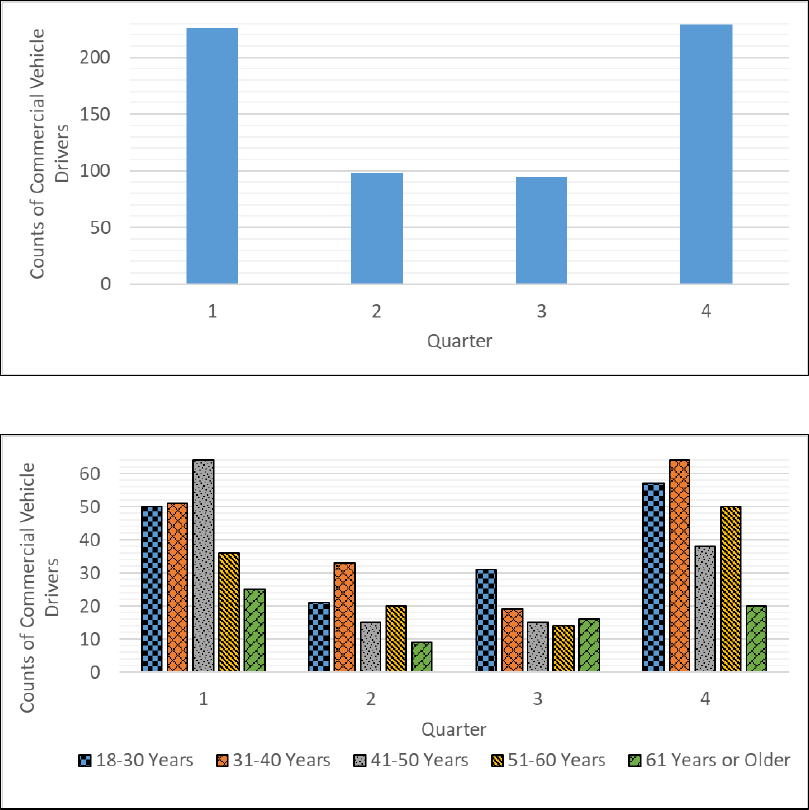
65
crashes, respectively. The maps were generated using the same procedure implemented to obtain
the ones for WSBC, WHP and WASCOP.
Figure 74: 2019 counts of commercial vehicle drivers cited at the crash scenes.
Figure 75: 2019 counts of commercial vehicle drivers cited at the crash scenes by age.
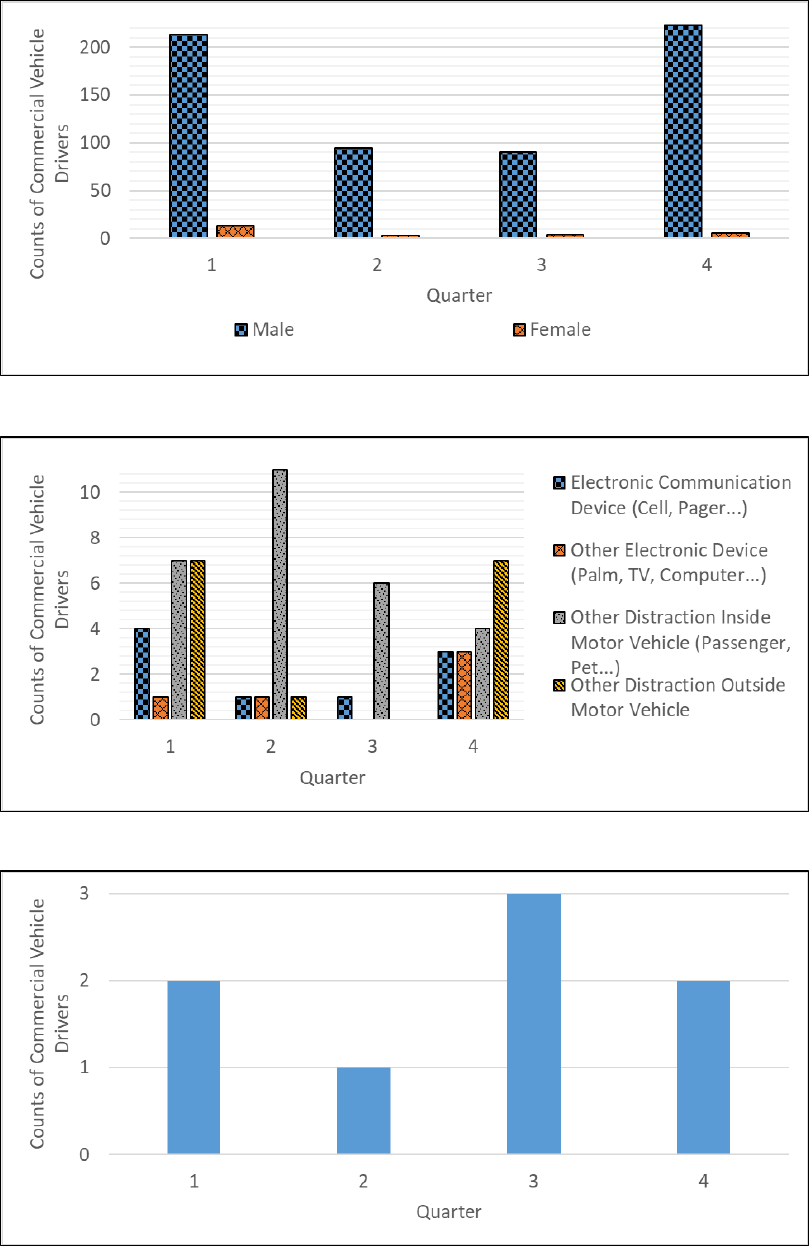
66
Figure 76: 2019 counts of commercial vehicle drivers cited at the crash scenes by gender.
Figure 77: 2019 counts of distracted commercial vehicle drivers by means of distraction.
Figure 78: 2019 counts of commercial vehicle drivers driving under the influence.

67
Figure 79: 2019 counts of improperly belted or unbelted commercial vehicle drivers.
Figure 80: 2019 counts of cited commercial vehicle drivers at the crash scenes by state.
Figure 81: 2019 counts of speeding commercial vehicle drivers.

68
Figure 82: 2019 counts of commercial vehicle crashes by lighting condition.
Figure 83: 2019 counts of killed and injured commercial vehicle drivers.
Figure 84: 2019 counts of killed and injured commercial vehicle passengers.
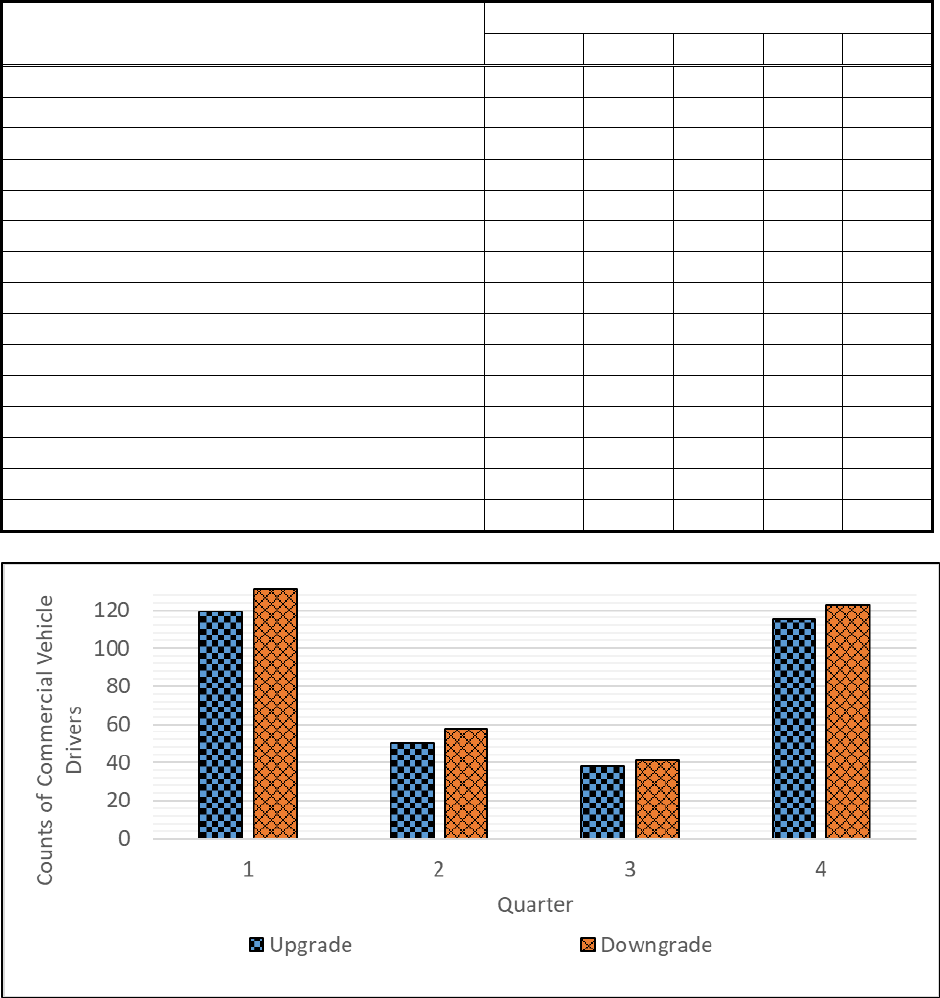
69
Table 11: 2019 Counts of Commercial Vehicle Crashes by Manner of Collision
Figure 85: 2019 counts of upgrade and downgrade conditions facing commercial vehicle
drivers.
Manner of Collision
Quarter
1
2
3
4
Total
Angle (Front to Side), Opposing Direction
20
18
9
17
64
Angle Direction Not Specified
1
0
0
2
3
Angle Right (Front to Side, includes Broadside)
28
10
12
22
72
Angle Same Direction (Front to Side)
36
21
17
45
119
Head On (Front to Front)
5
4
4
10
23
Rear End (Front to Rear)
343
113
106
291
853
Rear to Front (Normally Backing)
91
39
46
84
260
Rear to Rear (Normally Backing)
5
2
5
8
20
Rear to Side (Normally Backing)
0
1
1
0
2
Sideswipe Opposite Direction (Meeting)
2
6
7
6
21
Sideswipe Same Direction (Passing)
14
9
6
11
40
Not a Collision with Two Vehicles in Transport
70
42
47
87
246
Other
11
14
11
14
50
Unknown
0
0
1
0
1
Total
626
279
272
597
1,774

70
Figure 86: 2017 heat map of commercial vehicle crashes.
Figure 87: 2017 heat map of fatal, suspected serious injury and suspected minor injury
commercial vehicle crashes.
71
Other than the previously presented summary statistics, it is suggested that WYDOT conduct
independent studies involving the collection and provision of statistics on the following CMV
drivers’ citation data to WTSC:
• Counts of CMV drivers’ citations by type (i.e. failed to yield the right of way, drove too
fast for the conditions, DUI, driving while tired, violation of storage policies, etc.) in the
form of bar charts
• Proportions of CMV drivers, cited for previous violations, attending drivers’ education
sessions
Finally, the results of the WTSC survey indicated that this group’s members were interested in
research regarding specific CMV related topics. As per the survey’s results, it is suggested that
WYDOT plan for research studies on the following topics:
• Effectiveness of CMV drivers’ DUI enforcement policies
• Effectiveness of CMV speed enforcement policies
• Effectiveness of CMV drivers’ seat belt use enforcement policies
• Effectiveness of other traffic violation enforcement polices related to CMVs (i.e.
improper lane change, red light running, etc.)
• Response times of emergency services particularly for severe (fatal, suspected serious
injury and suspected minor injury) CMV crashes
Summary of the Governor’s Council on Impaired Driving Survey Responses’ Results
A survey was disseminated to members of the Governor’s Council on Impaired Driving and 10
responses were received. The common question asked in all surveys was how often did the
respondents receive/secure road safety data/reports from the WYDOT Highway Safety Office?
More than half of the respondents declared that they often obtained the relevant data from the
WYDOT HSO once a year while some checked the option, “other,” and specified the following:
• “I don’t receive them but would like to.”
• “When requested.”
• “We don’t.”
When it comes to data transfer protocols, the respondents indicated that they received the data
mostly via email and online databases (55 percent and 33 percent, respectively). In the follow-up
question, almost 80 percent indicated that they preferred to receive such data via email. Also, the
respondents were asked whether the current safety data provided to them from the WYDOT
HSO fulfilled their needs on a scale of one (not at all) to five (absolutely). Two thirds claimed
that the data were indeed beneficial (selected four and five). More importantly, the respondents
were asked about the ideal period during which they preferred to receive the crash data from the
dates the crashes occurred. Almost half of the GCID members omitted this question while the
other half provided the following responses:

72
• “Monthly would be fine.”
• “Five [days].”
• “Quarterly.”
• “Two [days].”
• “Fourteen days.”
Regarding the preferred data format, almost 90 percent of the respondents indicated that they
were interested in summary statistics tables, while over 40 percent indicated that they were
interested in figuresm and another 40 percent indicated that they were interested in pie charts.
Note that each respondent was provided the option of specifying multiple data formats from a list
(i.e. checkboxes). The respondents were further asked about the preferred method of portraying
the locations of DUI related crashes. They included the following:
• Narrative descriptions of the locations
• Photos
• Color-coded maps
• Road and milepost information
• GIS coordinates
• Other (please specify)
More than three quarters claimed that they were interested in color-coded maps while two thirds
claimed that they were interested in road and milepost information. The answer choices were
provided in the form of checkboxes such that the respondents might have selected multiple
options. Some respondents also selected the options, “narrative descriptions of the locations” and
“photos.” The respondents were then asked whether they would like to provide any suggestions
regarding the data they would receive. One recommended data on the location of which the
impaired driver drank his or her liquor (home, bar, etc.). Another suggested the delivery of maps
illustrating the locations of driving under the influence busts, crashes, mortalities and other
relevant information without specifying details.
In the following section of the survey, the respondents were asked about road safety reports
pertaining to DUI related crash data. The reports, most of which are available in the WYDOT
HSO website, are the following:
• 2019 Highway Safety Crash Data Survey Final Report
• Wyoming Department of Transportation Highway Safety Behavioral Grants Office 2019
Annual Report
• Wyoming Highway Safety Behavioral Program FY2020 Highway Safety Plan
• Wyoming Report on Traffic Crashes 2019
• Wyoming Statewide Crashes by Year
• Wyoming Statewide Crashes Involving Alcohol or Drugs by Year
• Wyoming Strategic Highway Safety Plan 2017

73
• Wyoming Drivers Survey 2016
• Alcohol and Crime in Wyoming 2019
On a scale of one (not at all) to five (absolutely) describing whether the respondents were
familiar with these reports and whether they frequently utilized them, 40 percent provided ratings
of four and five. Remarkably, more than half declared that the listed reports were beneficial to
GCID even though only 40 percent stated that they used them frequently. Perhaps after being
informed about the reports, members of GCID briefly scanned them and became intrigued about
them. In another question, more than half of the respondents declared that they were satisfied
with the frequency at which the reports were released. Roughly, 40 percent of the respondents
stated that they either did not receive them or would like to receive them on a more frequent
basis. One suggested that the reports be publicized quarterly and another suggested that they be
publicized semi-annually. The respondents were also asked to recommend any reports they
would like to receive in addition to the ones listed. One recommended a report on the statistics of
the locations (bars, etc.) at which drunken drivers consumed their liquor prior to being involved
in DUI related crashes. This would aid members of GCID in targeting such bars in their outreach
campaigns. Another respondent suggested a report with statistics on DUI busts, BAC levels and
locations of parties or concerts involving drinking. Members of GCID were also asked about the
importance of certain summary statistics to be included in the reports. More than half selected
the following:
• Effectiveness of DUI offender rehabilitation campaigns
• Effectiveness of implementing ignition interlocks in vehicles of DUI offenders in
improving road safety
• Effectiveness of media outreach campaigns in raising awareness about DUI (impact and
consequences of impaired diving slogans and/or relevant content disseminated via
the social media, television, radio, billboards)
In the subsequent section of the survey, the respondents were asked specific questions about DUI
related crash data in the form of summary statistics. More than half of them indicated that they
were interested in the following elements collected from crash records:
• Types of substances involved in DUI related crashes (alcohol, marijuana, etc.).
• BACs of impaired at-fault drivers by age and gender.
• Injury severity levels of DUI related crashes by BACs of impaired drivers.
• Whether passengers were impaired at the times of the crashes.
• BACs of the passengers if impaired at the times of the crashes.
• Number of pedestrians and/or bicyclists involved in the DUI related crashes.
• Whether the pedestrians and/or bicyclists were impaired if found to be at-fault.
• BACs of the impaired pedestrians and/or bicyclists at the times of the crashes.
• Whether motorcycles were involved and the riders were impaired at the times of the
crashes.
74
• BACs of the impaired motorcycle riders at the times of the crashes.
• Crash locations (on the road, on the shoulder, off the road, etc.).
• Crash times (morning, afternoon, etc.).
• Vehicle travel speeds preceding the crashes (i.e. too slow for the conditions, reasonable
or too fast for the conditions).
• Makes, models and years of each vehicle involved in the DUI related crashes.
• Number of vehicles involved in the DUI related crashes.
• Whether the impaired at-fault drivers were properly wearing their seat belts at the times
of the crashes.
• Whether the passengers were properly wearing their seat belts at the times of the crashes.
• Whether children were properly secured in their appropriate car seats at the times of the
crashes.
• DUI related crashes resulting in ejected occupants.
• Whether impaired drivers violated work zone regulations (i.e. exceeded the work zones’
speed limits, failed to obey the traffic guards’ signals, etc.).
• Driving errors leading to the DUI related crashes that are not previously listed.
• Number of injured drivers/motorcyclists and their injury severity levels.
• Number of injured passengers and their injury severity levels.
• Number of injured non-motorists and their injury severity levels.
• DUI related crashes that occurred at or near bars and liquor stores.
• DUI related crashes that occurred at or near concerts, sports events or other special
events.
• DUI related crashes that occurred during special holidays/events (4
th
of July, Labor Day
weekend, Thanksgiving, Christmas, etc.).
• DUI related crashes by day of the week (i.e. weekdays versus weekends).
• Types of DUI related crashes (rear-end, sideswipe, etc.).
• Impact point information of vehicles involved in the DUI related crashes (e.g. hit from
the side, hit from the front, etc.).
• Comparisons of fatality/injury counts of victims involved in DUI related crashes versus
those of victims involved in non-DUI related crashes.
• Weather conditions (clear, cloudy, rainy, foggy, snowy) at the times of the DUI related
crashes.
• Road surface conditions (dry, wet, icy, etc.) at the times of the DUI related crashes.
Furthermore, members of GCID were asked about the importance of color-coded maps
presenting locations characterized by risks of encountering DUI related crashes by category.
More than 50 percent of the respondents indicated that they were interested in color-coded maps
illustrating the following DUI related crashes:
• High severity (fatal, suspected serious injury and suspected minor injury) crashes
75
• Possible injury and PDO crashes
• High severity crashes involving improperly buckled or unbuckled occupants
• High severity speed related crashes
The respondents were then directed to another section asking about whether they were interested
in specific information regarding DUI citation and other related data. Similar to the previous
surveys, a disclaimer was presented to inform the respondents that independent studies would
have to be conducted to collect and evaluate citation data since the WYDOT HSO would not
maintain such data. At least half of the respondents maintained that they preferred the following
summary statistics data:
• Citation counts of impaired (DUI, tired or not wearing prescription glasses/contact
lenses) drivers by county
• Citation counts of impaired drivers by age
• Citation counts of impaired drivers by gender
• Number of impaired drivers who persistently violated impairment related policies even
after being subjected to disciplinary action
• Association between impairment related offences and speeding
• Association between impairment related offences and other policy violation types except
speeding (e.g. failure to yield, improper passing, etc.)
• Locations characterized by a considerable number of impairment related citations issued
Finally, the GCID members were asked to select topics they might be interested in for further
investigation (i.e., data analyses, interpretation and documentation of results in reports). At least
three quarters of them were interested in the following topics:
• Effectiveness of DUI enforcement policies
• Effectiveness of impaired drivers’ rehabilitation campaigns
• Effectiveness of other impairment enforcement policies (e.g. tired, not wearing
prescription glasses/contact lenses)
• Effectiveness of educational campaigns addressing impaired driving
• Association between alcohol/drug use and crime
Recommendations for the Wyoming Department of Transportation Regarding the
Governor’s Council on Impaired Driving
Based on the interpretations of the Governors’ Council on Impaired Driving’s survey results,
suggestions were made for WYDOT with regards to the data to be provided to GCID. One is to
disseminate DUI related crash data as soon as they are made available. Another is to provide
processed quarterly DUI crash related data in the form of tables and charts, similar to the ones
presented in Figures 88 to 104, and Tables 12 to 17.
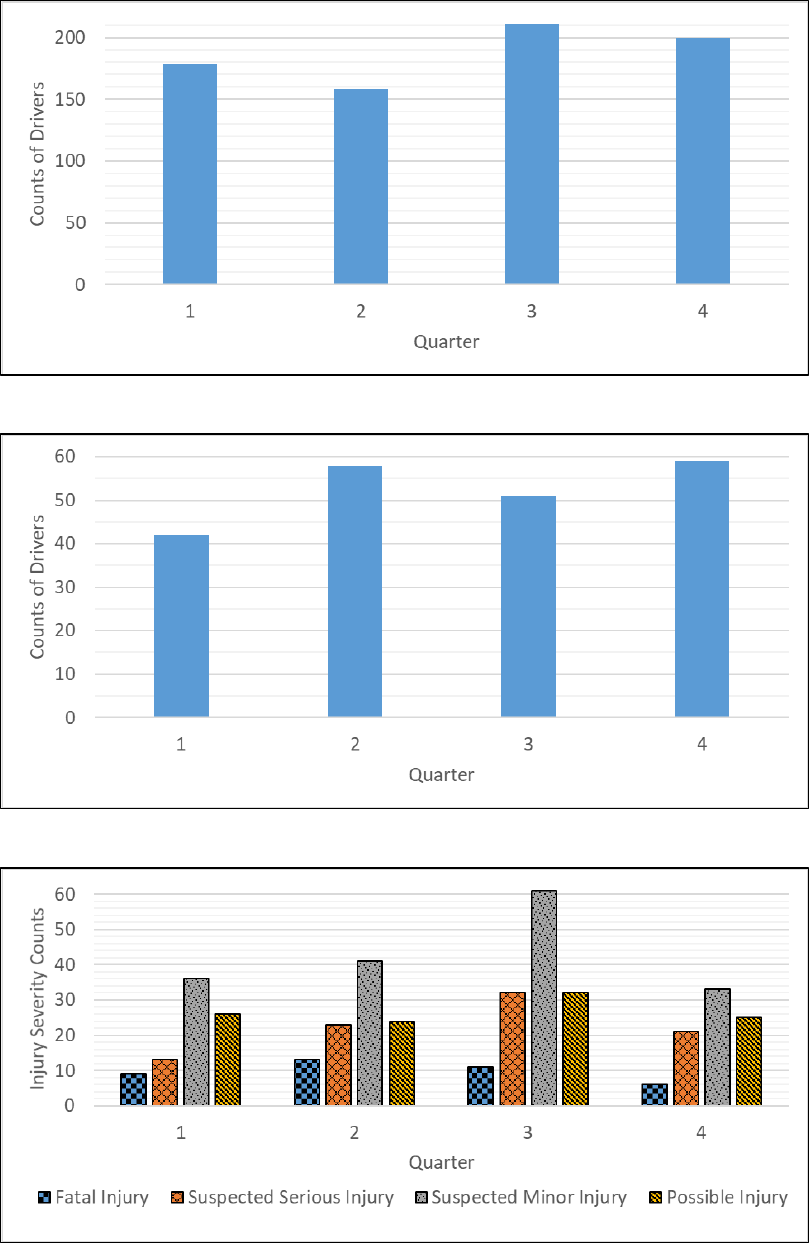
76
Figure 88: 2019 counts of alcohol impaired drivers.
Figure 89: 2019 counts of drug impaired drivers.
Figure 90: 2019 counts of alcohol related fatalities and injuries.
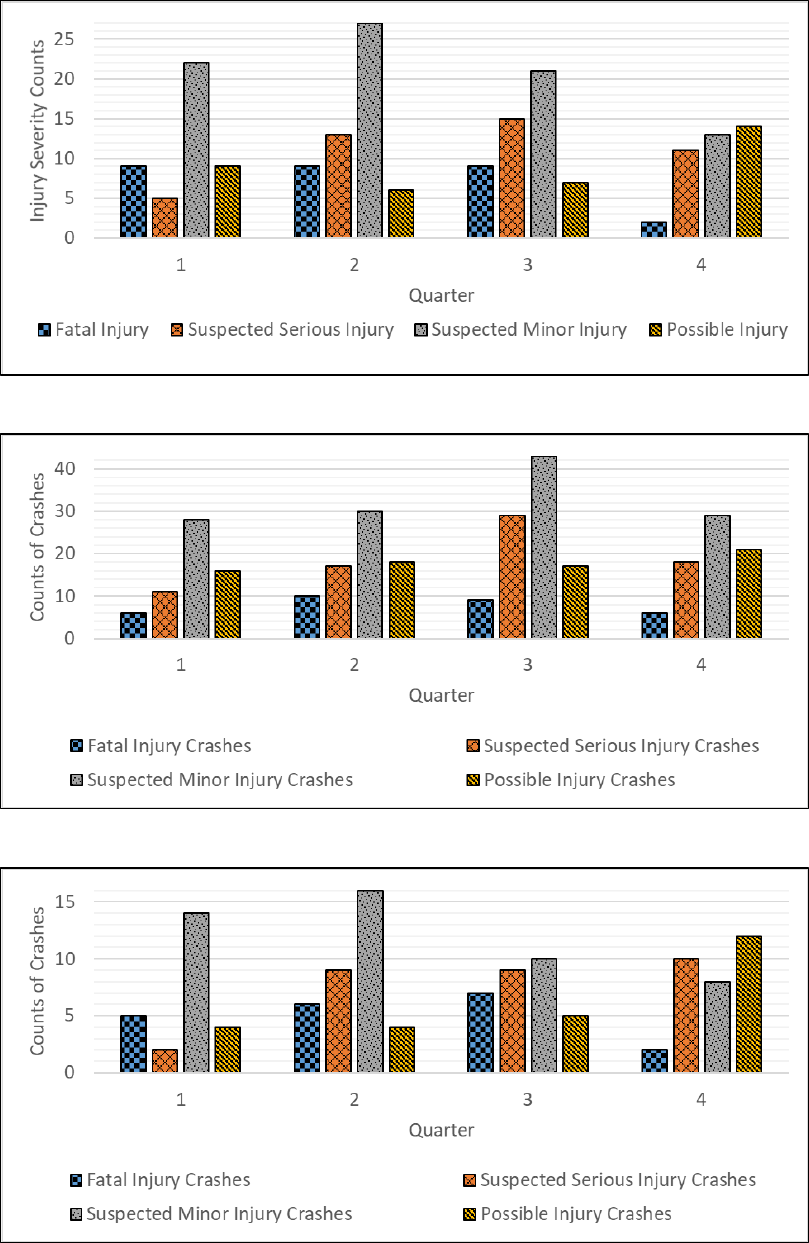
77
Figure 91: 2019 counts of drug related fatalities and injuries.
Figure 92: 2019 counts of alcohol related crashes.
Figure 93: 2019 counts of drug related crashes.
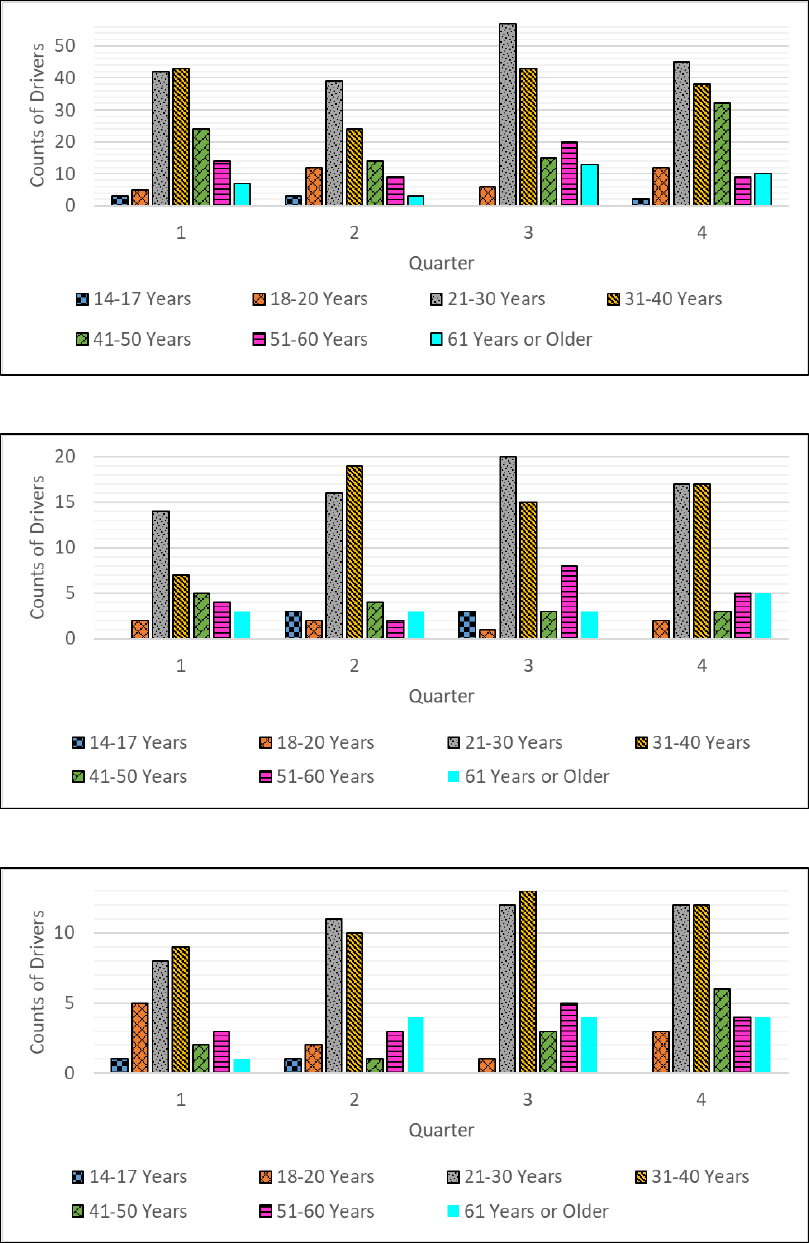
78
Figure 94: 2019 counts of male drivers driving under the influence of alcohol by age.
Figure 95: 2019 counts of female drivers driving under the influence of alcohol by age.
Figure 96: 2019 counts of male drivers driving under the influence of drugs by age.
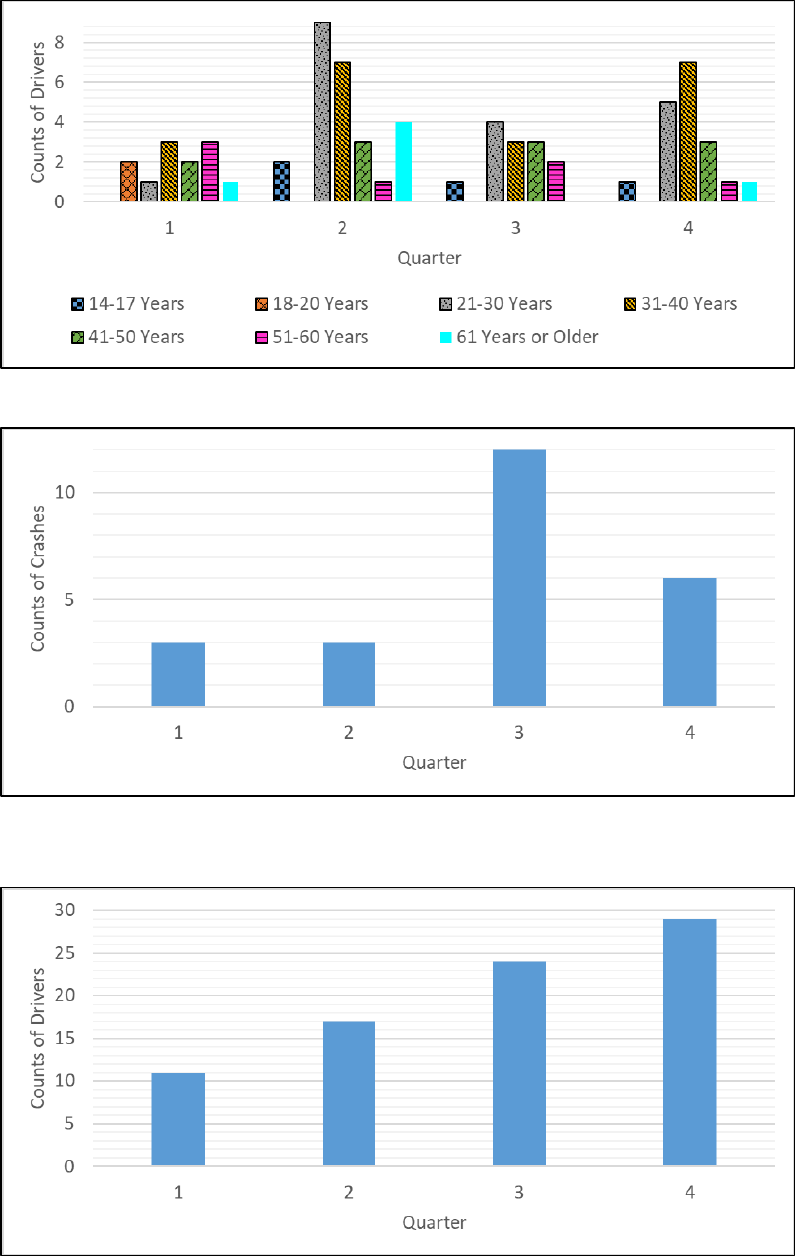
79
Figure 97: 2019 counts of female drivers driving under the influence of drugs by age.
Figure 98: 2019 counts of driving under the influence crashes involving pedestrians and/or
bicyclists.
Figure 99: 2019 counts of driving under the influence crashes involving speeding.
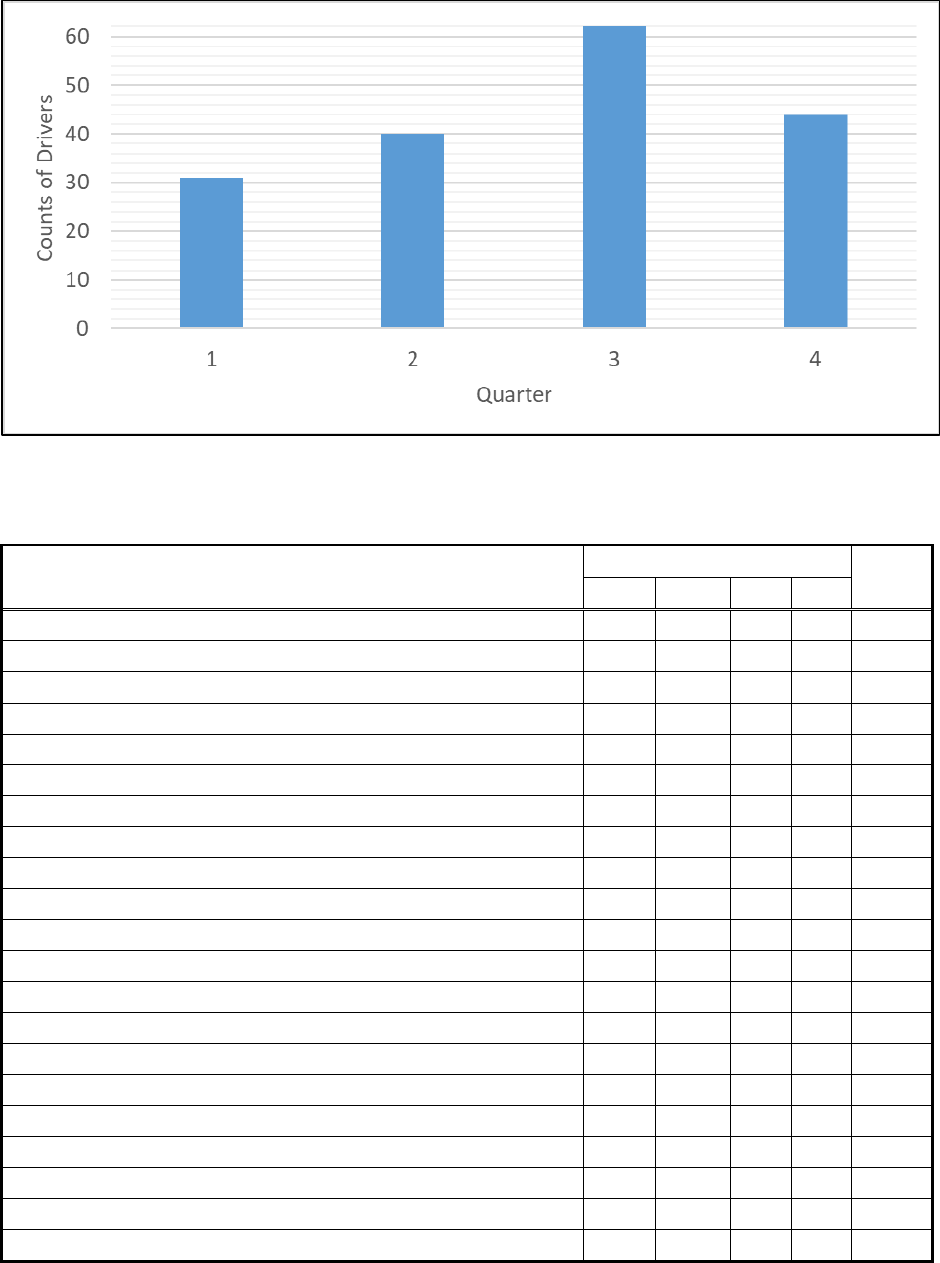
80
Figure 100: 2019 counts of improperly belted or unbelted impaired drivers.
Table 12: 2019 Counts of Impaired Drivers’ Citations Issued at the Crash Scenes
Citation
Quarter
Total
1
2
3
4
Careless Driving
20
31
65
55
171
Disregarding the Officer
2
3
4
5
14
Disregarding the Stop Light
5
8
8
1
22
Disregarding Stop Sign
9
6
13
4
32
Disregard Other
0
0
6
0
6
Drinking - (i.e. Open Container)
30
32
40
52
154
Failed to Grant the Right-of-Way to Other Motor Vehicle
6
10
4
19
39
Following Too Closely
16
13
15
16
60
Hitting-and-Running
62
71
79
103
315
Improper Backing
1
2
4
3
10
Improper Lane Use
83
92
150
120
445
Improper Turn
2
0
0
12
14
Improper or No Signal
0
0
0
2
2
Reckless Driving
13
26
16
42
97
No Insurance
44
94
104
60
302
Driver’s License Violation
31
41
56
37
165
Vehicle Registration Violation
10
5
35
9
59
Vehicular Homicide
0
2
6
1
9
Wrong Side of Road
1
0
1
4
6
Other
64
80
150
100
394
Total
399
516
756
645
2,316

81
Figure 101: 2019 counts of driving under the influence related crashes during special
occasions.
Figure 102: 2019 counts of driving under the influence related crashes by day of the week.

82
Table 13: 2019 Counts of Driving under the Influence Crashes by Manner of Collision in
the First Quarter
Manner of Collision
Fatal
Injury
Suspected
Serious Injury
Suspected
Minor Injury
Possible
Injury
Total
Angle (Front to Side),
Opposing Direction
2 0 2 3 7
Angle, Right (Front to
Side, includes Broadside)
2 1 3 3 9
Angle, Same Direction
(Front to Side)
0 0 3 1 4
Head-On (Front to Front)
2
2
1
1
6
Not a Collision with Two
Vehicles in Transport
2 7 18 2 29
Rear-End (Front to Rear)
0
1
9
10
20
Rear to Front (Normally
Backing)
0 0 0 0 0
Rear to Rear (Normally
Backing)
0 0 0 0 0
Rear to Side (Normally
Backing)
0 0 0 0 0
Sideswipe Opposite
Direction (Meeting)
0 0 0 0 0
Sideswipe Same
Direction (Passing)
0 0 1 0 1
Other
0
0
0
0
0
Total
8
11
37
20
76

83
Table 14: 2019 Counts of Driving under the Influence Crashes by Manner of Collision in
the Second Quarter
Manner of Collision
Fatal
Injury
Suspected
Serious Injury
Suspected
Minor Injury
Possible
Injury
Total
Angle (Front to Side),
Opposing Direction
1 2 1 2 6
Angle, Right (Front to
Side, includes Broadside)
0 1 2 2 5
Angle, Same Direction
(Front to Side)
0 0 0 1 1
Head-On (Front to Front)
2
1
2
0
5
Not a Collision with Two
Vehicles in Transport
8 14 32 12 66
Rear-End (Front to Rear)
0
2
4
2
8
Rear to Front (Normally
Backing)
0 0 0 0 0
Rear to Rear (Normally
Backing)
0 0 1 0 1
Rear to Side (Normally
Backing)
0 0 0 0 0
Sideswipe Opposite
Direction (Meeting)
0 0 2 0 2
Sideswipe Same Direction
(Passing)
0 0 0 0 0
Other
0
1
0
0
1
Total
11
21
44
19
95

84
Table 15: 2019 Counts of Driving under the Influence Crashes by Manner of Collision in
the Third Quarter
Manner of Collision
Fatal
Injury
Suspected
Serious Injury
Suspected
Minor Injury
Possible
Injury
Total
Angle (Front to Side),
Opposing Direction
0 2 2 2 6
Angle, Right (Front to
Side, includes Broadside)
0 4 5 1 10
Angle, Same Direction
(Front to Side)
0 0 1 0 1
Head-On (Front to Front)
4
1
2
1
8
Not a Collision with Two
Vehicles in Transport
7 24 33 10 74
Rear-End (Front to Rear)
1
0
5
6
12
Rear to Front (Normally
Backing)
0 0 0 0 0
Rear to Rear (Normally
Backing)
0 0 0 0 0
Rear to Side (Normally
Backing)
0 0 0 0 0
Sideswipe Opposite
Direction (Meeting)
0 1 1 0 2
Sideswipe Same
Direction (Passing)
0 0 0 1 1
Other
0
0
0
0
0
Total
12
32
49
21
114

85
Table 16: 2019 Counts of Driving under the Influence Crashes by Manner of Collision in
the Fourth Quarter
Manner of Collision
Fatal
Injury
Suspected
Serious Injury
Suspected
Minor Injury
Possible
Injury
Total
Angle (Front to Side),
Opposing Direction
0 3 2 6 11
Angle, Right (Front to
Side, includes Broadside)
1 2 3 4 10
Angle, Same Direction
(Front to Side)
0 0 1 0 1
Head-On (Front to Front)
1
0
3
1
5
Not a Collision with Two
Vehicles in Transport
4 15 20 12 51
Rear-End (Front to Rear)
0
1
2
5
8
Rear to Front (Normally
Backing)
0 0 0 0 0
Rear to Rear (Normally
Backing)
0 0 0 0 0
Rear to Side (Normally
Backing)
0 0 0 0 0
Sideswipe Opposite
Direction (Meeting)
0 0 0 1 1
Sideswipe Same
Direction (Passing)
1 0 1 0 2
Other
0
0
0
0
0
Total
7
21
32
29
89

86
Table 17: 2019 Counts of Driving under the Influence Crashes by Manner of Collision
Manner of Collision
Fatal
Injury
Suspected
Serious Injury
Suspected
Minor Injury
Possible
Injury
Total
Angle (Front to Side),
Opposing Direction
3 7 7 13 30
Angle, Right (Front to
Side, includes Broadside)
3 8 13 10 34
Angle, Same Direction
(Front to Side)
0 0 5 2 7
Head-On (Front to Front)
9
4
8
3
24
Not a Collision with Two
Vehicles in Transport
21 60 103 36 220
Rear-End (Front to Rear)
1
4
20
23
48
Rear to Front (Normally
Backing)
0 0 0 0 0
Rear to Rear (Normally
Backing)
0 0 1 0 1
Rear to Side (Normally
Backing)
0 0 0 0 0
Sideswipe Opposite
Direction (Meeting)
0 1 3 1 5
Sideswipe Same
Direction (Passing)
1 0 2 1 4
Other
0
1
0
0
1
Total
38
85
162
89
374

87
Figure 103: 2017 heat map of driving under the influence crashes.
Figure 104: 2017 heat map of driving under the influence fatal, suspected serious injury
and suspected minor injury crashes.
88
It is also recommended that WYDOT plan for the following research studies:
• Effectiveness of DUI enforcement policies
• Effectiveness of impaired drivers’ rehabilitation campaigns
• Effectiveness of other impairment enforcement policies (e.g. tired, not wearing
prescription glasses/contact lenses)
• Effectiveness of educational campaigns addressing impaired driving
• Association between alcohol or drug use and crime
Summary of Wyoming’s Counties Survey Responses’ Results
A survey was disseminated to officials in Wyoming’s counties and 10 responses were received
from multiple jurisdictions scattered around the state. The common question asked in all surveys
was how often did the respondents receive/secure road safety data/reports from the WYDOT
HSO? Ninety percent of the respondents indicated that they often obtained the relevant road
safety information from the Wyoming Technology Transfer Center, which collaborates with the
WYDOT HSO, once a year. The remaining 10 percent indicated that they received the data once
every six months. In the follow-up question, there were mixed responses regarding the ideal
reporting period. Forty percent declared that they were willing to receive the data semi-annually,
30 percent indicated that they were willing to receive the data annually through the Wyoming
Technology Transfer Center, and 20 percent indicated that they were willing to receive the
information once a month. One respondent, comprising the remaining 10 percent, stated that he
or she was willing to receive the road safety data as soon as the crashes occurred. That is to
conduct road safety evaluations and propose mitigation measures promptly.
When it comes to data transfer protocols, the respondents declared that they secured reports/data
mostly via mail and email (80 percent and 60 percent, respectively). The answer choices were
provided in the form of checkboxes. In the subsequent question, most respondents indicated that
they preferred receiving the reports/data via email. Also, the respondents were asked whether the
current safety data provided to them fulfilled their needs on a scale of one (not at all) to five
(absolutely). Sixty percent selected the options four and five. Regarding the preferred data
format, more than half of the respondents selected the options, “pie charts/bar charts,” “summary
statistics tables,” “figures” and “GIS maps.” Note that the answer choices were provided as
checkboxes to allow the respondents to select multiple choices. Furthermore, the counties’
officials were asked to provide any suggestions regarding the data or reports they would receive.
One suggested that it would be beneficial to provide the data they needed in a GIS format such
that the records would be efficiently incorporated into their GIS inventory and another
recommended creating an email list for the prompt sharing of crash information whenever a
crash would occur.
In the following section of the survey, the counties’ officials were asked about road safety
reports pertaining to crash data. The reports, most of which are available in the WYDOT HSO
website, are the following:

89
• 2019 Highway Safety Crash Data Survey Final Report
• Wyoming Department of Transportation Highway Safety Behavioral Grants Office 2020
Annual Report
• Wyoming Highway Safety Behavioral Program FY2021 Highway Safety Plan
• Wyoming Report on Traffic Crashes 2019
• Wyoming Drivers Survey 2016
• 2020 Wyoming Statewide Seatbelt Survey Data Analysis
• Wyoming Statewide Crashes by Year
• Wyoming Statewide Speed Related Crashes by Year
• Wyoming Statewide Crashes Involving a Wild Animal by Year
• Wyoming Statewide Occupant Seat Belt Usage by Year
• Wyoming Statewide Crashes Involving a Pedestrian by Year
• Wyoming Statewide Crashes Involving Alcohol or Drugs by Year
• Wyoming Statewide Crashes Involving Commercial Motor Vehicles by Year
• Wyoming Statewide Distracted Driving Crashes by Year
• Wyoming Strategic Highway Safety Plan 2017
On a scale of one (not at all) to five (absolutely) describing whether the respondents were
familiar with these reports and whether they frequently used them, more than half provided a
rating of three, less than 15 percent provided a rating of four, and none provided a rating of five.
In another question, the respondents were asked about the usefulness of the listed reports and
half indicated that such reports were beneficial. Also, all respondents declared that they were
satisfied with the frequency at which the reports were released.
The county officials were then asked specific questions about the importance of incorporating
specific road safety summary statistics data in the listed reports. At least half of them indicated
that they were interested in the following crash statistics:
• Drivers’ improper actions/error information preceding the crashes (e.g. driving too fast,
improper passing, following too closely, etc.)
• Aggressiveness of drivers who were at-fault in traffic crashes
• Truck safety and truck policy violations at the times of the crashes (exceeded weight
limit, improperly secured hazardous materials, etc.)
• Animal crash hot spots
In the subsequent section of the survey, the county officials were asked specific questions about
crash data. At least half of them indicated that they were interested in the following data
collected from crash records:
• Crash locations (on the road, on the shoulder, off the road, etc.)
• Crash times (morning, afternoon, etc.)
• Weather conditions at the times of the crashes

90
• Vehicle travel speeds preceding the crashes (i.e. too slow for the conditions, reasonable
or too fast for the conditions)
• Number of vehicles involved in the crashes
• Number of pedestrians and/or bicyclists involved in the crashes
• Types of animals involved in the crashes
• Whether the drivers were properly wearing their seat belts at the times of the crashes
• Whether the passengers were properly wearing their seat belts at the times of the crashes
• Whether children were properly secured in their appropriate car seats at the times of the
crashes
• Whether the drivers were driving under the influence of alcohol/drugs at the times of the
crashes
• Whether the drivers were tired at the times of the crashes
• Motorcycle crashes
• Whether work zone plans were implemented according to the standards when the crashes
occurred at or near the work zones
• Whether workers were present when the crashes occurred at or near the work zones
• Shoulder and lane closure information when the crashes occurred at or near the work
zones
• Whether drivers violated work zone regulations giving rise to the crashes (i.e. exceeded
the work zones’ speed limits, failed to obey the traffic guards’ signals, etc.)
• Number of injured drivers/motorcyclists and their injury severity levels
• Number of injured passengers and their injury severity levels
• Number of injured non-motorists and their injury severity levels
• Crash types (rear-end, sideswipe, etc.)
• Impact point information of vehicles involved in the crashes (e.g. hit from the side, hit
from the front, etc.)
• DUI related crashes by day of the week (i.e. weekdays versus weekends)
• Injury severity levels of DUI related crashes by BAC level of impaired drivers
• Crashes on roads with challenging geometric conditions (steep upgrades, steep
downgrades, etc.)
• Crashes involving distractions by distraction method (use of electronic device, picking up
an object from the vehicle’s floor, etc.)
• Crash locations by injury severity level and lighting conditions (daylight, dawn, dark with
street lighting, etc.) at the times during which the crashes occurred
• Crash locations by injury severity level and road surface conditions (dry, wet, icy, snowy,
etc.) at the times during which the crashes occurred
In the subsequent section, the county officials were asked about the importance of color-coded
maps presenting locations characterized by risks of encountering certain types of crashes. At
least half of the respondents declared that they were interested in maps presenting the following:
91
• High severity (fatal, suspected serious injury and suspected minor injury) crashes
• High severity crashes that occurred in the presence of adverse weather conditions (snow,
fog, rain, etc.)
• High severity crashes where visual obstructions (vegetation, hill crests, sun glare,
headlight glare, other vehicles, animals, fog, snow showers, etc.) posed hazards
• High severity crashes involving improperly buckled or unbuckled occupants
• High severity DUI related crashes
• High severity speed related crashes
In the second to the last question, the officials of Wyoming’s counties were asked to select topics
they might be interested in for research from a list. At least half selected the following topics:
• Safety of low-volume paved and unpaved roads
• Assessing and updating strategic county road safety plans
• Optimization of road safety improvement budgets
• Effectiveness of speed enforcement policies
• Changes in Wyoming’s road fatality toll rates (fatalities per hundred million vehicle-
miles traveled) throughout the years
Finally, the respondents were asked whether they would like to provide any recommendation
regarding the data they would receive in general. One suggested the provision of the GIS
coordinates of the crash locations since he or she would typically receive narrative descriptions
of the locations, which would otherwise be considered as imprecise.
Recommendations for the Wyoming Department of Transportation Regarding Wyoming’s
Counties
Based on the interpretations of the Wyoming counties’ survey responses, it is suggested that
WYDOT establish an email list for sharing road safety data with the counties on a quarterly
basis. With that, it would also be beneficial that WYDOT communicate with the county officials
regarding whether some would be willing to receive such data within a shorter period after the
occurrences of crashes. The data, recommended for Wyoming’s counties in the form of
plots/tables, would be similar to those which were suggested for WHP and WASCOP (Figures
26 through 73, and Tables Table 6 through 10). Furthermore, since it was inferred from the
counties’ survey results that the county officials were interested in pedestrian injury and fatality
statistics, it is recommended to provide such data to Wyoming’s counties. Pedestrian casualty
statistics would be provided in the form similar to that depicted in Figure 105.

92
Figure 105: 2019 counts of killed and injured pedestrians.
In addition, it is suggested that WYDOT plan for conducting research on the following topics:
• Safety of low-volume paved and unpaved roads
• Assessing and updating strategic county road safety plans
• Optimization of road safety improvement budgets
• Effectiveness of speed enforcement policies
• Changes in Wyoming’s road fatality toll rates throughout the last decade
Summary of the Wyoming Bicycle and Pedestrian System Task Force Survey Responses’
Results
A survey was circulated among members of the Wyoming Bicycle and Pedestrian System Task
Force and other interested parties. The survey asked about the frequency at which WBPSTF
were receiving non-motorist safety data, whether members of WBPSTF were utilizing relevant
safety reports available in the WYDOT HSO website, additional data needed and non-motorist
safety topics WBPSTF might be interested in for research. Three responses were received.
In the first section of the survey, WBPSTF members were asked how often they received
pedestrian/bicycle safety data from the WYDOT HSO. One respondent declared that he or she
received them once every six months. Another indicated that her or she never received such data
unless the data were requested, and the third stated that he or she never received the data. In the
results of the following question, which included answer choices provided in the form of
checkboxes, one respondent declared that he or she would receive non-motorist safety data via
online databases or reports. The option “email,” was also selected. More importantly, one of the
respondents stated that he or she would solicit non-motorist safety data and they would be
provided in an Excel pdf format. The third question asked about the preferred means of data
delivery and, similar to the previous question, checkboxes were provided to the respondents.
93
Two thirds of the respondents selected the options, “online databases and/or reports” and
“email.” The subsequent question asked whether the non-motorist safety data fulfilled the needs
of WBPSTF on a scale of one (not at all) to five (absolutely). Two respondents checked the
option “two” and the third selected the option “four.” When it comes to the number of days it
would take for the respondents to receive the safety data from the dates non-motorist crashes
occurred, one respondent indicated that this duration would be a week. Another indicated one to
two days, and the third preferred a duration less than a week. With that, the respondents stated
that these were ideal reporting periods. The respondents also declared that they would prefer
summary statistics tables and figures as means of presenting pedestrian/bicycle safety data.
Furthermore, it was interpreted that the respondents would like the locations of pedestrian and
bicycle crashes to be portrayed via narrative descriptions, GIS coordinates or heat maps. At the
end of the first section of the survey, the respondents were asked to provide any additional
feedback. One suggested the provision of non-motorist facility budget information. That is, when
pedestrian and bicycle casualties become substantial, it would be beneficial to have budget
reports handy in order to plan for improving non-motorist safety accordingly. Another
respondent recommended the provision of more accurate GIS coordinates of the locations of
pedestrian and bicycle crashes.
In the second section of the survey, the respondents were asked about the following reports:
• Wyoming Statewide Crashes Involving a Pedestrian by Year
• Wyoming Strategic Highway Safety Plan
• 2019 Wyoming Department of Transportation Highway Safety Behavioral Grants Office
Annual Report
• 2019 Highway Safety Crash Data Survey Final Report
• Cyclist and Pedestrian Accident Statistics for Wyoming
• Wyoming Highway Safety Behavioral Program FY2020 Highway Safety Plan
• Wyoming Report on Traffic Crashes 2019
• Wyoming Bicycle & Pedestrian Transportation Plan
• Bicycle Friendly State Report Card Wyoming
• Wyoming Active Transportation Webinar Series
• A Resident's Guide for Creating Safer Communities for Walking and Biking
• Urban Bikeway Design Guide
The respondents were asked whether they were familiar with the aforementioned reports and
frequently utilized them. Only one declared that he or she utilizes most of those reports often and
that they were beneficial. Regarding the frequency at which the reports were released, one
respondent indicated that he or she was satisfied with such frequency. At the end of the survey’s
second section, the responds were asked to include any additional reports that might be of benefit
to them. One respondent suggested a report of pedestrian and bicycle safety budgets.
94
The third section of the survey was aimed at specific questions concerning non-motorist safety
data in which the respondents might be interested. At least two of the three respondents were
interested in the following summary statistics data collected from crash records.
• Pedestrian/bicycle crash types (sideswipe, right turn at intersection, dooring, etc.)
• Whether any road users, involved in the pedestrian/bicycle crashes, were using an
electronic device or distracted by any other means
• Whether the bicyclists were wearing helmets at the times of the crashes
• Pedestrian/bicycle crash locations (intersections, mid-block locations, road shoulders or
parking lots)
• Whether the drivers maintained an adequate distance between their vehicles and the
bicyclists on the shoulder or bicycle lane
• Whether the pedestrian/bicycle crashes occurred within school zones
• Traffic violation details at the times of the pedestrian/bicycle crashes
• Weather conditions at the times of the pedestrian/bicycle crashes (clear, cloudy, foggy,
rainy, snowy etc.)
• Road surface conditions at the times of the pedestrian/bicycle crashes (dry, wet, icy,
snowy or slushy)
• Crash times
In addition, two respondents declared that they agreed that non-motorist injury severity levels
(fatal, suspected serious injury, suspected minor injury and possible injury) should be further
categorized. Also, one respondent indicated that he or she would be interested in color-coded
maps depicting the high-risk non-motorist crash locations.
The third section of the survey comprised questions about miscellaneous topics regarding non-
motorists. The respondents were asked to select the type of summary statistics citation data in
which they were willing to receive. Yet, a disclaimer was incorporated stating that the WYDOT
HSO would not maintain citation data and, hence, independent studies would have to be
conducted on such data if needed. At least two of the three respondents indicated that they would
like to receive summary statistics data on the following:
• Traffic violations posing hazards to pedestrians and bicyclists (e.g. failure to yield the
right-of-way to pedestrians and bicyclists)
• Whether drivers, cited for previous violations against pedestrians and bicyclists, attended
drivers’ education sessions
• Whether pedestrians/bicyclists, cited for previous violations, attended traffic education
sessions
Other than citation data, two of the three respondents stated that they were interested in
information on projects geared towards providing pedestrian and bicyclist friendly facilities (e.g.
95
providing a designated bicycle lane or widening a sidewalk, etc.). Also, at least two respondents
recommended that the WYDOT HSO carry out research on the following topics:
• Assessing the adequacy of the existing pedestrian and bicycle infrastructure
• Assessing the health benefits of walking and biking
• Assessing the economic impact of walking and biking; this would include special bicycle
events
• Assessing the environmental impact of walking and biking
Recommendations for the Wyoming Department of Transportation Regarding the
Wyoming Bicycle and Pedestrian System Task Force
Based on the Wyoming Bicycle and Pedestrian System Task Force’s survey results, noteworthy
recommendations are made for WYDOT. As such, it is recommended that WYDOT deliver non-
motorist crash data to WBPSTF as promptly as the data become available. It is also suggested
that WYDOT share information with the group regarding its bicycle and pedestrian facility
budgets, especially when having a considerable rate of non-motorist crashes. Other suggestions
include disseminating a survey to schools asking about school zone and school bus safety
concerns from the viewpoints of non-motorists. Another survey may be circulated among
bicyclists asking about their safety concerns. Both surveys’ results would be documented in
official reports and shared with WBPSTF. In addition, it is recommended that WYDOT provide
quarterly summary statistics of non-motorist crash data, similar to the ones presented in Figures
99 through 116, and Table 18. Note that Figure 116, which is a heat map of non-motorist
crashes, was produced using the 2017 data since this was the latest year during which accurate
GIS coordinates of the crash locations were provided. The mapping procedure implemented was
the same as that employed for generating the heat maps of the other road safety groups.

96
Figure 106: 2019 counts of pedestrian and bicycle crashes.
Figure 107: 2019 counts of killed and injured pedestrians.
Figure 108: 2019 counts of killed and injured bicyclists.

97
Table 18: 2019 Counts of Pedestrian and Bicycle Crashes by Manner of Collision
Manner of Collision
Quarter
Total
1
2
3
4
Angle (Front to Side), Opposing Direction
1
1
1
1
4
Angle, Direction Not Specified
0
0
0
1
1
Angle, Right (Front to Side, includes Broadside)
0
0
0
1
1
Angle, Same-Direction (Front to Side)
3
4
0
2
9
Head-On (Front to Front)
0
0
0
1
1
Not a Collision with Two Vehicles in Transport
19
26
51
31
127
Rear-End (Front to Rear)
6
4
4
9
23
Rear to Front (Normally Backing)
0
1
1
4
6
Rear to Rear (Normally Backing)
1
1
0
0
2
Rear to Side (Normally Backing)
1
1
1
0
3
Sideswipe-Opposite Direction (Meeting)
0
1
2
0
3
Sideswipe-Same Direction (Passing)
7
4
7
10
28
Other
2
0
0
0
2
Total
40
43
67
60
210
Figure 109: 2019 counts of distracted drivers involved in pedestrian and/or bicycle crashes.
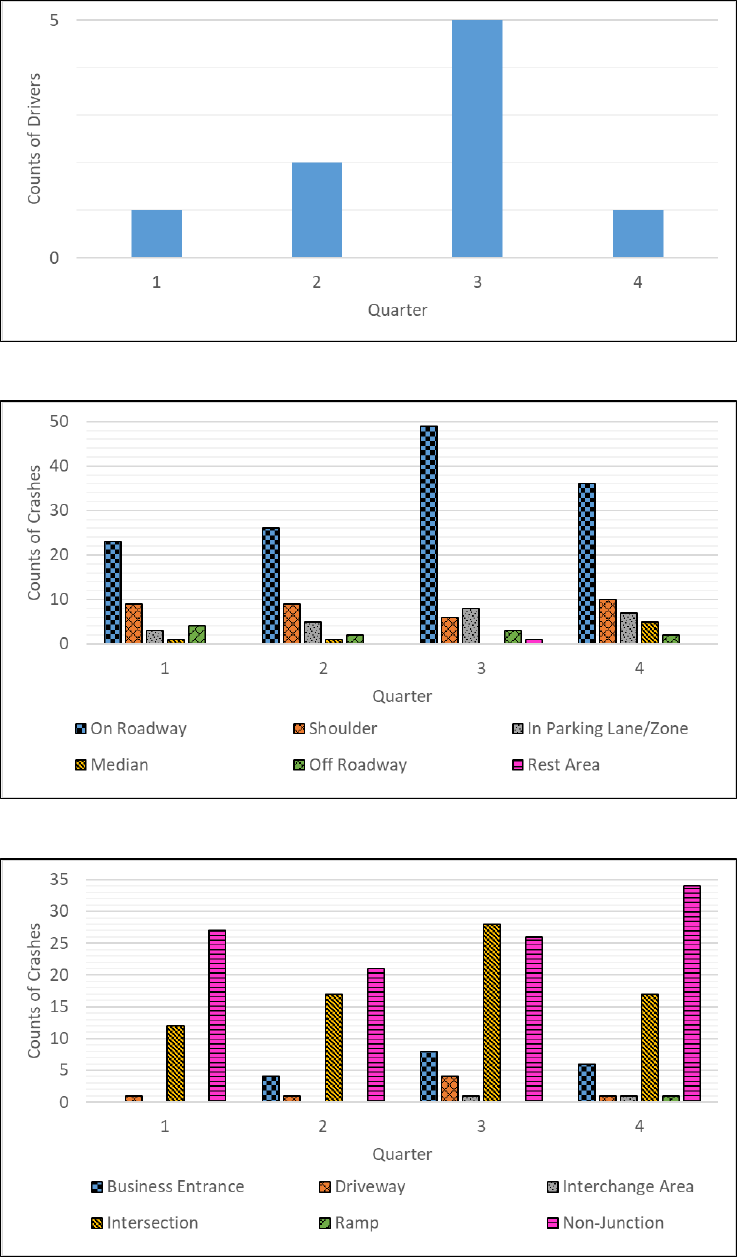
98
Figure 110: 2019 counts of impaired drivers involved in pedestrian and/or bicycle crashes.
Figure 111: 2019 counts of pedestrian and bicycle crashes by first harmful event location.
Figure 112: 2019 counts of pedestrian and bicycle crashes for segments and junctions.

99
Figure 113: 2019 counts of pedestrian and bicycle crashes by weather condition.
Figure 114: 2019 counts of pedestrian and bicycle crashes by road surface condition.
Figure 115: 2019 counts of pedestrian and bicycle crashes by lighting condition.
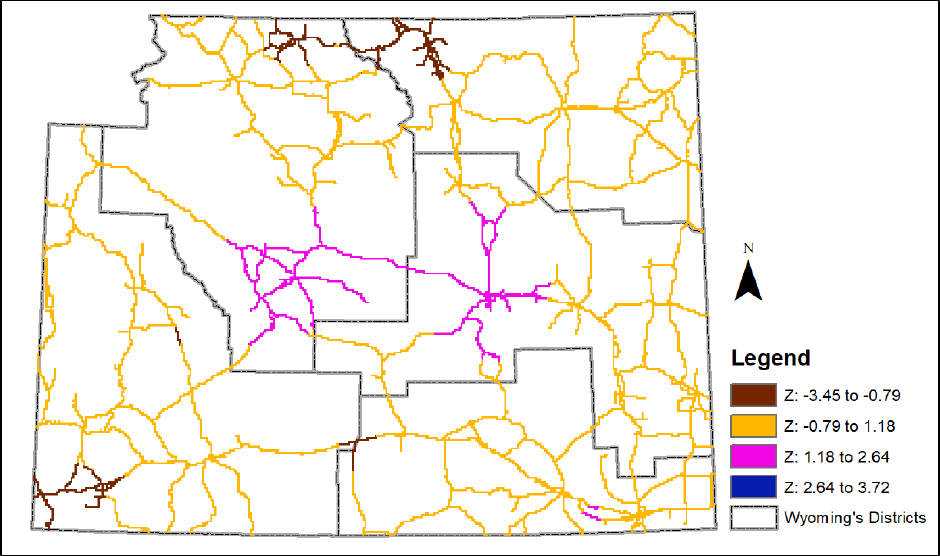
100
Figure 116: 2017 heat map of pedestrian and bicycle crashes.
Another suggestion is to conduct independent studies to collect, summarize and present data of
the following:
• Citations issued to drivers for posing hazards to pedestrians and bicyclists (e.g. failure to
yield the right-of-way to pedestrians and bicyclists)
• Whether drivers, cited for previous violations against pedestrians and bicyclists, attended
drivers’ education sessions
• Whether pedestrians/bicyclists, cited for previous violations, attended traffic education
sessions
Other than the citation data suggestions, it would be recommended that WYDOT plan for
research on the following topics:
• Assessing the adequacy of the existing pedestrian and bicycle infrastructure
• Assessing the health benefits of walking and biking
• Assessing the economic impact of walking and biking; this would include special bicycle
events
• Assessing the environmental impact of walking and biking
Summary of the Results of the Motorcycle Groups’ Survey
A survey was distributed to multiple motorcycle groups, including the Wyoming Central
ABATE and the Harley-Davidson motorcycle groups. Yet, no responses were received after
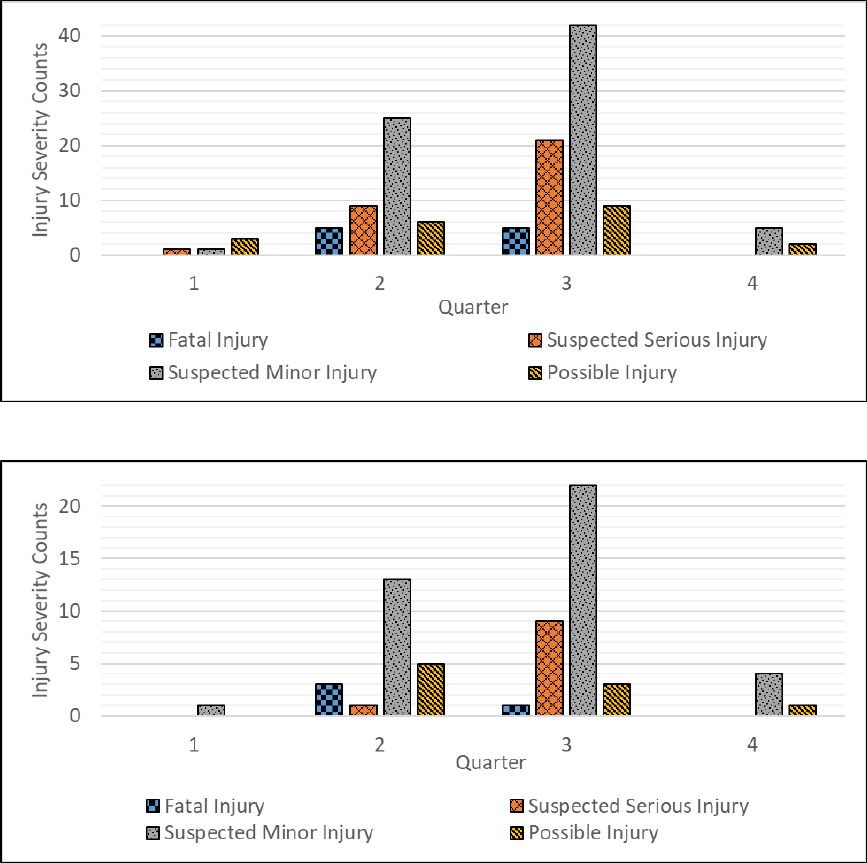
101
multiple attempts to reach out to the groups. Therefore, recommendations were made to
WYDOT concerning the provision of pertinent road safety data to the motorcycle groups in the
state based on experiential knowledge and a prior reasoning.
Recommendations for the Wyoming Department of Transportation Regarding the
Motorcycle Groups
It is recommended that WYDOT provide quarterly summary statistics data extracted from
motorcycle crash records to motorcycle groups in Wyoming. The data would be similar to those
presented in Figures 117 through 130, and Tables 19 and 20, which belonged to 2019. It should
be noted that Figure 130 presents a map of motorcycle crash hot spots representative of the year
2017 since this was the most recent year during which precise GIS coordinates of crash locations
were available.
Figure 117: 2019 counts of killed and injured motorcycle operators.
Figure 118: 2019 counts of killed and injured motorcycle operators wearing helmets.

102
Figure 119: 2019 counts of killed and injured motorcycle operators not wearing helmets.
Figure 120: 2019 counts of killed and injured motorcycle passengers.
Figure 121: 2019 counts of killed and injured motorcycle passengers wearing helmets.

103
Figure 122: 2019 counts of killed and injured motorcycle passengers not wearing helmets.
Figure 123: 2019 counts of killed and injured motorcycle operators by age in the first
quarter.
Figure 124: 2019 counts of killed and injured motorcycle operators by age in the second
quarter.

104
Figure 125: 2019 counts of killed and injured motorcycle operators by age in the third
quarter.
Figure 126: 2019 counts of killed and injured motorcycle operators by age in the fourth
quarter.

105
Table 19: 2019 Counts of Motorcycle Crashes by Manner of Collision
Table 20: 2019 Counts of Citations Issued to Motorcycle Operators at the Crash Scenes
Manner of Collision
Quarter
Total
1
2
3
4
Angle (Front to Side), Opposing Direction
0
3
4
0
7
Angle Right (Front to Side, includes Broadside)
2
4
4
0
10
Angle Same Direction (Front to Side)
1
1
0
0
2
Head On (Front to Front)
0
1
3
0
4
Rear End (Front to Rear)
0
3
12
1
16
Sideswipe Opposite Direction (Meeting)
0
1
1
0
2
Sideswipe Same Direction (Passing)
1
2
1
0
4
Not a Collision with Two Vehicles in Transport
3
37
68
7
115
Other
0
2
0
0
2
Total
7
54
93
8
162
Citation
Quarter
Total
1
2
3
4
Exceeding the Speed Limit
0
0
1
0
1
Failed to Grant Right-of-Way to Motor Vehicle
0
0
2
0
2
Following Too Closely
0
0
5
0
5
Improper Lane Use
0
1
4
0
5
Improper Passing
1
0
1
0
2
Improper Turning
0
1
0
0
1
Disregarding the Stop Sign
0
1
0
0
1
Careless Driving
0
5
3
0
8
Reckless Driving
0
1
1
1
3
Disregard the Officer
0
1
1
0
2
Hitting-and-Running
0
1
0
0
1
Driver's License Violation
1
9
11
1
22
No Insurance
2
5
7
1
15
Vehicle Registration Violation
1
1
6
1
9
Other
1
2
6
0
9
Total
6
28
48
4
86

106
Figure 127: 2019 counts of impaired motorcycle operators.
Figure 128: 2019 counts of motorcycle crashes by first harmful event location.
Figure 129: 2019 counts of motorcycles involved in horizontal curve related crashes.

107
Figure 130: 2017 heat map of motorcycle crashes.

108
CHAPTER 4: IDENTIFYING CRITICAL HUMAN FACTORS AND APPROPRIATE
CRASH DATA REPORTING TIME FRAMES
The second objective of this study was to identify the human factors influencing road safety in
Wyoming and crash data reporting periods by employing advanced big data analytics methods.
An analysis was conducted to assess the impact of several human factors on crash severity in
Wyoming via logistic regression and random forest modeling. Ascertaining appropriate periods
to share road safety data is equally important. That is to diagnose road safety concerns and
address them promptly. For instance, if crashes of which data were delivered to WYDOT’s
partner groups six months after their occurrences, the groups may identify specific problems,
such as low seat belt use rates among a specific age group, at a belated time. Yet, as per the
survey results of most groups, it is preferred that crash data from police reports be circulated at
WYDOT’s earliest convenience in addition to the sharing of processed quarterly road safety data
summary statistics. Nevertheless, analyses were conducted to detect variations in crash counts
throughout the days in order to ascertain appropriate road safety data delivery periods.
Identifying the Critical Human Factors
Multiple human factors were examined, including the driver’s age, the driver’s gender, driving
too fast for the conditions, safety restraint use status, driving recklessly, driving under the
influence of alcohol or drugs, driving while distracted, driving while exhausted or sleepy and
leaving the crash scene. A sample of crash records was extracted from WYDOT’s road safety
database for the years 2018 and 2019 to explore the influence of the human factors on crash
severity. The descriptive statistics of the sample’s parameters are presented in Table 21. Note
that there were records of 21,837 crashes collected.
Table 21: Descriptive Statistics of the 2018 and 2019 Crash Records’ Sample
Parameter
Frequency
Percent
Fatal or Suspected Serious Injury Crash
799
3.66
Driver Aged Twenty Years or Younger
Involved in the Crash
4,838 22.16
Driver Aged Sixty-One Years or Older
Involved in the Crash
4,974 22.78
Female Driver Involved in the Crash
10,265
47.01
Speed Related Crash
1,403
6.42
Improper or Non-Use of Safety Restraints
Citation(s) Issued at the Crash Scene
349 1.60
Reckless Driving Related Crash
1,213
5.55
Driving under the Influence Related Crash
1,584
7.25
Distracted Driving Related Crash
1,756
8.04
Hit-and-Run Crash
1,680
7.69

109
As shown in the Table, severe (fatal and suspected serious injury) crashes represented 3.7
percent of the data. Drivers aged twenty years or younger and those aged above sixty were
involved in 22.2 percent and 22.8 percent of the crashes, respectively. Female drivers were
involved in almost half of the crashes. Also, speed related crashes, reckless driving related
crashes, DUI related crashes, distracted driving related crashes and hit-and-run crashes
comprised considerable proportions of the crash records. The WYDOT database included
information on the driver’s status, whether sound or not. With that, the data’s records included
drivers whose statuses were described as exhausted, sleepy or unconscious. It was possible that
the drivers were subject to blackouts due to the trauma. Therefore, the driver’s status variable
was omitted to avoid biasing the analysis results. Instead, a separate analysis was conducted on
this variable. That is, a contingency table test, also known as a χ
2
test, was carried out to compare
the injury severities of awake drivers to those of drivers who were exhausted, sleepy or fell
unconscious using data of the WYDOT database belonging to the years, 2010 through 2019. The
results are presented in Table 22. They indicated that driving while exhausted, drowsy or
experiencing a blackout may give rise to a fatal or serious injury.
Table 22: Results of the Driver’s Status-Injury Severity Contingency Table Test
Preliminary analysis was conducted on the human factors data (Table 21) using the logistic
regression structure. In particular, the severity of the crash records (fatal or suspected serious
injury versus suspected minor injury, possible injury and property damage only) was modeled as
a function of the human factors. Under the logistic regression model, the probability of incurring
a severe injury, P
i
, is defined for each crash, i, as follows (Washington et al., 2011):
The terms, X’s, are the human factor attributes that give rise to the crashes and the β’s are their
respective regression coefficients obtained using maximum likelihood estimation. The model is
assessed using the log-likelihood ratio test. It involves computing a χ
2
value which is equivalent
to the difference between the model’s log-likelihood and that of a model with the constant term,
β
0
, only, also known as the null model. The degrees of freedom are considered as the count of the
Driver’s Injury Severity
Driver’s Status
Suspected Minor Injury, Possible
Injury or No Injury
Fatal or Suspected Serious
Injury
Awake
236,891
(Row Proportion = 98.53%)
3,538
(Row Proportion = 1.47%)
Exhausted, Drowsy or
Fallen Unconscious
8,472
(Row Proportion = 87.89%)
1,167
(Row Proportion = 12.11%)
χ
2
5,678.406
Degrees of Freedom
1
P-Value
< 0.001
=
exp
0
+
1
1
+
2
2
+
+
1 + exp
0
+
1
1
+
2
2
+
+
(1)

110
model’s parameters excluding the constant. Another metric used for evaluating the goodness of
fit of logistic regression models is the area under the receiver operating characteristic (ROC)
curve. It is a measure of the model’s ability to distinguish between severe and non-severe
crashes. The influence of the parameters on crash severity is interpreted using odds ratios. An
odds ratio is the ratio of the odds of witnessing a severe crash provided that a parameter is in
effect to those of encountering the severe crash assuming that the parameter is not in effect.
The logistic regression model was run using the logistic procedure (SAS Institute, 2013) of the
SAS software package. The 95
th
percentile confidence interval was selected as the basis for
ascertaining the parameters’ statistical significances. The model’s results are presented in Table
23, and the parameters’ odds ratios are presented in Table 24.
Table 23: Logistic Regression Model’s Results
Note: - = statistically insignificant parameter at the 95
th
percentile confidence interval removed.
Parameter
Estimate
P-Value
Constant
-3.246
< 0.001
Driver Aged Twenty Years or
Younger Involved in the Crash
-0.310
0.004
Driver Aged Sixty-One Years or
Older Involved in the Crash
0.216
0.015
Female Driver Involved in the
Crash
-0.651
< 0.001
Speed Related Crash
-
-
Improper or Non-Use of Safety
Restraints Citation(s) Issued at the
Crash Scene
1.399
< 0.001
Reckless Driving Related Crash
-
-
Driving under the Influence
Related Crash
1.851
< 0.001
Distracted Driving Related Crash
-
-
Hit-and-Run Crash
-2.123
< 0.001
Model Fit Summary
Log-Likelihood
-3,113.11
5
Log-Likelihood of Null Model
-3,427.293
χ
2
628.358
Degrees of Freedom
6
P-Value
< 0.001
Area under ROC Curve
0.717

111
Table 24: Logistic Regression Model's Odds Ratios
Each parameter’s effect on crash severity was interpreted assuming all else was controlled. As
shown in Table 24, the involvement of a driver, aged twenty or younger, in the crash reduced the
odds of resulting in fatalities or suspected serious injuries considerably. Perhaps, young drivers
are inexperienced and hence are less inclined to execute risky driving maneuvers. Yet, as per
Braitman et al. (2008), teenage drivers are likely to commit traffic violations which lead to
crashes. The presence of an elderly driver, aged sixty-one or above, raised the odds of sustaining
severe injuries possibly because of the deteriorated health conditions of elderly drivers (Amiri et
al., 2020). The involvement of female drivers substantially curtailed the odds of giving rise to
fatalities and suspected serious injures. Plausibly, male drivers are more aggressive than female
drivers (Insurance Institute for Highway Safety, 2021). Thus, crashes solely involving male
drivers are likely to be severe relative to those involving female drivers. Other than age and
gender, being cited for not properly buckling up substantially elevated the risk of incurring
fatalities and suspected serious injuries, a result consistent with that of the National Highway
Traffic Safety Administration (2017). Likewise, a crash involving driving under the influence of
alcohol or drugs would drastically increase the odds of giving rise to severe consequences, a
finding in-line with Holdridge et al. (2005). On the contrary, a hit-and-run crash was found to be
less likely to lead to fatalities and suspected serious injuries possibly because such crashes incur
damages to property that are worth less than the minimum reporting thresholds. Speeding,
reckless driving and distracted driving were not found to be associated with crash severity.
Imprialou et al. (2016) maintained that speeding gives rise to severe crashes. Also, aggressive
driving related crashes represented a considerable proportion of fatal crashes according to the
Insurance Information Institute (2021). Regarding distracted driving, Lym and Chen (2021)
investigated distracted driving related crashes and concluded that their severities varied by the
nature of the crash site, whether roundabouts or work zones, among others.
The random forest modeling method (James et al., 2013b), which is a data mining method, was
selected to ascertain the importance of the human factor parameters influencing crash severity in
Parameter
Odds Ratio
95
th
Percentile Confidence
Limits
Lower Limit
Upper Limit
Driver Aged Twenty Years or Younger
Involved in the Crash
0.734
0.596
0.903
Driver Aged Sixty-
One Years or Older
Involved in the Crash
1.241
1.042
1.477
Female Driver Involved in the Crash
0.522
0.445
0.611
Improper or Non-Use of Safety Restraints
Citation(s) Issued at the Crash Scene
4.051
2.961
5.542
Driving under the Influence Related Crash
6.366
5.343
7.586
Hit-and-Run Crash
0.120
0.072
0.199

112
Wyoming as an accompanying subtask. The random forest method is a modification of the
decision tree method. It entails the application of bootstrapping. Bootstrapping is a resampling
technique in which data points are drawn from the original dataset with replacement and the
collected records comprise a new set, termed the bootstrapped set. A large number of
bootstrapped sets is generated and a decision tree is developed for each set. However, when the
trees are fitted, the tree nodes are split based on calculations performed on a randomly selected
number of parameters. This number is equivalent to the square-root of p, the data’s parameter
count. The random forest model may also be implemented to estimate the relative importance of
the parameters in terms of their effects on the outcome crash severity. James et al. (2013b)
elaborate on the random forest regression method.
The random forest model was developed using the randomForest package (Brieman et al., 2018)
of the R software package. The default number of 500 bootstrapped samples was selected for the
model. The model’s variable importance chart is presented in Figure 131. As shown in the figure,
the importance of each variable was gauged using the mean decrease in the Gini index measure
(James et al., 2013b). The Gini index indicates the purity of the tree leaves where a pure leaf is
one of which observations are all allocated to the same class of the outcome (severe crash versus
non-severe crash). The top three influential variables were identified as DUI, improper or non-
use of safety restraints and leaving the crash scene.
Figure 131: Random forest model’s variable importance chart.
It is worth comparing the human factors’ analysis results with those of multiple studies related to
this project. The studies would include Rezapour and Ksaibati (2021b), Rezapour and Ksaibati
(2021a), Rezapour et al. (2021) and Rezapour and Ksaibati (2021c). They were related to safety
restraint use, bicycle safety, truck safety and crashes involving child passengers. Each study is
discussed in the following content.
Rezapour and Ksaibati (2021b) employed observational safety restraint use survey data collected
in 2019 from several counties in the State of Wyoming. A total of 18,286 drivers participated in
the survey. The data variables were restraint use status, driver’s gender, area type (urban or
113
rural), weather condition (clear or not), vehicle class (van, sports utility vehicle, pick-up truck or
other), time of day, roadway facility type, vehicle registration (Wyoming or out-of-state) and day
of week (weekday or weekend). The authors implemented the multinomial logit model, latent
class multinomial logit model and latent class multinomial logit model with decision rules. The
latent class model with decision rules exhibited the best fit. Also, it was concluded that gender,
vehicle class, time of day and roadway facility type would all influence the driver’s inclination to
buckle up.
In another effort, Rezapour and Ksaibati (2021a) utilized bicycle crash data from WYDOT
belonging to the years 2011 through 2019. The data variables were alcohol use, age of the
bicyclist, whether the bicycle crash was a hit-and-run crash, driver’s action prior to the crash
(turning or not), number of travel lanes, lighting conditions, speed limit and the injury severity of
the bicycle crash among others. The authors applied a Hamiltonian Monte Carlo method to
investigate the influence of the bicycle crash contributing factors on crash severity. According to
the study’s conclusions, elderly bicyclists, a large number of lanes, dark conditions, high speed
roads, alcohol use and other parameters were associated with a greater risk of incurring severe
injuries. The authors suggested the establishment of an educational campaign addressing bicycle
safety.
Other than the bicycle safety study (Rezapour and Ksaibati, 2021a), Rezapour et al. (2021)
conducted analyses that culminated in suggesting safety mitigation measures aimed at improving
truck safety. Data of crashes involving trucks having a gross weight vehicle rating exceeding
10,000 pounds were collected from WYDOT and the crash years were 2011 through 2014. Also,
truck drivers’ ticketing data were collected from the Wyoming Highway Patrol. The authors
focused on Interstate- (I-) 80, I-25, portions of US-30 with heavy truck traffic and sections of
US-26 with considerable truck traffic. In particular, the data variables were weather condition
(clear or not), road surface condition (dry or not), crash season (winter or not), ticket issuance
season (winter or not), crash day of the week (weekend or not), crash time (off-peak or not),
ticket issuance time (off-peak or not), speed limit, whether the speed limit was exceeded,
whether the truck driver was the culpable driver in the crash, and crash type (single-vehicle or
multiple vehicle), among others. As per the results, the majority of truck crashes on I-80 and I-25
were witnessed in the winter. For those highways, wet, icy or snowy conditions raised the risk of
observing higher truck crash counts. Hence, the authors suggested directing attention to winter
weather related truck crashes. The authors also recommended tighter enforcement policies
targeting truck drivers traveling along I-80 and I-25 since the analysis results indicated that truck
drivers were the ones who were blameworthy in a considerable number of truck crashes on those
highways. Other suggestions included addressing low visibility conditions, educating truck
drivers (Wyoming and out-of-state truck drivers) on the hazards of traversing mountainous
terrain, tightening the enforcement of speeding policies, tightening the enforcement of tailgating
policies, tightening the enforcement of erroneous lane change policies and deploying rumble
114
strips along both aforementioned interstates. The suggestions stated might be discussed in truck
drivers’ periodicals and newsletters.
Rezapour and Ksaibati (2021c) carried out a study on crashes involving children in Wyoming.
Data of crashes involving 12,209 children aged nine and younger were obtained from WYDOT.
The crash years were from 2013 to 2019. With that, the data parameters were the safety restraint
use status of the driver, road surface condition (icy/snowy or not), alcohol or drug use, weather
condition (rainy, snowy or other), child restraint use status by type of restraint (booster seat,
forward-facing seat, rear-facing seat, etc.), crash type (rear-end, angle, etc.) and crash severity,
among others. The authors selected an ordinal finite mixture modeling approach to conduct their
analyses. As per the study’s results, incorporating random effects into the modeling improved the
goodness of fit. Furthermore, child restraints would reduce crash injury severity and multiple-
vehicle crashes would be less severe than single-vehicle crashes. Driving under the influence of
alcohol or drugs and the involvement of unbelted drivers would contribute to a higher chance of
sustaining severe injuries. Also, icy or snowy road surfaces would decrease the chance of
incurring severe injuries possibly because drivers would compensate by traveling vigilantly on
non-dry roads. Based on the study’s findings, the authors suggested raising the civil fine amounts
of intoxicated drivers with child passengers and drivers with unrestrained child passengers to
protect children from excessive harm. The authors also shared their concerns about the likelihood
of unrestrained drivers with children being involved in severe crashes.
Identifying Appropriate Crash Reporting Time Frames
Other than identifying the crucial human factors influencing crash severity in Wyoming, it is
essential that crash-reporting time frames be established. Providing WYDOT’s safety partners
the relevant data promptly would enable them to diagnose and address safety problems in a
timely fashion. The 2019 road safety data of WYDOT were utilized to estimate the appropriate
reporting periods. As such, assessments were made on the changes in counts of specific crash
types from one day to the other throughout 2019. The crash types were:
• total crashes
• crashes involving fatalities, suspected serious injuries or suspected minor injuries
• crashes involving the issuing of citations for improper use or non-use of restraints
• speeding related crashes
• adverse weather related crashes
• animal crashes
• DUI related crashes
• crashes involving non-motorists
• motorcycle crashes
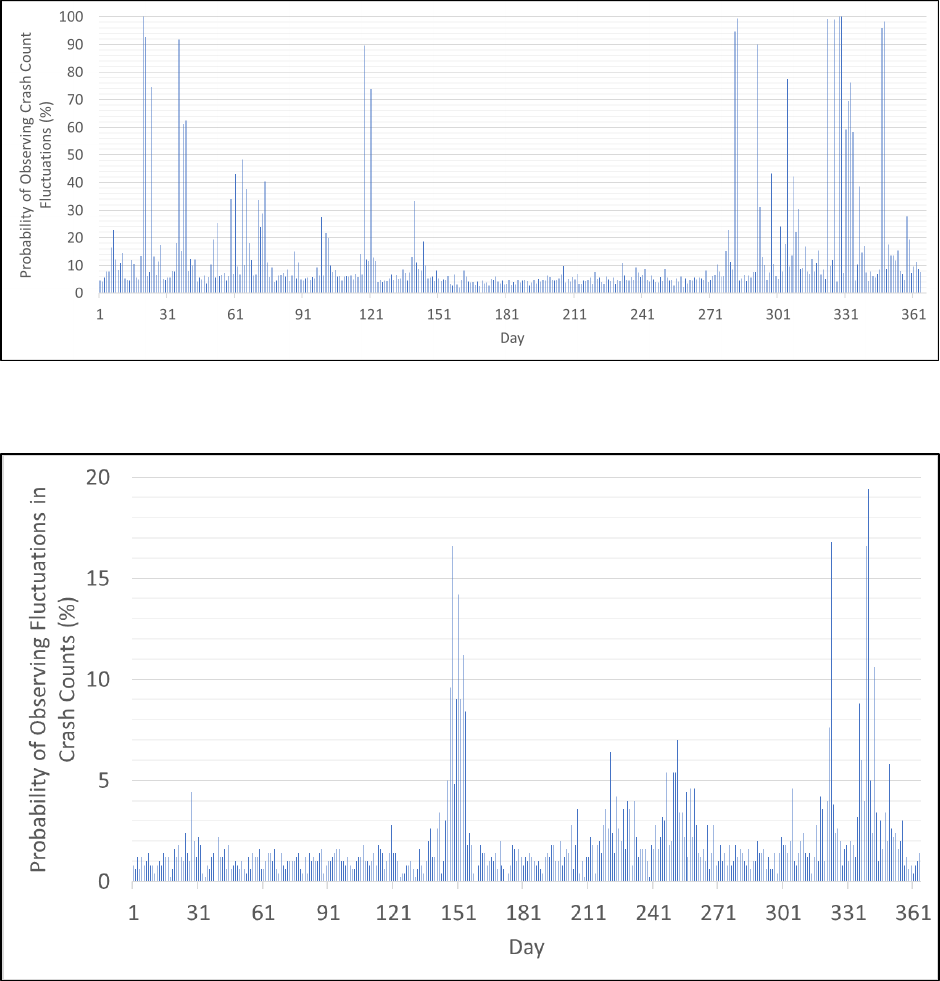
115
The bcp package of R (Wang et al., 2018) was employed to evaluate such fluctuations. It
implements Markov chain Monte Carlo analyses. Details of the package’s procedure are
available in Wang et al. (2018). The analysis results are presented in Figures 132 through 140.
Figure 132: Estimated probabilities of observing fluctuations in crash counts throughout
2019.
Figure 133: Estimated probabilities of observing fluctuations in counts of fatal, suspected
serious injury and suspected minor injury crashes throughout 2019.

116
Figure 134: Estimated probabilities of observing fluctuations in counts of crashes involving
improper or non-use of safety restraints throughout 2019.
Figure 135: Estimated probabilities of observing fluctuations in counts of speed related
crashes throughout 2019.

117
Figure 136: Estimated probabilities of observing fluctuations in counts of adverse weather
related crashes throughout 2019.
Figure 137: Estimated probabilities of observing fluctuations in counts of animal crashes
throughout 2019.
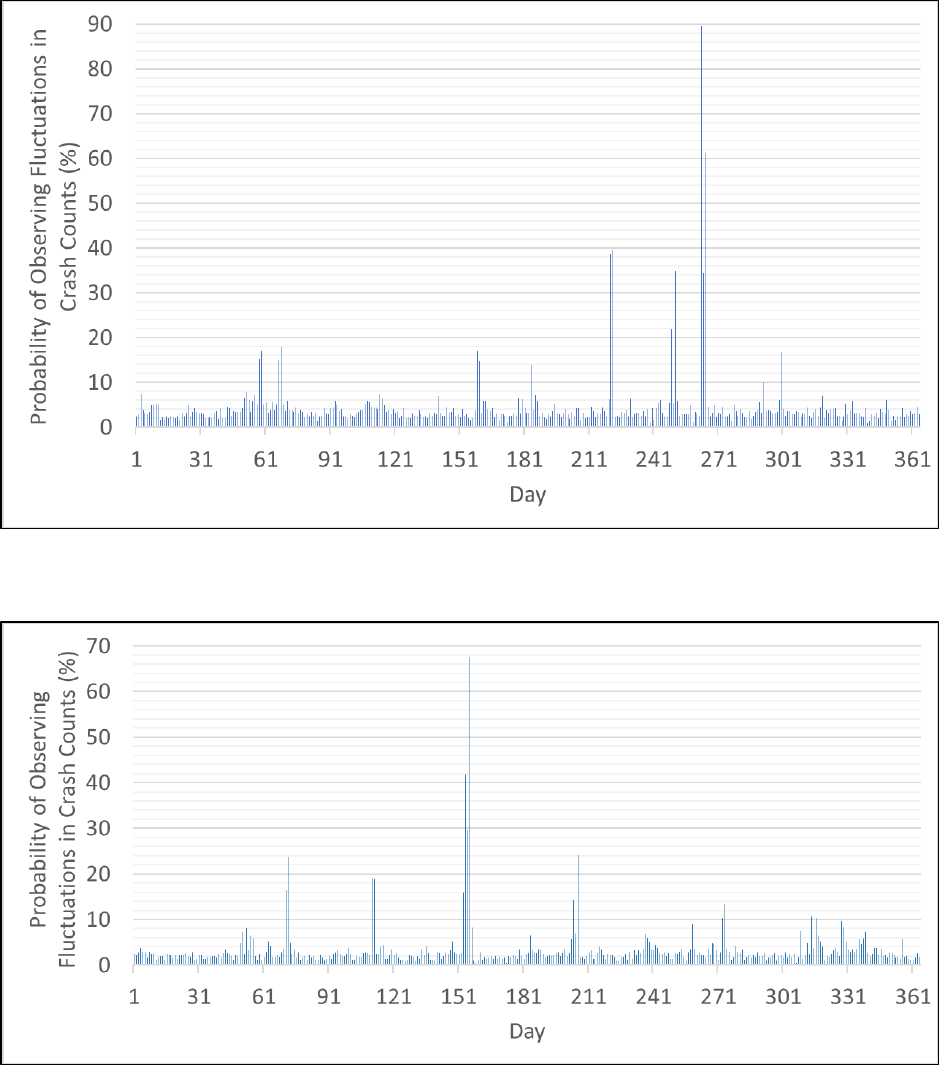
118
Figure 138: Estimated probabilities of observing fluctuations in counts of driving under the
influence crashes throughout 2019.
Figure 139: Estimated probabilities of observing fluctuations in counts of non-motorist
crashes throughout 2019.

119
Figure 140: Estimated probabilities of observing fluctuations in counts of motorcycle
crashes throughout 2019.
As shown in Figure 132, there were large estimated probabilities of observing fluctuations in
crash counts except for the period between June and September. As previously stated, the
recommendation is to report crashes, regardless of type, at the earliest convenience to WHP,
WASCOP and the counties.
When it comes to fatal, suspected serious injury and suspected minor injury crashes (Figure 133),
changes in their observed frequencies from one day to the other did not exceed 20 percent,
indicating a steady trend. Similar to the case of total crashes, sharing data of fatal, suspected
serious injury and suspected minor injury crashes to WHP, WASCOP and the counties as soon as
they are ready for circulation is satisfactory.
The trends of crashes in which citations were issued for improperly buckling up or not buckling
up had high estimated likelihoods of fluctuating on a day-to-day basis for multiple months as
shown in Figure 134. Hence, it is suggested that data of crashes involving improper use or non-
use of safety restraints be provided to the Wyoming Seat Belt Coalition as soon as they are
prepared for dissemination. This suggestion is consistent with that provided according to the
inferences drawn from the WSBC survey results.
Speeding related crashes exhibited varying trends. The counts of such crashes would fluctuate
intermittently except for the period May to September as shown in Figure 135. Reporting speed
related crashes to WHP, WASCOP and Wyoming’s counties at the earliest convenience is
recommended.
120
Adverse weather related crash patterns were likely to vary erratically except for the months, June
to August, as shown in Figure 136. It is suggested that data of such crashes be shared with WHP,
WASCOP and the counties as soon as they are ready for circulation.
Animal crash trends exhibited a low probability of fluctuation except during October and
November (Figure 137). The delivery of animal crash data to WHP, WASCOP and Wyoming’s
counties as soon as practically possible, especially during this period, is recommended.
Concerning DUI related crashes, the trends of DUI related crashes had low likelihoods of
constantly fluctuating as shown in Figure 138. Thus, disseminating data of those crashes to
WHP, WASCOP, the counties and GCID as promptly as potentially possible is recommended.
This recommendation is consistent with those provided according to the interpretations of the
corresponding survey results.
Pedestrian and bicycle crash trends exhibited a low probability of continuously oscillating within
a week (Figure 139). As previously stated, the surveys’ results indicated that it is best to deliver
crash data to WHP, WASCOP and Wyoming’s counties as rapidly as practically possible.
According to the results of the WBPSTF survey, it is also suggested that the WYDOT HSO
share its non-motorist crash data to WBPSTF as soon as the data become available.
Unlike non-motorist crash patterns, those of motorcycles were predisposed to vary intermittently
from one day to the other. As such, providing motorcycle crash data to WHP, WASCOP,
Wyoming’s counties and motorcycle groups as promptly as potentially possible is a
recommended course of action.
121
CHAPTER 5: CONCLUSIONS AND RECOMMENDATIONS
Ultimately, this study was aimed at assessing the road safety data needs of WYDOT’s partner
groups, which are the Wyoming Seat Belt Coalition, the Wyoming Highway Patrol, the
Wyoming Association of Sheriffs and Chiefs of Police, the Wyoming Transportation Safety
Coalition, the Governor’s Council on Impaired Driving, Wyoming’s counties, the Wyoming
Bicycle and Pedestrian System Task Force and motorcycle groups in the state. Even though the
aforementioned groups already receive data from WYDOT either in the form of summary
statistics documented in reports or database files, there was a dire need to assess the groups’ data
requirements. This was to inquire about the quality of the data, especially when it comes to crash
data reporting time frames and gaps in reporting. Surveys were drafted and disseminated to those
groups seeking information on their data needs. The surveys were collected and their results
were inferred in order to suggest recommendations for WYDOT regarding road safety data
reporting. In particular, the recommendations pertained to specific data elements to be reported,
crash data reporting intervals and appropriate formats for presenting the data. Once WYDOT
would implement the recommendations, its partners would have access to comprehensive data
delivered to them in a timely manner and thus would be able to achieve their objectives
efficiently.
Suggestions made for WYDOT include the provision of the following data for WHP, WASCOP
and Wyoming’s counties:
• Crash statistics by crash type
• Crash injury severity levels statistics by age/gender
• Seat belt use statistics
• DUI statistics
• Fatigued driving related crash statistics
• Distracted driving related crash statistics
• Traffic violation statistics
• Truck policy violation statistics
• Crash statistics by weather condition
• Crash statistics by lighting condition
• Crash statistics by day of the week
• Crash statistics by time of day
• Motorcycle crash statistics
• Hot spots by crash severity level and description (seat belt improper use or non-use,
CMV related, etc.)
Other noteworthy suggestions entail the planning for research studies relating to the following
topics:
• Effectiveness of speed, seat belt use and other violation enforcement policies
122
• Effectiveness of traffic safety educational campaigns
• Response times of emergency services, particularly for fatal, suspected serious injury
and suspected minor injury crashes
For the other groups, the Wyoming Seat Belt Coalition, Wyoming Transportation Safety
Coalition, Governor’s Council on Impaired Driving, Wyoming Bicycle and Pedestrian System
Task Force and the motorcycle groups, the recommendations are similar. Yet, they are tailored to
seat belt use, truck safety, impaired driving, non-motorist safety and motorcycle safety,
respectively. Human factors influencing crash severity, including driving under the influence,
leaving the crash scene, distracted driving, the involvement of a young driver aged 20 or below,
the involvement of an elderly driver aged 61 or above, the involvement of a female driver,
improper or non-use of safety restraints, speeding and reckless driving were investigated using
two techniques. They were the logistic regression framework and the random forest data mining
method. Most of those parameters were found to be influential except for speeding, reckless
driving and distracted driving. Furthermore, an analysis was conducted to gauge fluctuations in
crash trends. With that, road safety data sharing time frames were suggested. Finally, it is
anticipated that WYDOT not only implement the aforementioned recommendations but also
develop a strategy to conduct follow-up studies on the aforementioned suggested research topics
(e.g. effectiveness of traffic safety educational campaigns, etc.).
123
REFERENCES
Abellán, J., López, G., de Oña, J., 2013. Analysis of Traffic Accident Severity Using Decision
Rules via Decision Trees. Expert Systems with Applications 40 (15), 6047-6054.
https://doi.org/10.1016/j.eswa.2013.05.027
Abdel-Aty, M., Abdelwahab, H., 2004. Predicting Injury Severity Levels in Traffic Crashes: A
Modeling Comparison. American Society of Civil Engineers Journal of Transportation
Engineering 130 (2), 204-210. https://doi.org/10.1061/(ASCE)0733-
947X(2004)130:2(204)
Albany County Wyoming, 2021. Departments. Albany County Wyoming.
https://www.co.albany.wy.us/35/Departments. Accessed May 25, 2020.
American Association of State Highway and Transportation Officials, 2010. Highway Safety
Manual. American Association of State Highway and Transportation Officials,
Washington, D.C.
Amiri, A., Sadri, A., Nadimi, N., Shams, M., 2020. A Comparison between Artificial Neural
Network and Hybrid Intelligent Genetic Algorithm in Predicting the Severity of Fixed
Object Crashes among Elderly Drivers. Accident Analysis & Prevention 138, 105468.
https://doi.org/10.1016/j.aap.2020.105468
Australian Transport Council, 2008. National Road Safety Action Plan 2009 and 2010.
Australian Transport Council, Australia.
Braitman, K., Kirley, B., McCartt, A., Chaudhary, N., 2008. Crashes of Novice Teenage Drivers:
Characteristics and Contributing factors. Journal of Safety Research 39, 47–54.
https://doi.org/10.1016/j.jsr.2007.12.002
Breiman, L., Cutler, A., Liaw, A., Wiener, M., 2018. Breiman and Cutler’s Random Forests for
Classification and Regression. https://cran.r-
project.org/web/packages/randomForest/randomForest.pdf. Accessed August 6, 2021.
Carlson, M., Wiggins, J., Rutter, J., Collins, P., Young, T., Emery, A., Greenman, A., Harrist, A.,
Bravo, D., Caldwell, P., Koehler, J., Hellyer, J., Venable, G., 2018. Wyoming Bicycle and
Pedestrian System Task Force Report 2018. Wyoming Bicycle and Pedestrian System
Task Force, Wyoming.
Chang, L.-Y., Chien, J.-T., 2013. Analysis of Driver Injury Severity in Truck-Involved
Accidents Using a Non-Parametric Classification Tree Model. Safety Science 51 (1), 17-
22. https://doi.org/10.1016/j.ssci.2012.06.017
Chen, C., Zhang, G., Qian, Z., Tarefder, R., Tian, Z., 2016. Investigating Driver Injury Severity
Patterns in Rollover Crashes Using Support Vector Machine Models. Accident Analysis
& Prevention 90, 128-139. https://doi.org/10.1016/j.aap.2016.02.011
124
Delen, D., Sharda, R., Bessonov, M., 2006. Identifying Significant Predictors of Injury Severity
in Traffic Accidents Using a Series of Artificial Neural Networks. Accident Analysis &
Prevention 38 (3), 434-444. https://doi.org/10.1016/j.aap.2005.06.024
Delucia, B., Scopatz, R., 2005. National Cooperative Highway Research Program Synthesis 350
– Crash Records Systems: A Synthesis of Highway Practice. National Cooperative
Highway Research Program, Transportation Research Board of the National Academy of
Sciences, Engineering, and Medicine, Washington, D.C.
Dingus, T., Guo, F., Lee, S., Antin, J., Perez, M Buchanan-King, M., Hankey, J., 2016. Driver
Crash Risk Factors and Prevalence Evaluation Using Naturalistic Driving Data.
Proceedings of the National Academy of Sciences of the United States of America 113
(10) 2636-2641. https://doi.org/10.1073/pnas.1513271113
Environmental Systems Research Institute, 2016. ArcMap 10.4. Environmental Systems
Research Institute, West Redlands, California.
Fernsler, K., 2019. Wyoming Seat Belt Survey. Wyoming State Government, Cheyenne,
Wyoming.
Gordon, M., Carlson, M., James, K., 2021. Wyoming Highway Safety Behavioral Grants
Program FY2021 Highway Safety Plan. Wyoming Highway Safety Behavioral Grants
Program, Wyoming Department of Transportation, Cheyenne, Wyoming.
Governor’s Council on Impaired Driving, 2019. Welcome. Governor’s Council on Impaired
Driving, Wyoming. http://www.wygcid.org/home.html. Accessed May 25, 2021.
Holdridge, J., Shankar, V., Ulfarsson, G., 2005. The Crash Severity Impacts of Fixed Roadside
Objects. Journal of Safety Research 36 (2), 139-147.
https://doi.org/10.1016/j.jsr.2004.12.005
Imprialou, M.-I., Quddus, M., Pitfield, D., Lord, D., 2016. Re-Visiting Crash–Speed
Relationships: A New Perspective in Crash Modelling. Accident Analysis & Prevention
86, 173–185. https://doi.org/10.1016/j.aap.2015.10.001
Insurance Information Institute, 2021. Facts + Statistics: Aggressive Driving.
https://www.iii.org/fact-statistic/facts-statistics-aggressive-driving. Accessed August 6,
2021.
Insurance Institute for Highway Safety, 2021. Fatality Facts 2019 Males and Females. Insurance
Institute for Highway Safety, Arlington, Virginia. https://www.iihs.org/topics/fatality-
statistics/detail/males-and-females. Accessed August 5, 2021.
Insurance Institute for Highway Safety, 2021. Fatality Facts 2019 State by State: Fatal Crash
Totals. Insurance Institute for Highway Safety, Arlington, Virginia.
125
https://www.iihs.org/topics/fatality-statistics/detail/state-by-state. Accessed May 24,
2021.
Insurance Institute for Highway Safety, 2021. Fatality Facts 2019 State by State: Restraint Use.
Insurance Institute for Highway Safety, Arlington, Virginia.
https://www.iihs.org/topics/fatality-statistics/detail/state-by-state. Accessed May 24,
2021.
James, G., Witten, D., Hastie, T., Tibshirani, R., 2013a. An Introduction to Statistical Learning
with Applications in R. Springer, New York City, New York.
James, G., Witten, D., Hastie, T., Tibshirani, R., 2013b. Tree-Based Methods. In: An
Introduction to Statistical Learning with Applications in R. Springer, New York City,
New York., 303–336.
Kashani, A., Mohaymany, A., 2011. Analysis of the Traffic Injury Severity on Two-Lane, Two-
Way Rural Roads Based on Classification Tree Models. Safety Science 49 (10), 1314-
1320. https://doi.org/10.1016/j.ssci.2011.04.019
Khattak, A., Iranitalab, A., 2016. Safety Management System Needs Assessment. Report No.
SPR-M025. Nebraska Department of Roads, Lincoln, Nebraska.
Li, X., Lord, D., Zhang, Y., Xie, Y., 2008. Predicting Motor Vehicle Crashes Using Support
Vector Machine Models. Accident Analysis & Prevention 40 (4), 1611-1618.
https://doi.org/10.1016/j.aap.2008.04.010
Logan, M., McShane, P., 2006. Emerging Crash Trend Analysis. Proceedings of the
Australasian Road Safety Research, Policing and Education Conference 10. Clayton,
Victoria, Australia.
Lym, Y., Chen, Z., 2021. Influence of Built Environment on the Severity of Vehicle Crashes
Caused by Distracted Driving: A Multi-State Comparison. Accident Analysis &
Prevention 150, 105920. https://doi.org/10.1016/j.aap.2020.105920
Mitchell, R., Williamson, A., O’Connor, R., 2009. The Development of an Evaluation
Framework for Injury Surveillance Systems. BioMed Public Heath 9 (260).
https://doi.org/10.1186/1471-2458-9-260
Moghaddam, F., Afandizadeh, S., Ziyadi, M., 2011. Prediction of Accident Severity Using
Artificial Neural Networks. International Journal of Civil Engineering 9 (1), 41-48.
National Highway Traffic Safety Administration, 2017. Traffic Safety Facts 2015 Data:
Occupant Protection in Passenger Vehicles. Report Number DOT HS 812 374. National
Highway Traffic Safety Administration, U.S. Department of Transportation, Washington,
D.C.
126
National Highway Traffic Safety Administration, 2018. Traffic Safety Facts - Critical Reasons
for Crashes Investigated in the National Vehicle Crash Causation Survey. Report
Number DOT HS 812 506. National Highway Traffic Safety Administration, U.S.
Department of Transportation, Washington, D.C.
Rezapour, M., Ksaibati, K., 2021a. Hamiltonian Monte Carlo with Random Effect for Analyzing
Cyclist Crash Severity. Signals 2 (3), 527-539. https://doi.org/10.3390/signals2030032
Rezapour, M., Ksaibati, K., 2021b. Latent Class Model with Heterogeneous Decision Rule for
Identification of Factors to the Choice of Drivers’ Seat Belt Use. Computation 9 (4), 44.
https://doi.org/10.3390/computation9040044
Rezapour, M., Ksaibati, K., 2021c. Modeling Crashes Involving Children, Finite Mixture
Cumulative Link Mixed Model. International Journal of Injury Control and Safety
Promotion. https://doi.org/10.1080/17457300.2021.1964088
Rezapour, M., Wulff, S., Ksaibati, K., 2021. Truck Crashes and Potential Countermeasures on
Wyoming Highways and Interstates: Recommendations for All Responsible Agencies.
Journal of Transportation Safety & Security 13 (4), 436-459.
https://doi.org/10.1080/19439962.2019.1638477
SAS Institute, 2013. The Logistic Procedure. In: SAS/STAT 13.1 User’s Guide. SAS Institute,
Cary, North Carolina, 2013, 4486–4738.
Scopatz, B., Brown, R., Zhou, Y., Benac, J., Peach, K., Bryson, M., Lefler, N., 2017. Crash Data
Improvement Program Guide. Report Number DOT HS 812 419. National Highway
Traffic Safety Administration, U.S. Department of Transportation, Washington, D.C.
Stylianou, K., Dimitriou, L., Abdel-Aty, M., 2019. Big Data and Road Safety: A Comprehensive
Review. Mobility Patterns, Big Data and Transport Analytics - Tools and Applications
for Modeling 297-343. https://doi.org/10.1016/B978-0-12-812970-8.00012-9
United States Government Accountability Office, 2004. Highway Safety – Improved Monitoring
and Oversight of Traffic Data Program are Needed. Report Number GAO-05-24. United
States Government Accountability Office, Washington, D.C.
Vapnik, V., 1998. Statistical Learning Theory 1
st
Edition. John Wiley & Sons, Inc., New York
City, New York.
Wang, X., Erdman, C., Emerson, J., 2018. Package “bcp.” https://cran.r-
project.org/web/packages/bcp/bcp.pdf. Accessed August 6, 2021.
Washington, S., Karlaftis, M., Mannering, F., 2011. Logistic Regression. In: Statistical and
Econometric Methods for Transportation Data Analysis Second Edition. Chapman &
Hall/Chemical Rubber Company (CRC) Press, Taylor & Francis Group, Boca Raton,
Florida, 303-308.
127
World Health Organization, 2010. Data Systems A Road Safety Manual for Decision-Makers and
Practitioners. World Health Organization, Geneva, Switzerland.
Wyoming Association of Sheriffs and Chiefs of Police, 2021a. About Us. Wyoming Association
of Sheriffs and Chiefs of Police, Wyoming. https://www.wascop.com/about-us. Accessed
May 25, 2021.
Wyoming Association of Sheriffs and Chiefs of Police, 2021b. Alcohol and Crime in Wyoming.
Wyoming Association of Sheriffs and Chiefs of Police, Wyoming.
https://www.wascop.com/alcohol-and-crime-in-wyoming. Accessed May 25, 2021.
Wyoming Highway Patrol. 2019. Safety Education. Wyoming Highway Patrol, Cheyenne,
Wyoming. http://www.whp.dot.state.wy.us/home/safety_education.html. Accessed May
25, 2021.
Wyoming Transportation Safety Coalition, 2021. Welcome to the Wyoming Transportation
Safety Coalition. Wyoming Transportation Safety Coalition, Wyoming.
https://wyotsc.com/. Accessed May 25, 2021.
Yu, R., Abdel-Aty, M., 2014. Analyzing Crash Injury Severity for a Mountainous Freeway
Incorporating Real-Time Traffic and Weather Data. Safety Science 63, 50-56.
https://doi.org/10.1016/j.ssci.2013.10.012
Zeng, Q., Huang, H., 2014. A Stable and Optimized Neural Network Model for Crash Injury
Severity Prediction. Accident Analysis & Prevention 73, 351-358.
https://doi.org/10.1016/j.aap.2014.09.006
